Australian artist Ash Keating: Subversive abstract impressionist Action Painting
Beginnings in the suburban of Melbourne
The Australian artist Ash Keating was born in Melbourne in 1980. He grew up in the leafy eastern suburbs of Melbourne, half-way to the mountains Dandenong ranges. Ash started drawing as a child, and by 16 years of age he was painting abstract landscapes with oil on canvas at school. By the mid 90s he was well into basketball and hip hop music, then in the late 90s surrounded by friends that started graffiti writing around Melbourne. Curious he started writing some lettering with spray cans, but quickly knew that he was not interested in lettering, but he had fallen in love with the rush of painting illegally at night and seeing the results in bright colors the next day.
From 1999 to 2001 he painted dozens of characters alongside and with many writer friends from Box Hill to Mitcham on the Belgrave Lilydale line, and writer named LEMON/LEMZ who had a unique creative style took Keating under his wing and supported his abstract experiments on the line. Using spray cans, he started experimenting with color, spraying effects and was popping cans and realized he wanted to break rules of graffiti and work more organic and in an abstract way. It was then on a road trip to Canberra with LEMZ in 2001 that Keating painted the entire section under a bridge in a manner that would transform the way he approached painting. He painted the whole surface with a Gloss Black Enamel mis-tint and then popped bright yellow, orange and ultramarine blue Belton’s on top and was excited about the end result.
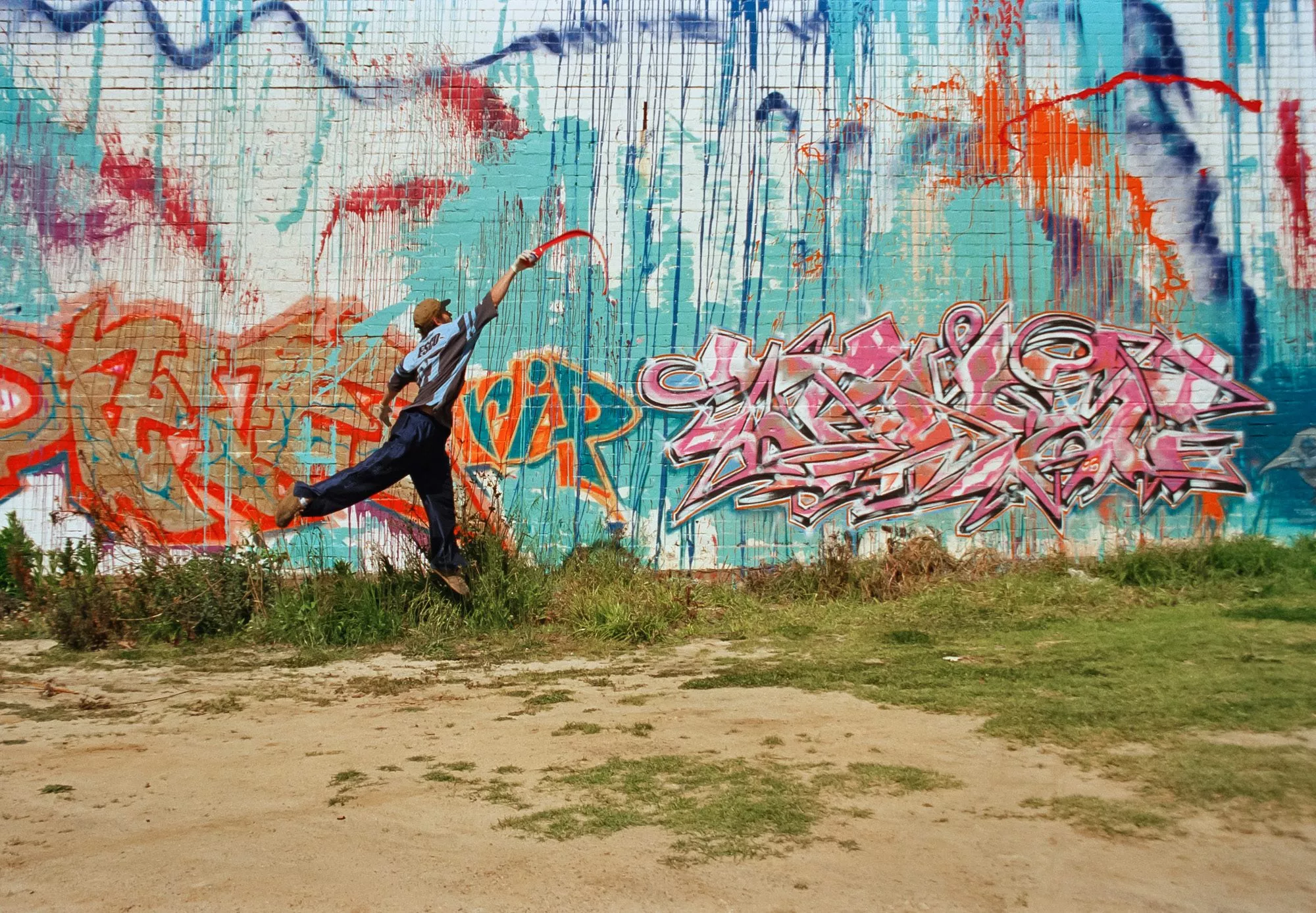
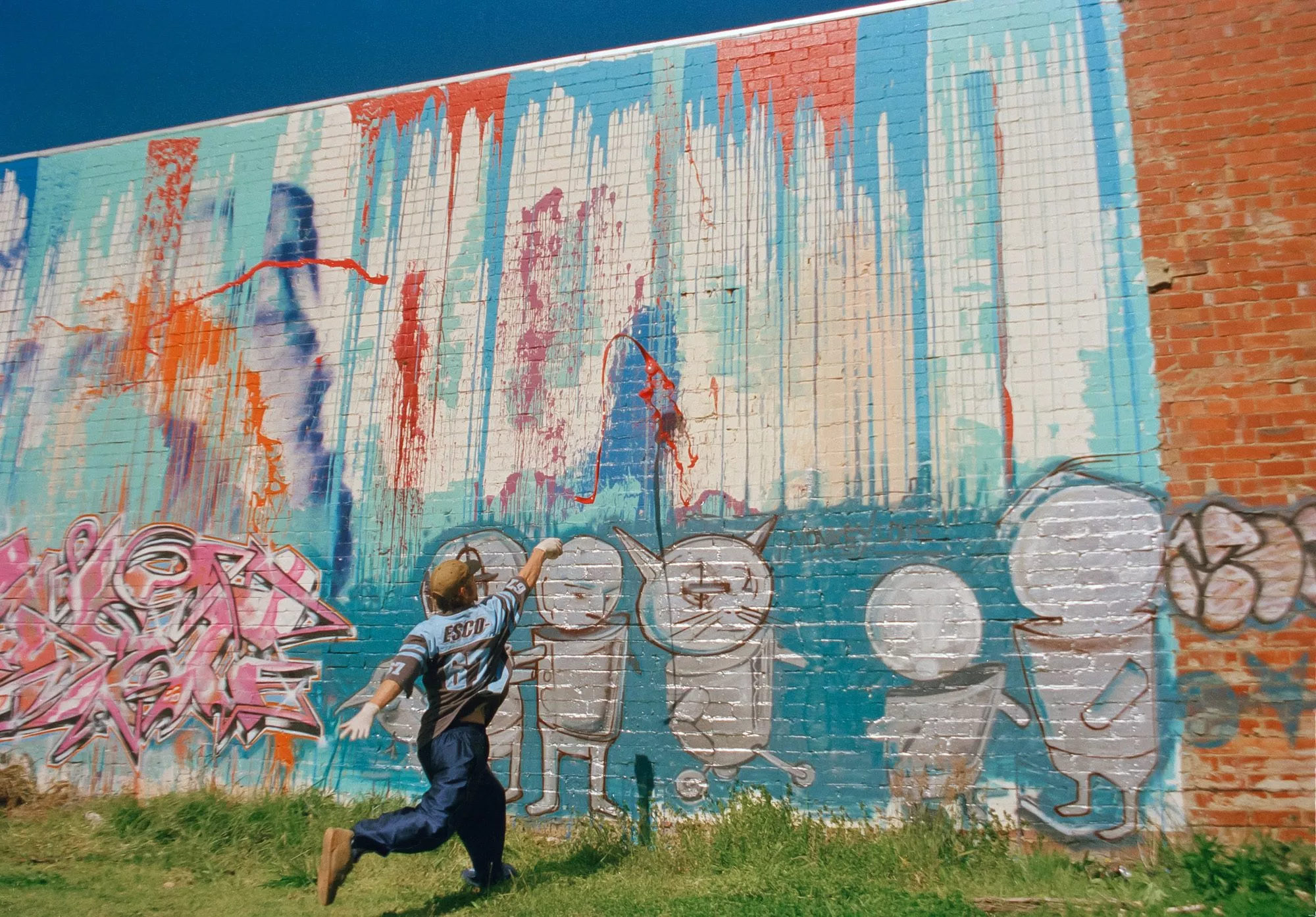
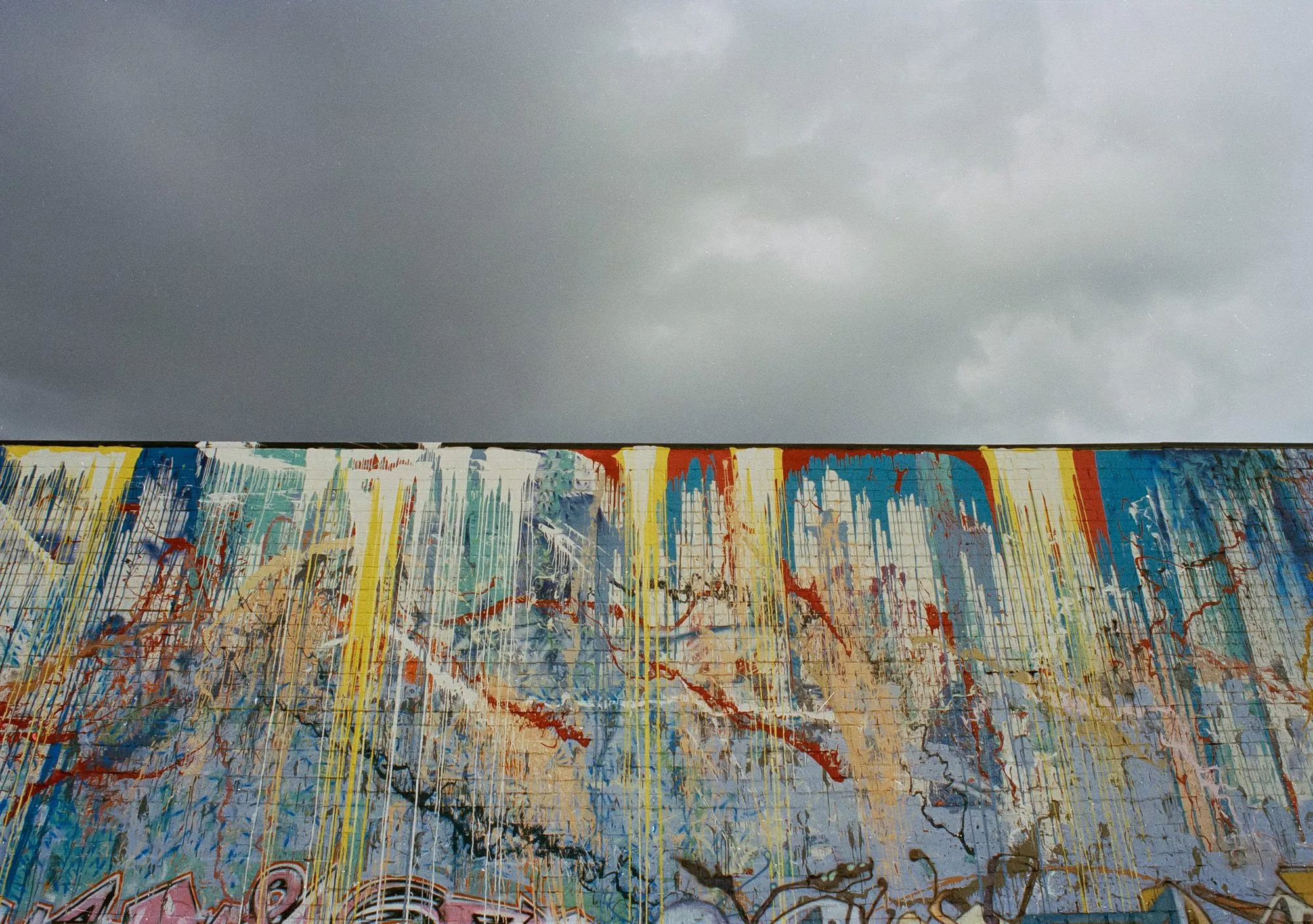
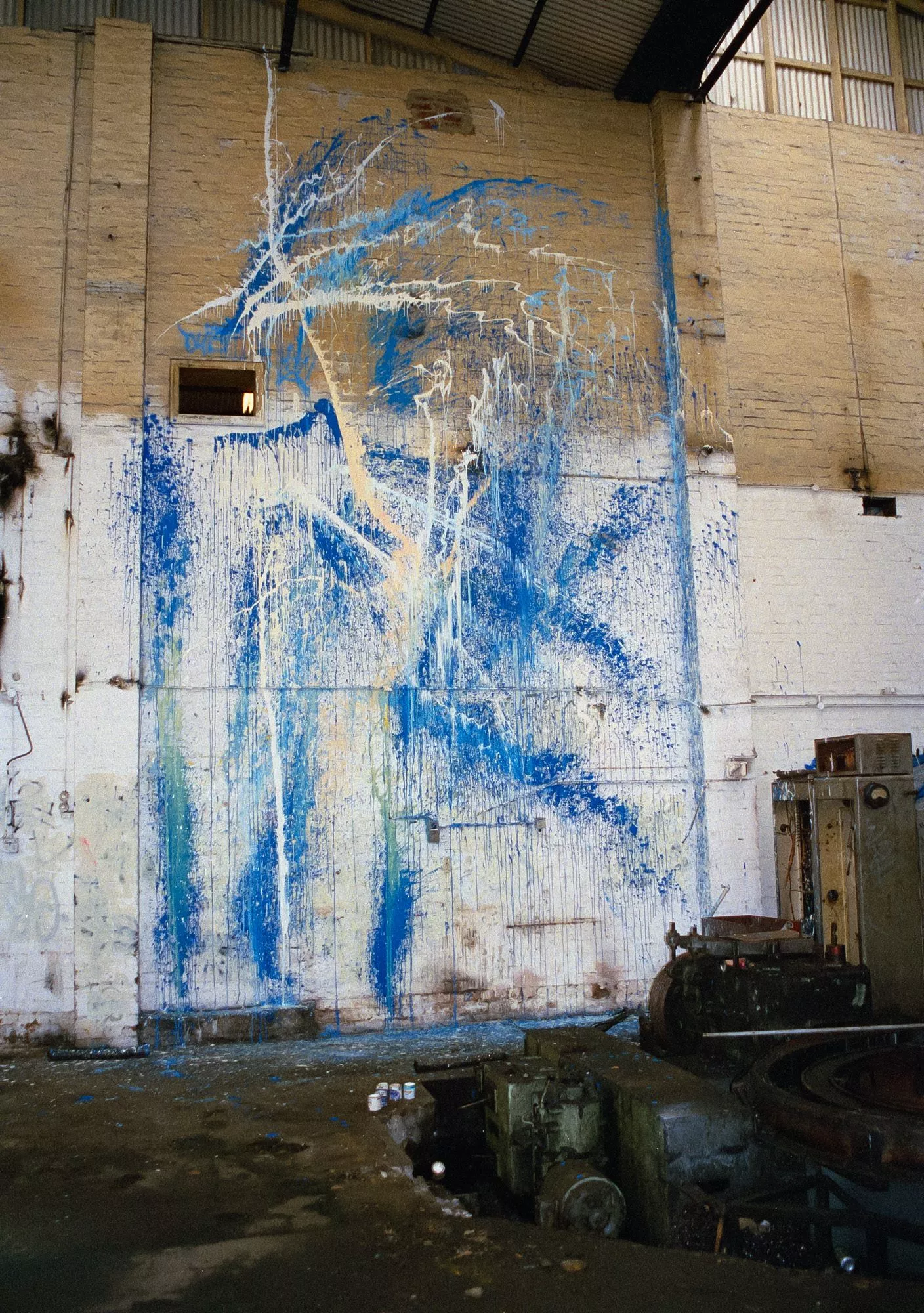
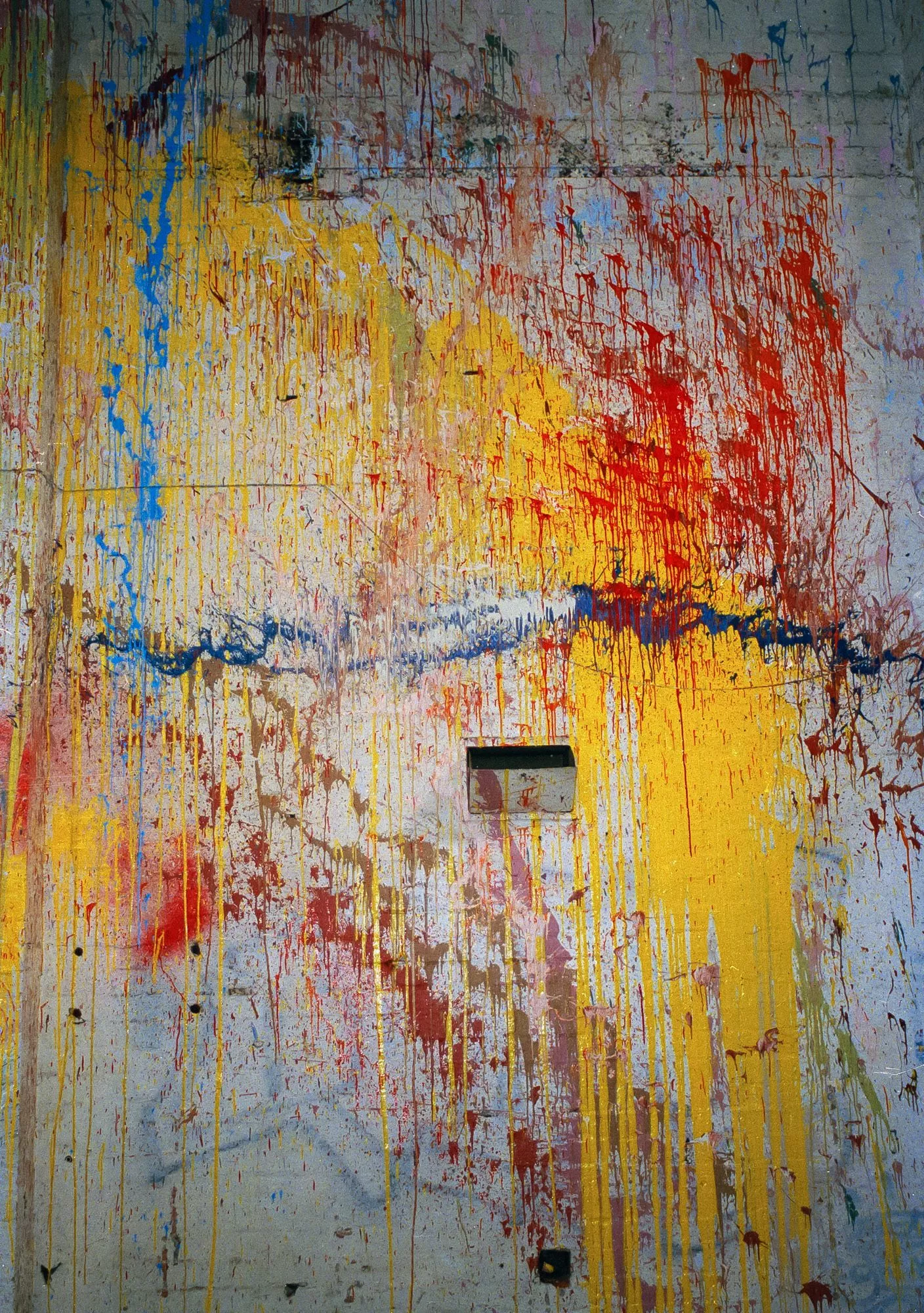
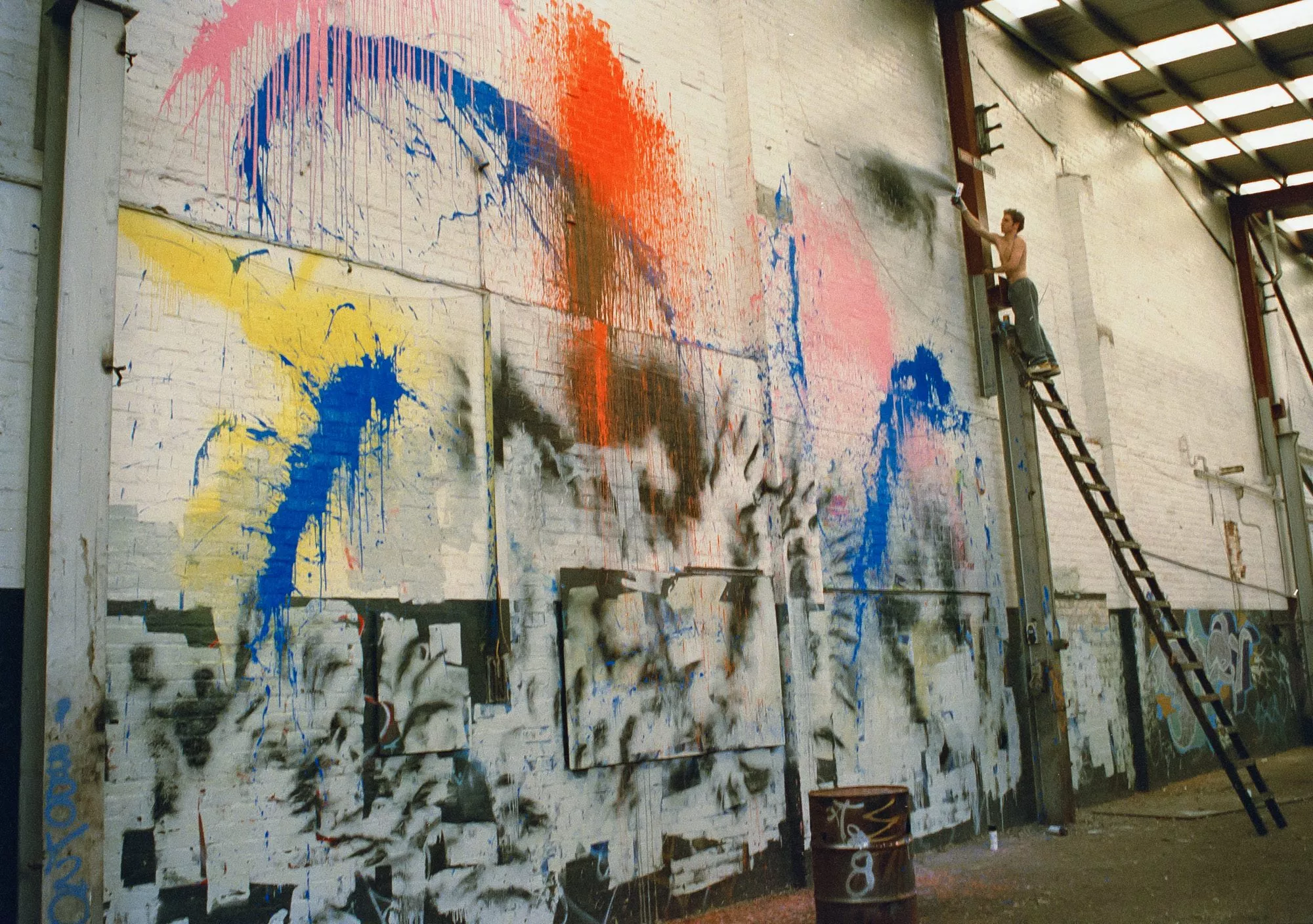
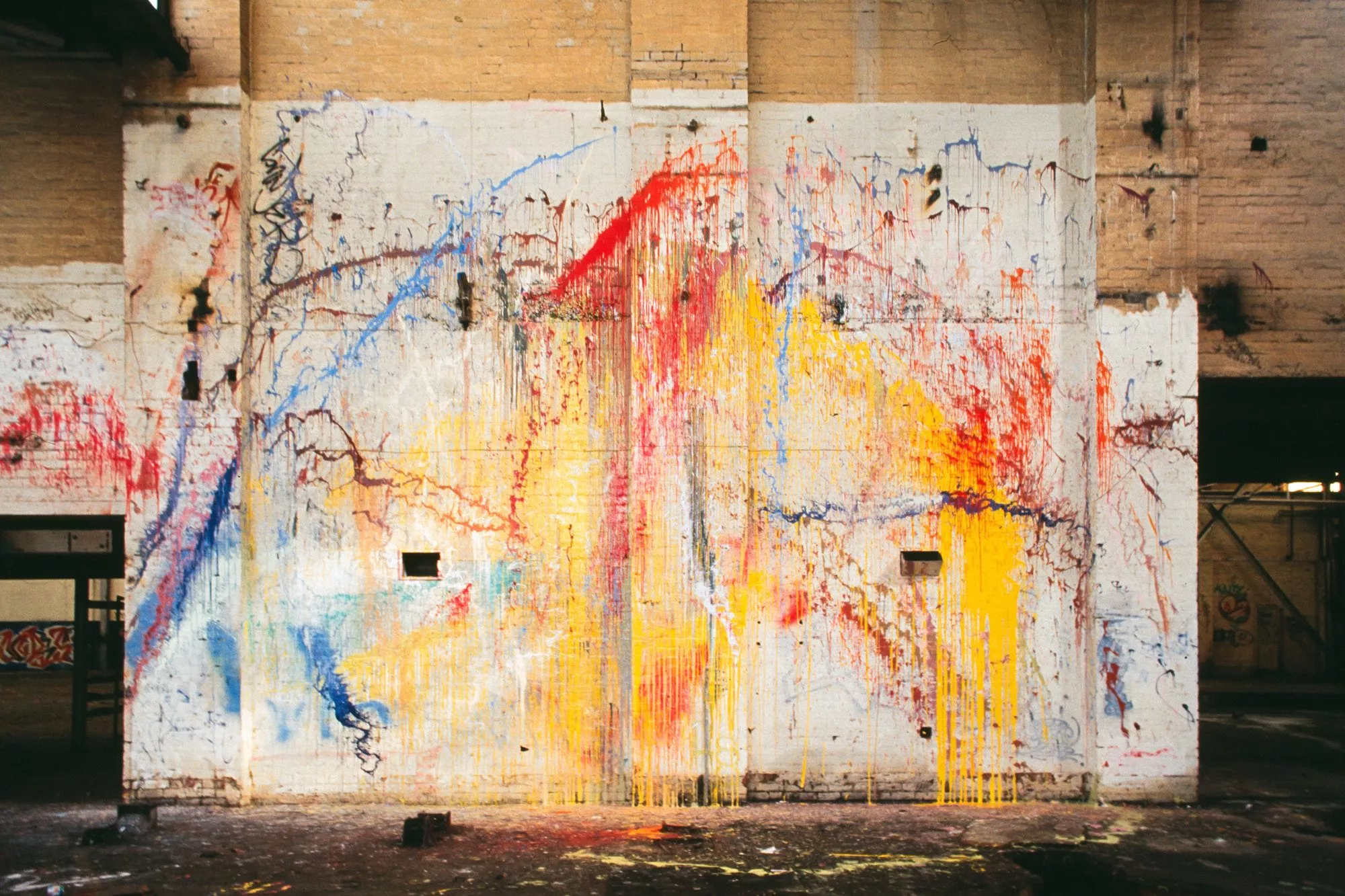
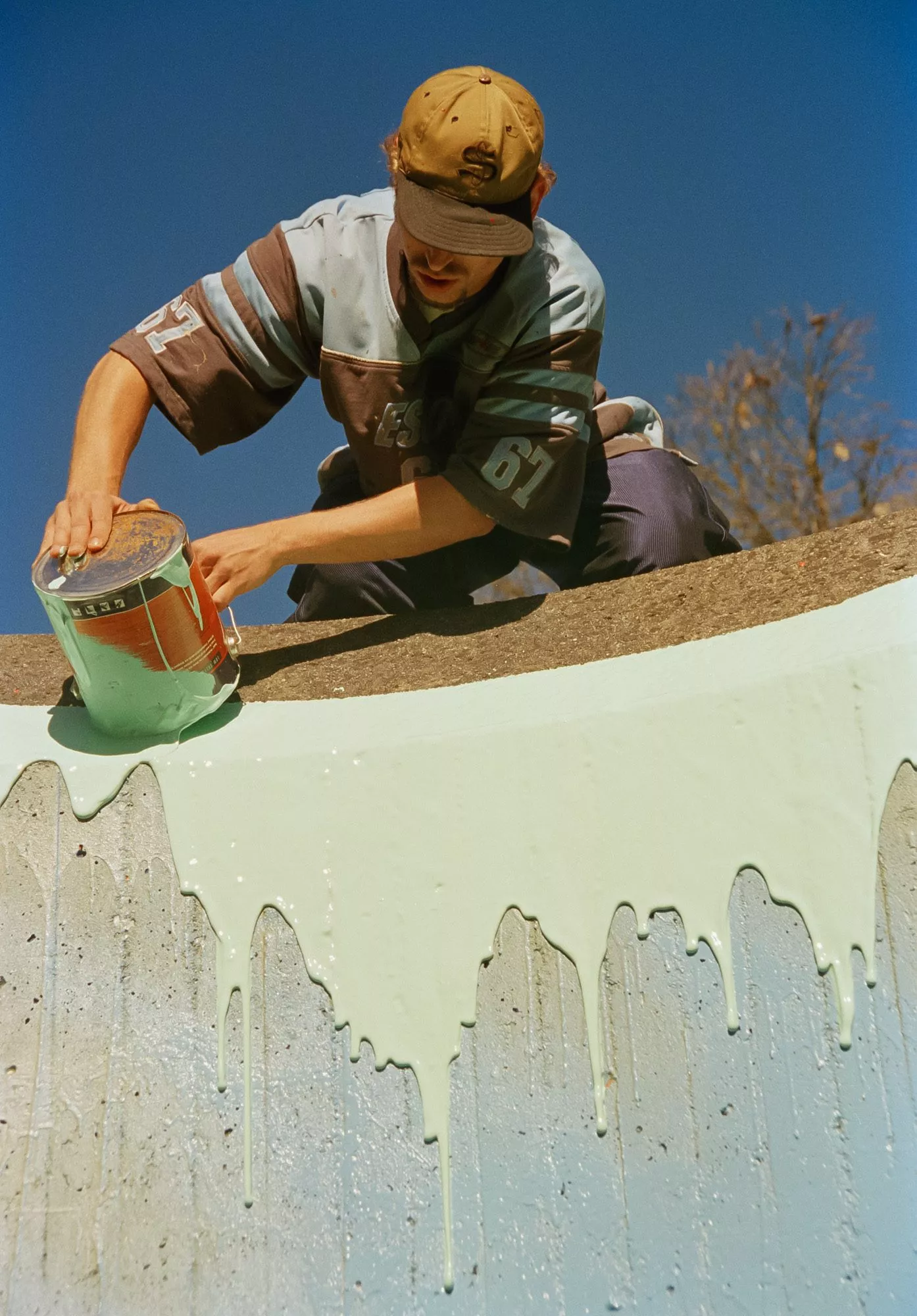
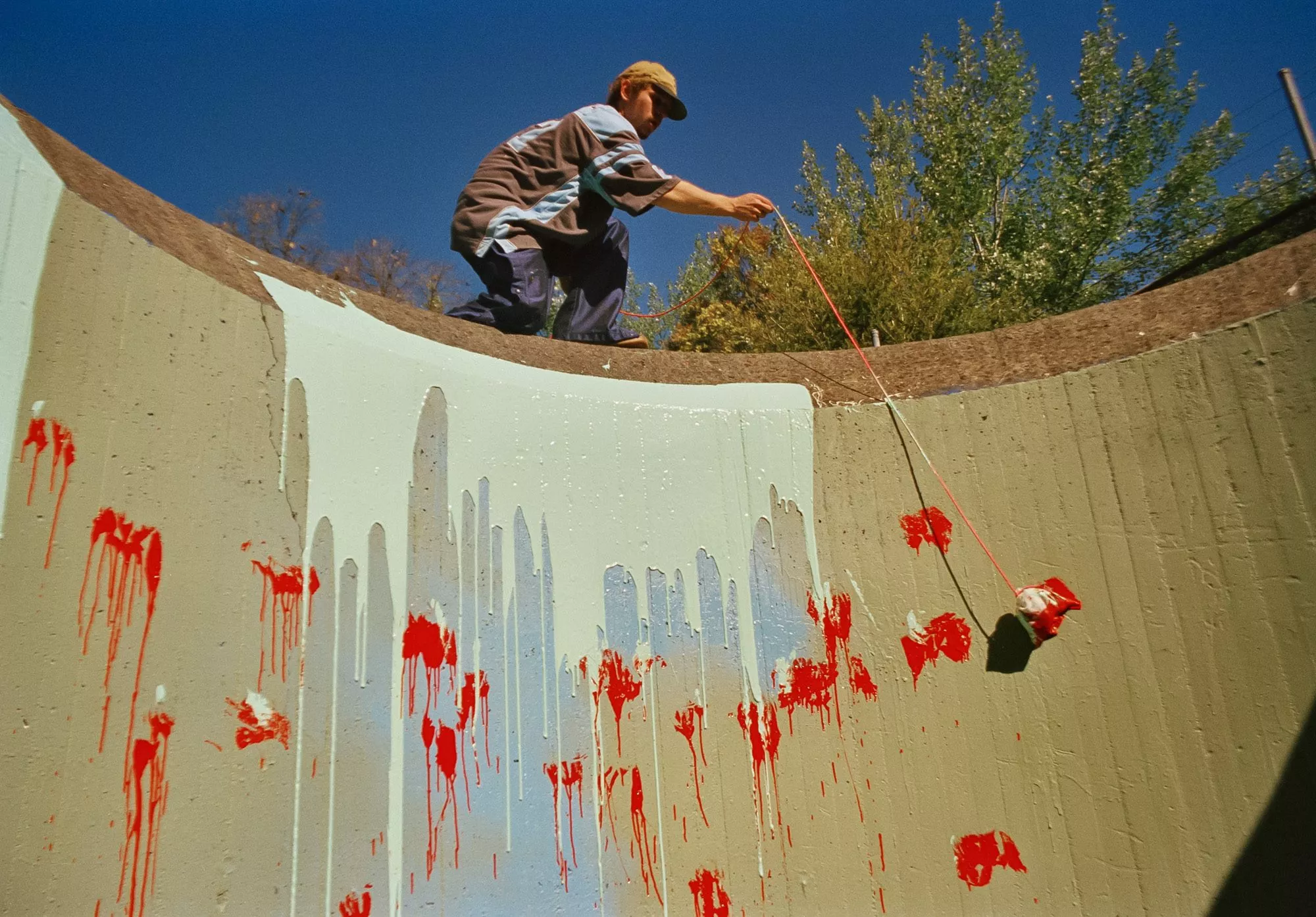
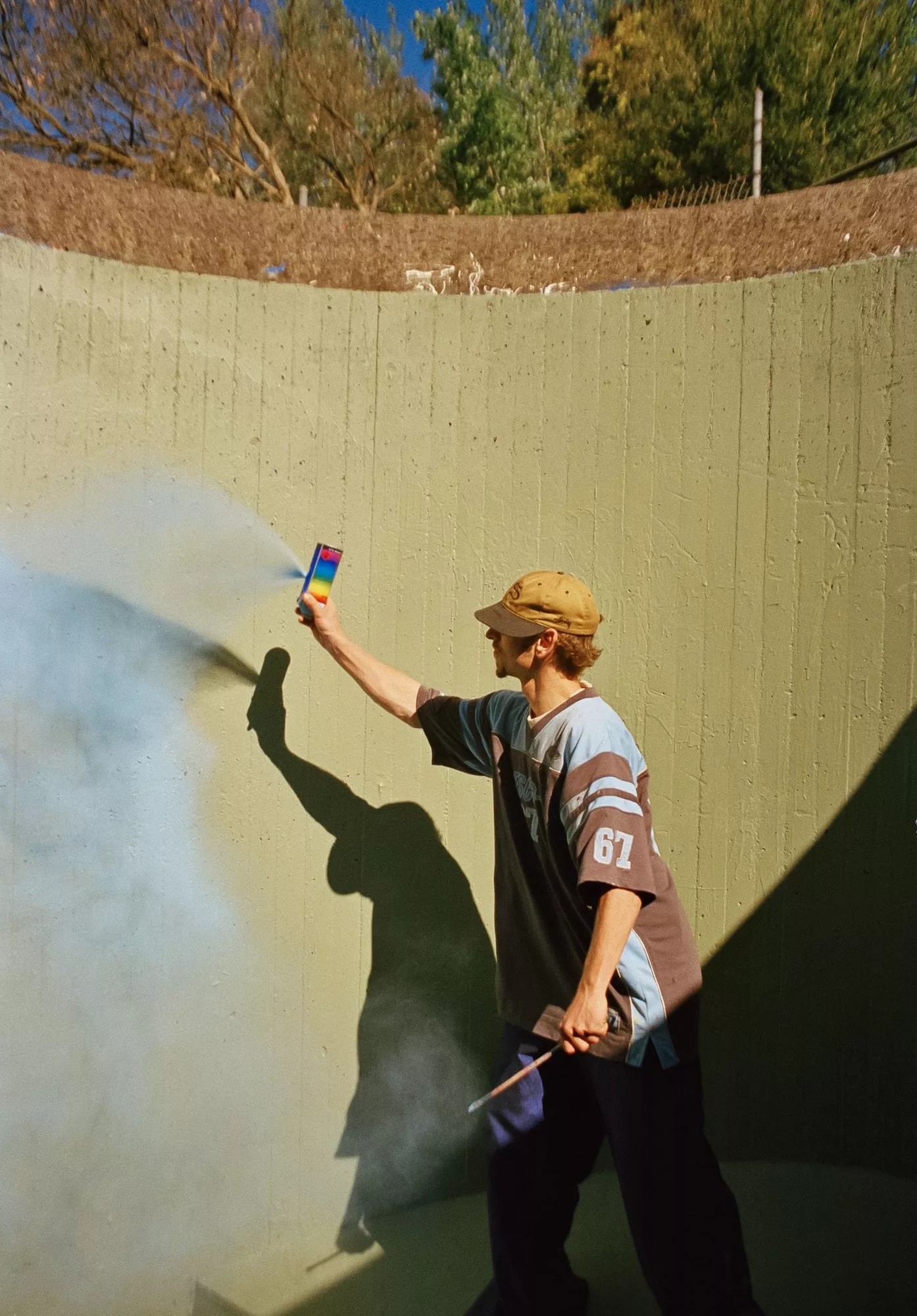
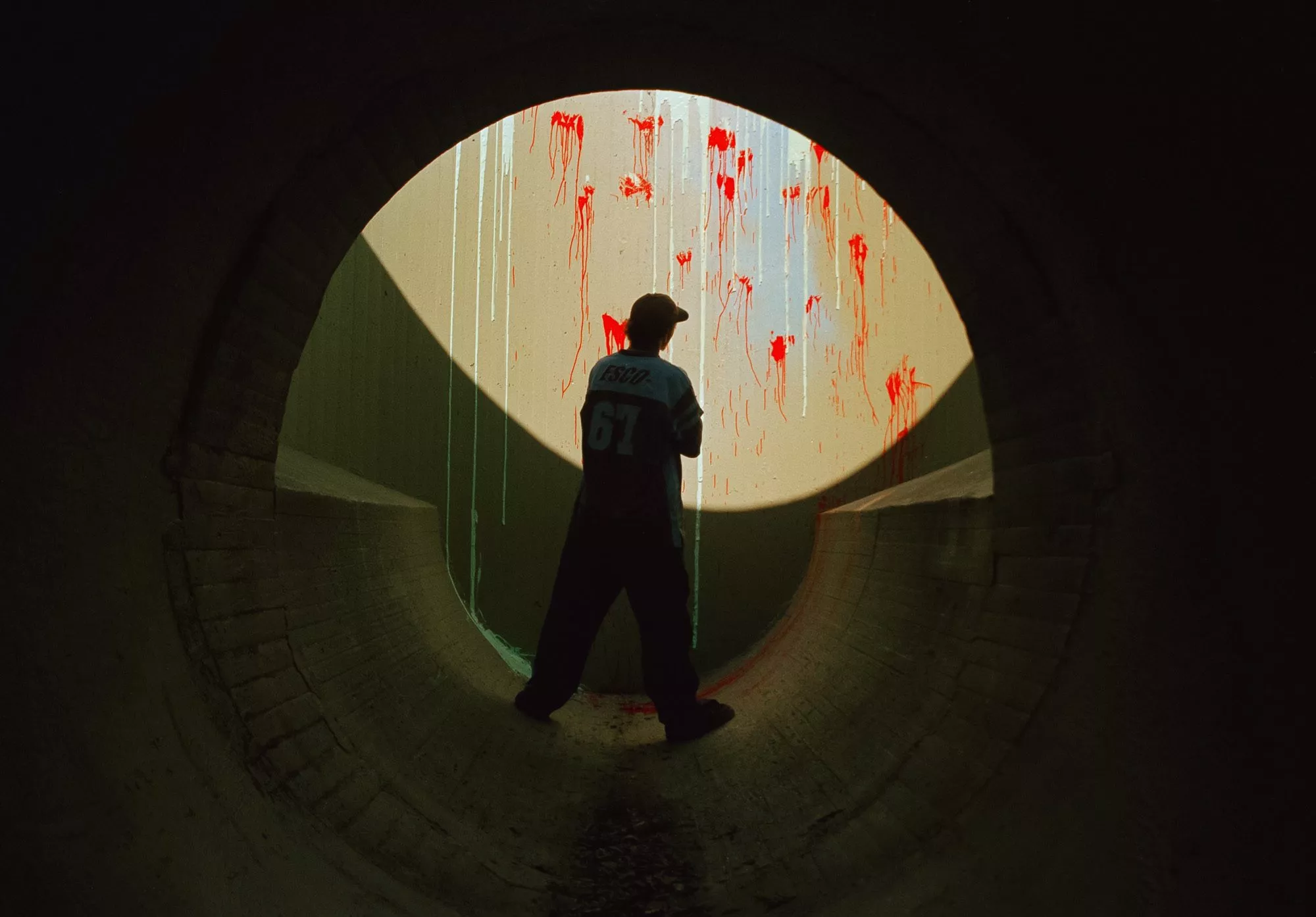
It was during this time Keating was studying Fine art at Monash University, Caulfield, where he undertook his Bachelor of Fine Art (Painting) from 2001 to 2003. At university, he painted expressive abstract works, mainly on found objects, timber palettes and then in final year he invested in some larger canvas to work on. In class, he was also taught art history, learning a lot about modern art and the extensive history of action painting. This knowledge reinforced Keating’s idea how to make his own abstract paintings in a performative and gestural way, which he had been doing with throwing pots and popping cans. He continued to make experiments with gestural abstract painting in public space with enamels and water-based paints, samples of different colors he got for free or that he found. He was going alone at night or in the early morning, throwing paint on walls, dripping paint from above and popping spray cans. He always worked really fast, only some minutes, and on occasion with some sites and locations he would return weekly to add to the layers of the works. For those subversive ‘guerrilla works’ he chose empty walls in prime locations in Melbourne’s CBD, where he moved in 2003. Living and making work in the city allowed him to be at the forefront of the emerging street art scene beginning of 2000s next to stencils and paste ups works by other artists. Banksy as well left some of his stencils of monkeys and rats in Melbourne in 2004.
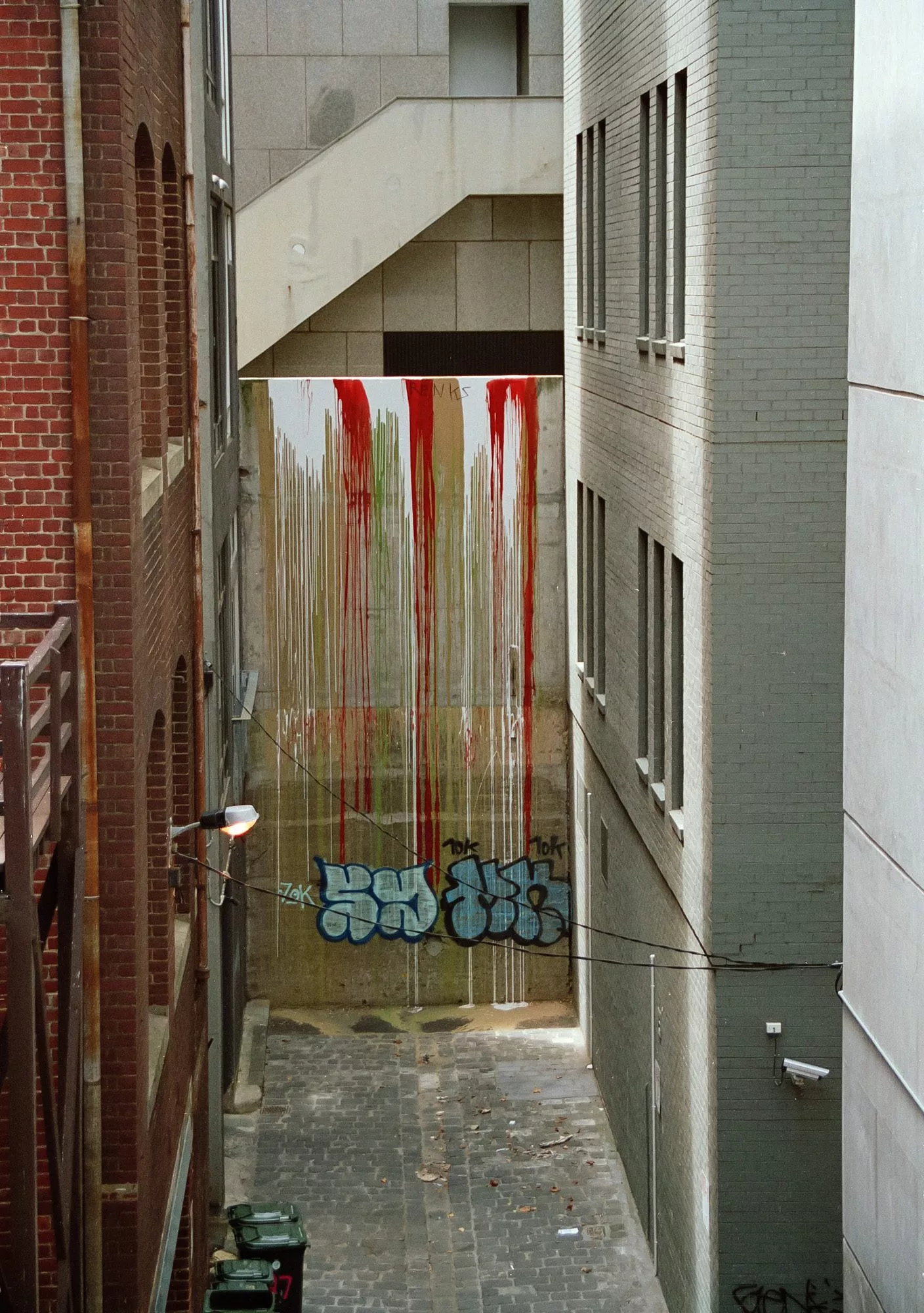
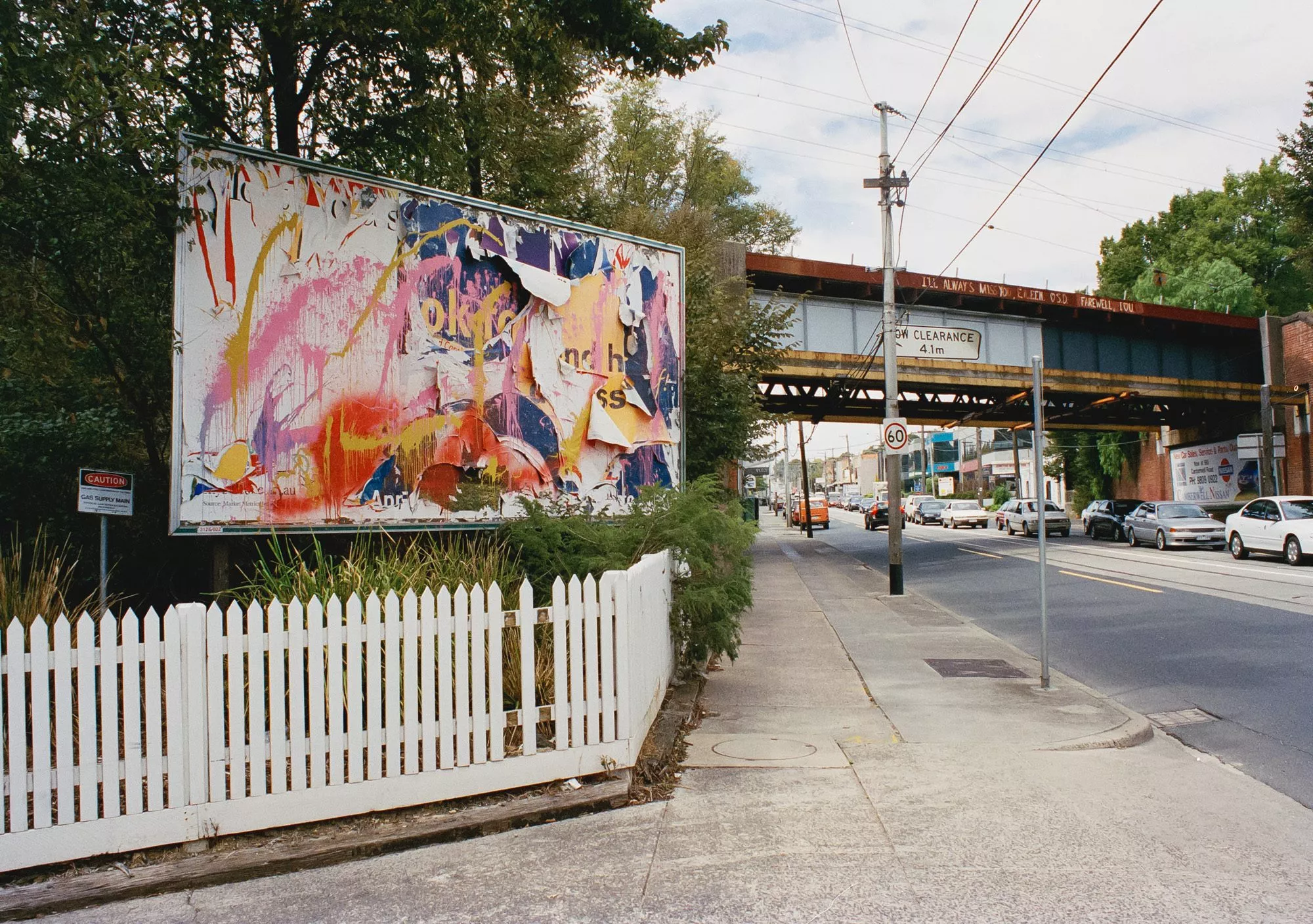
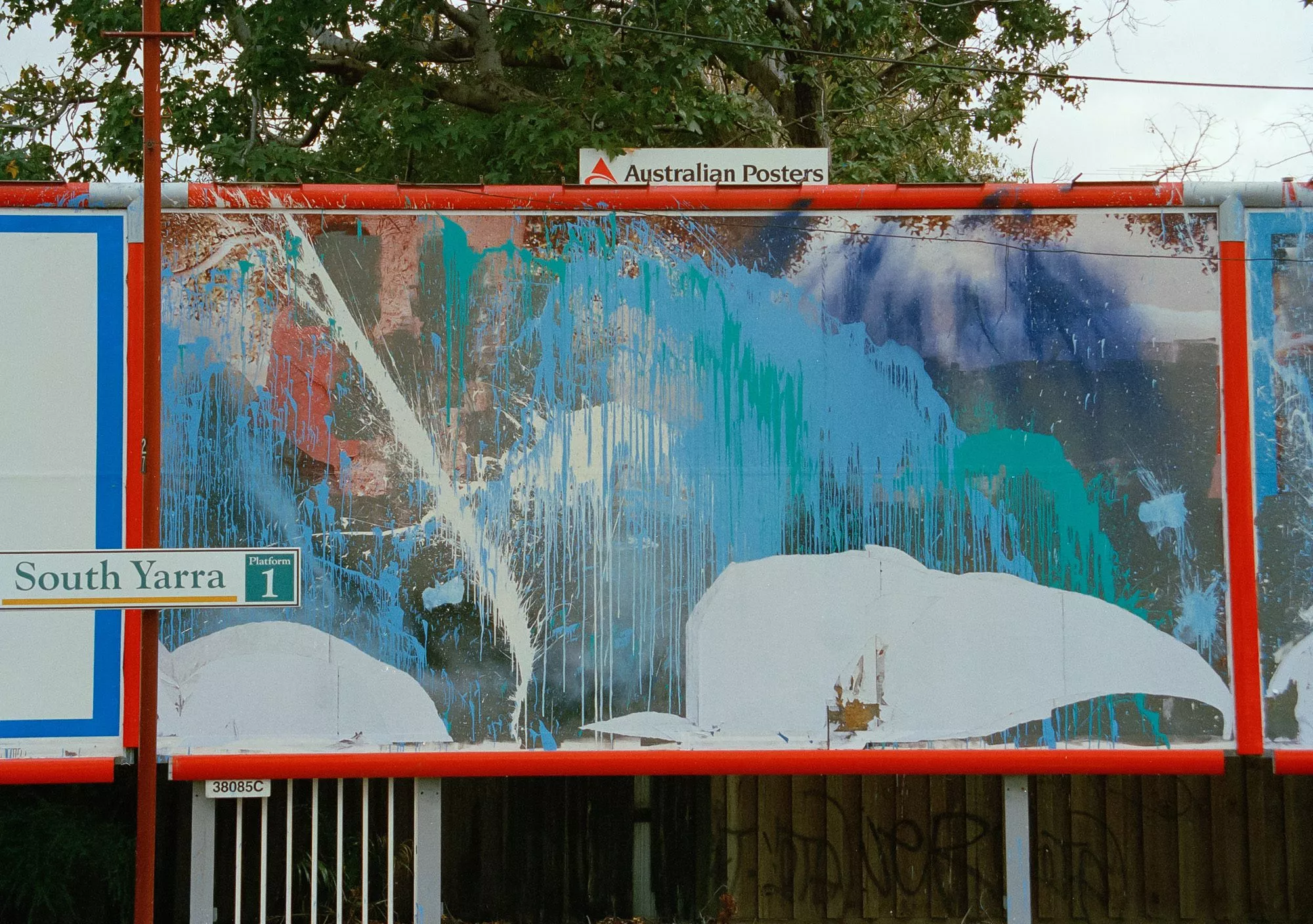
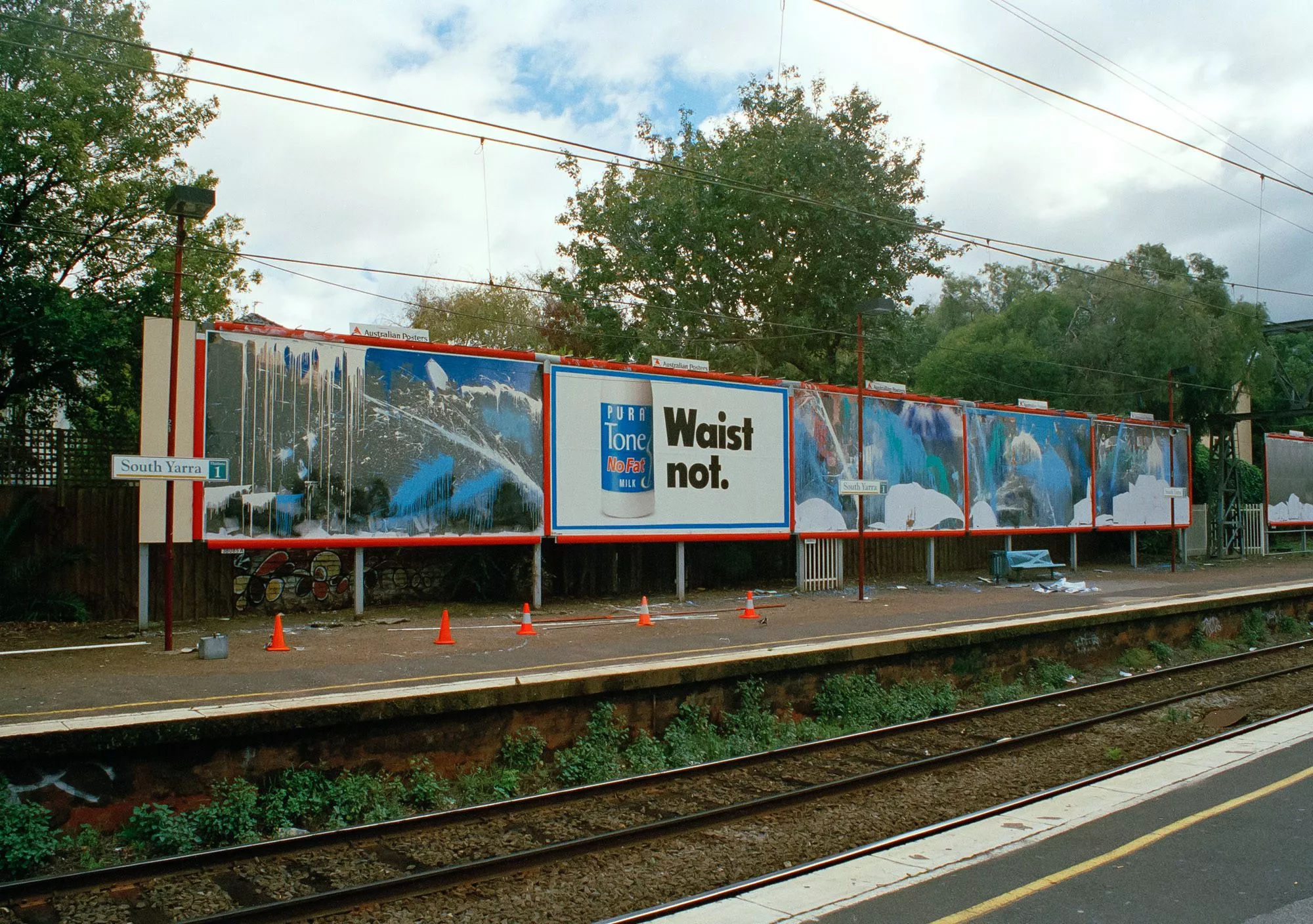
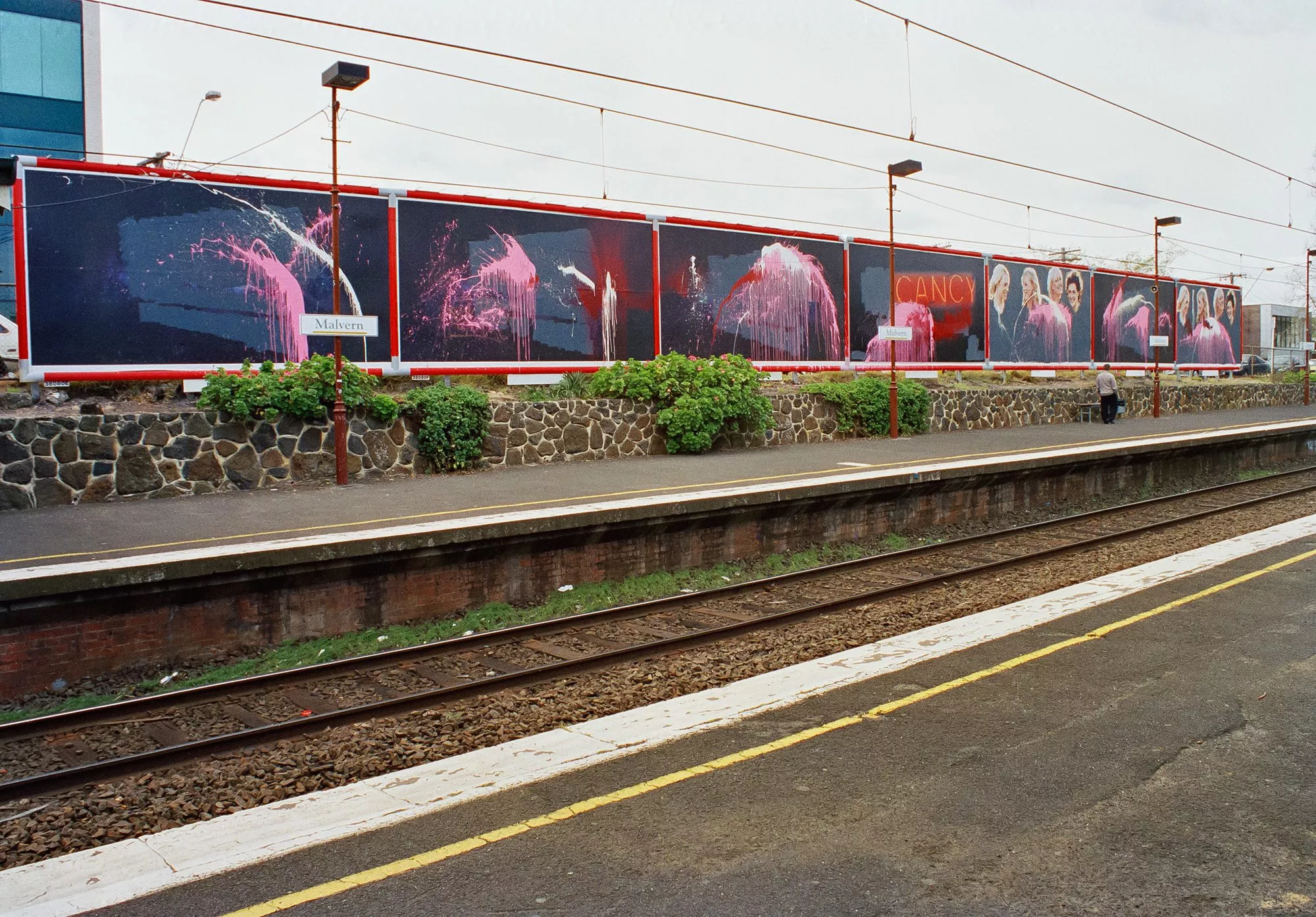
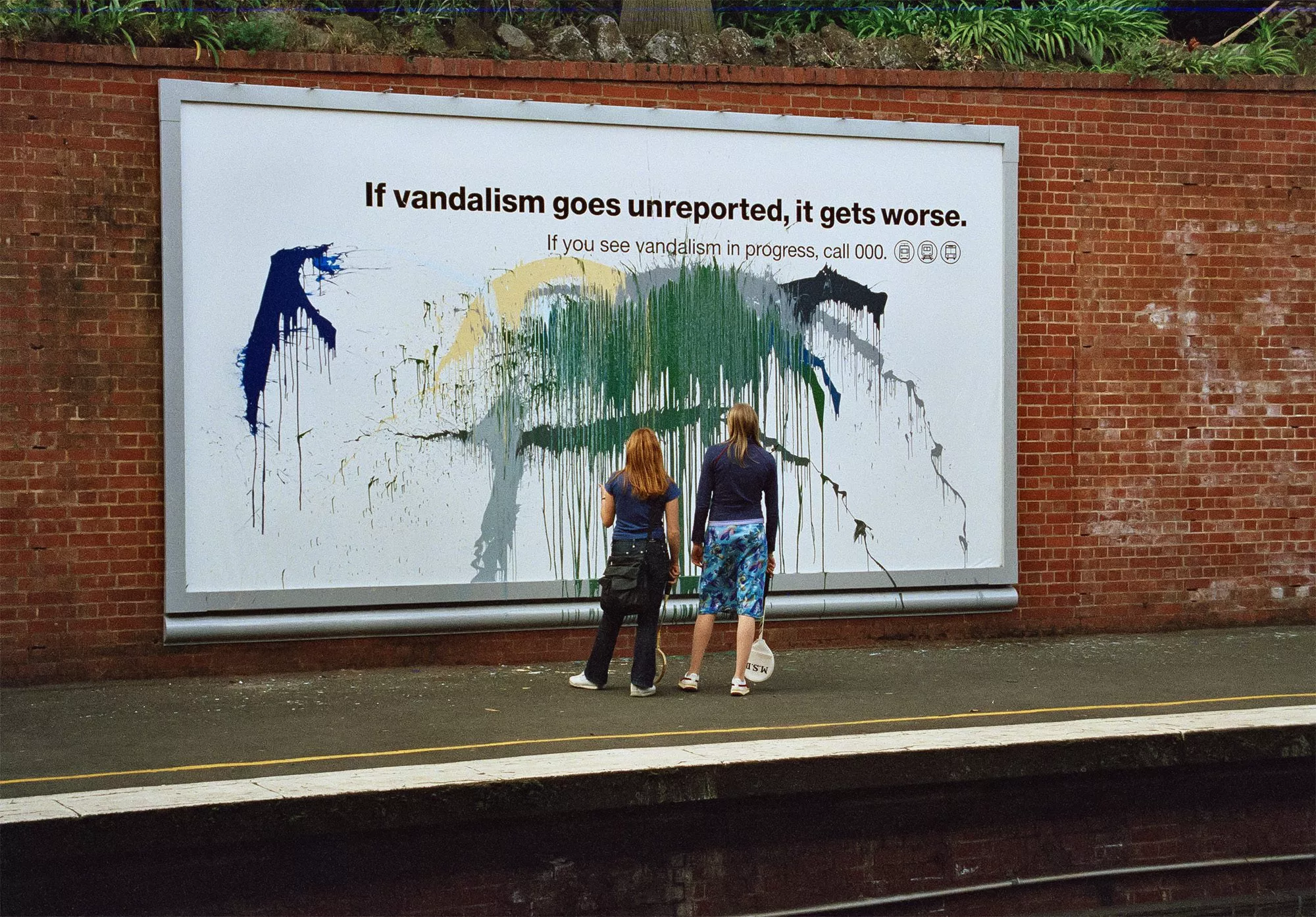
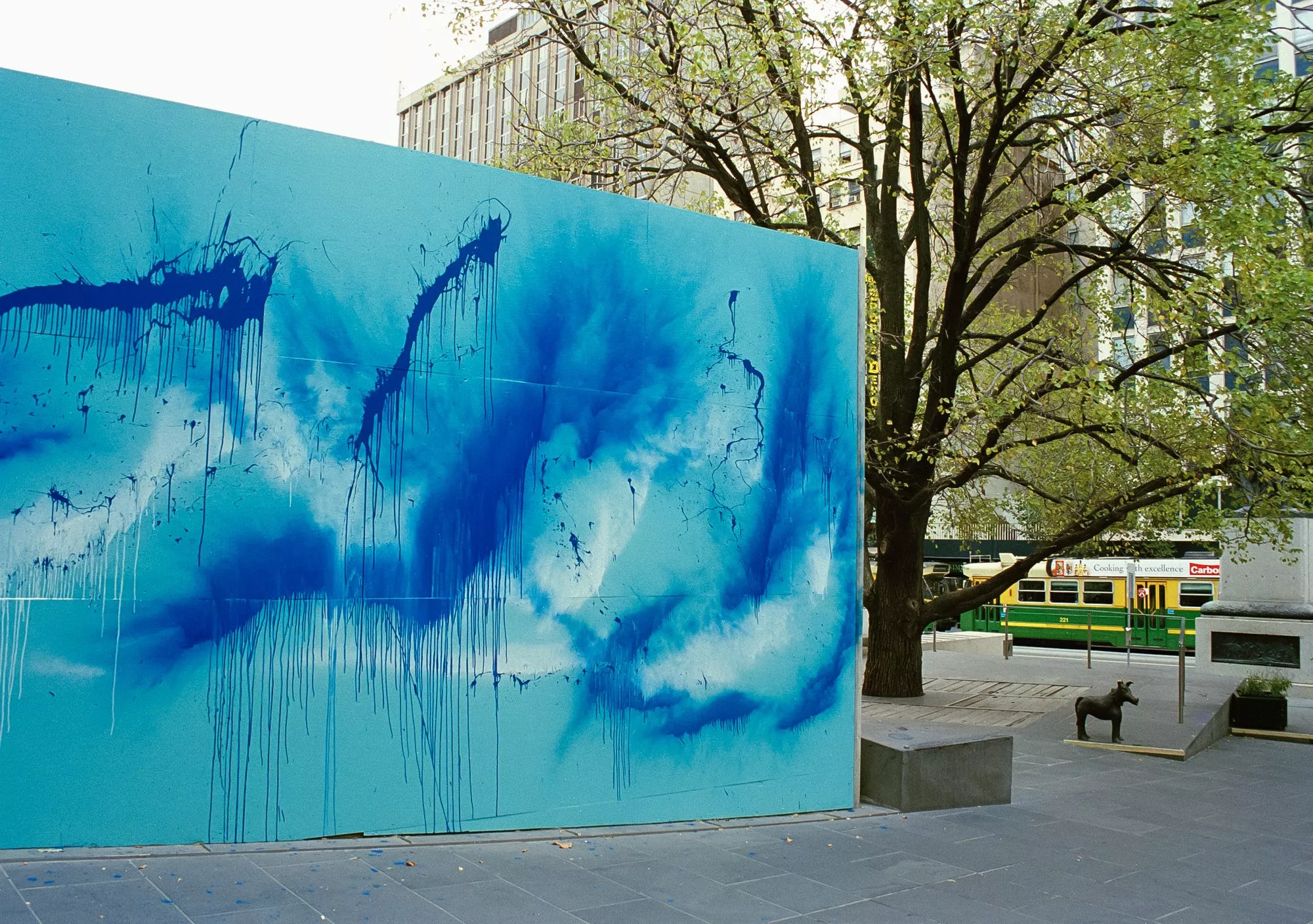
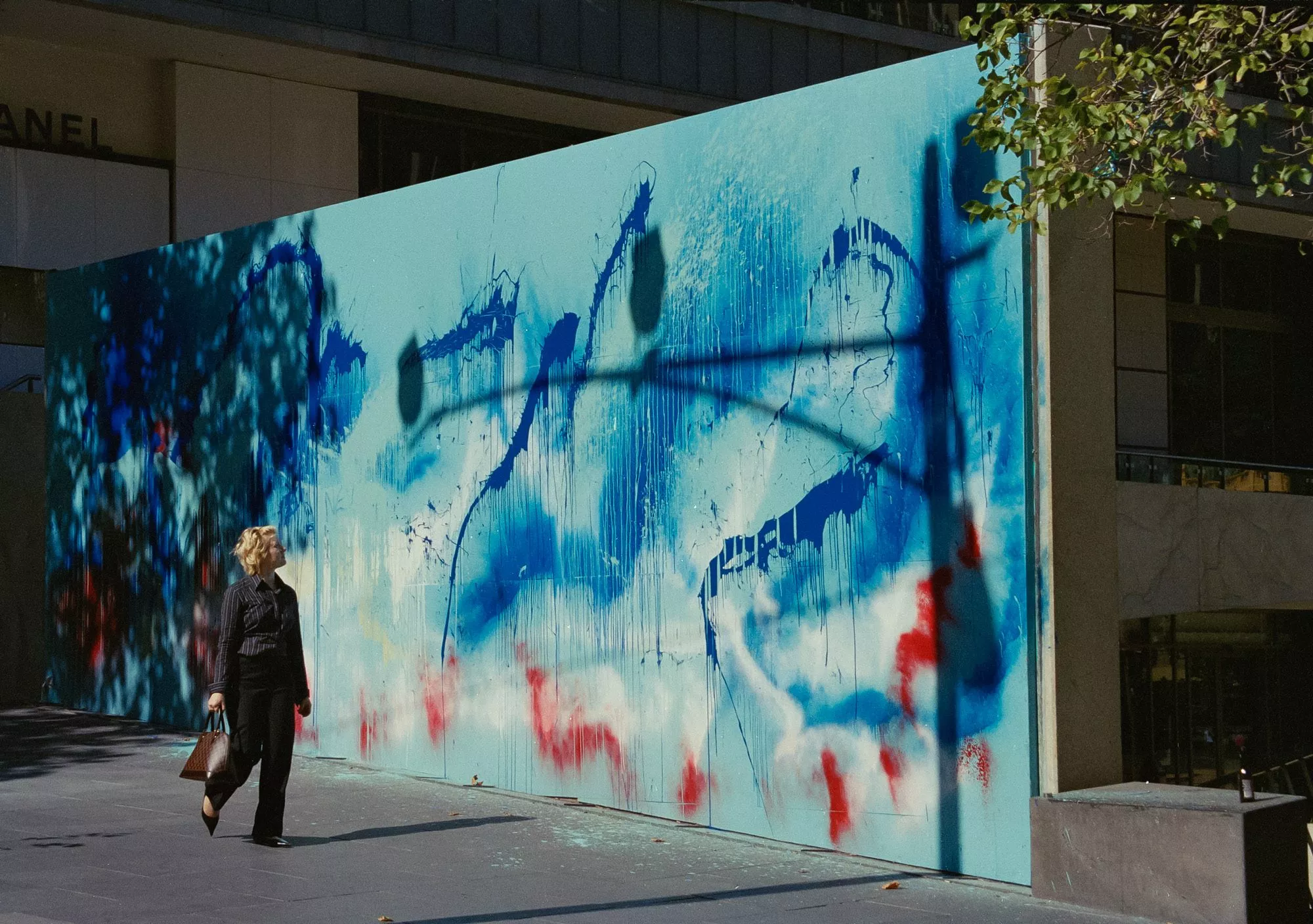
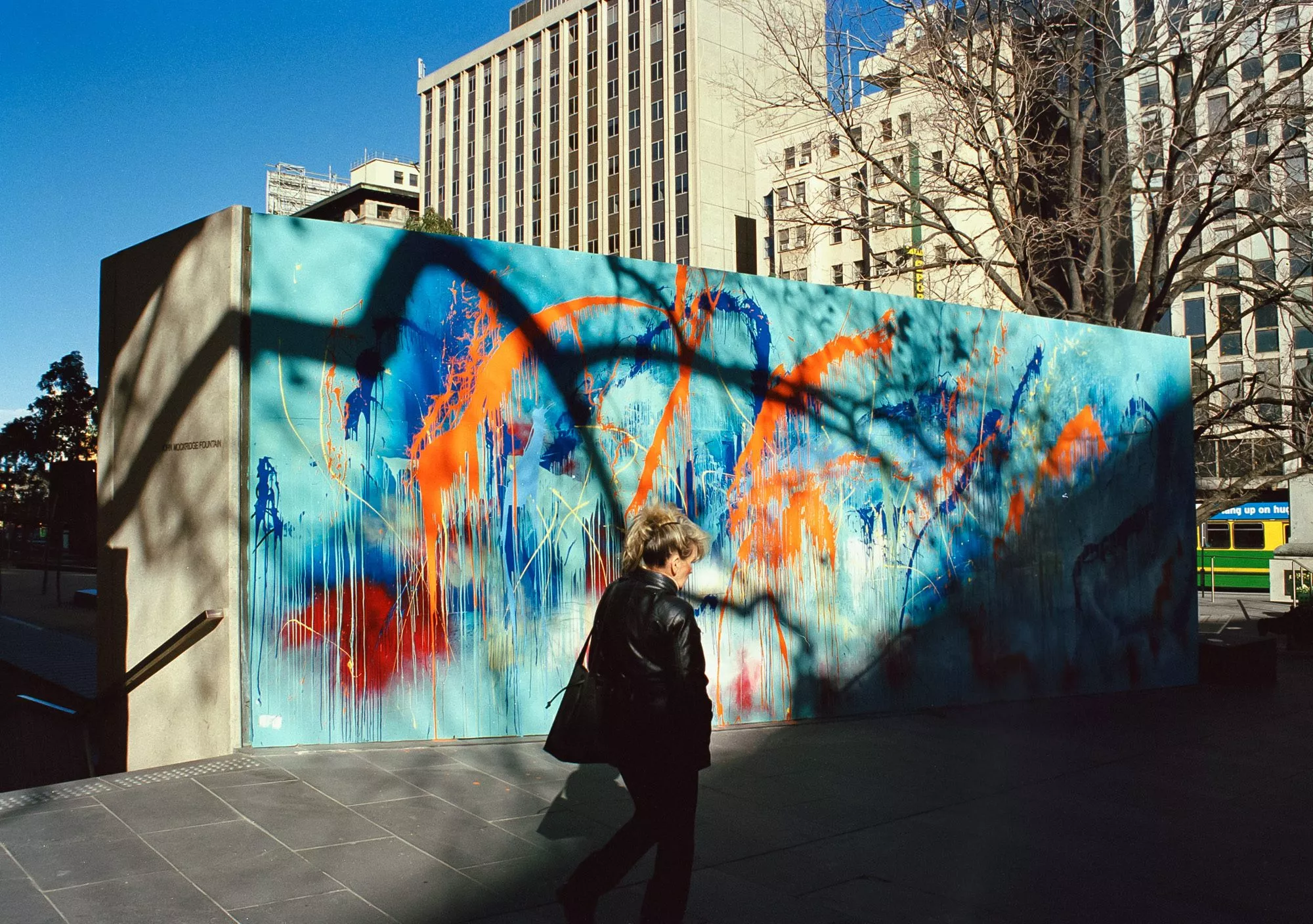
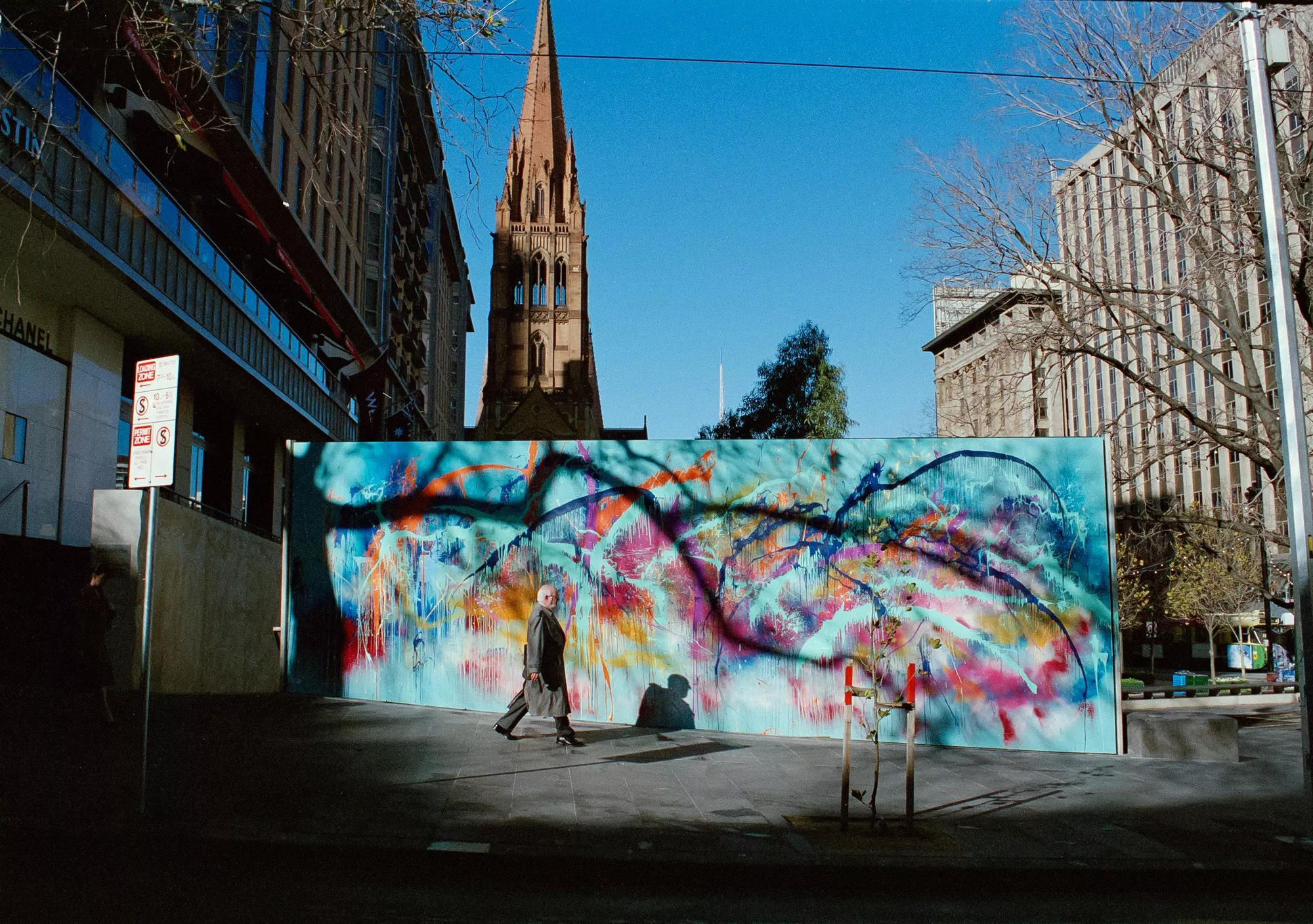
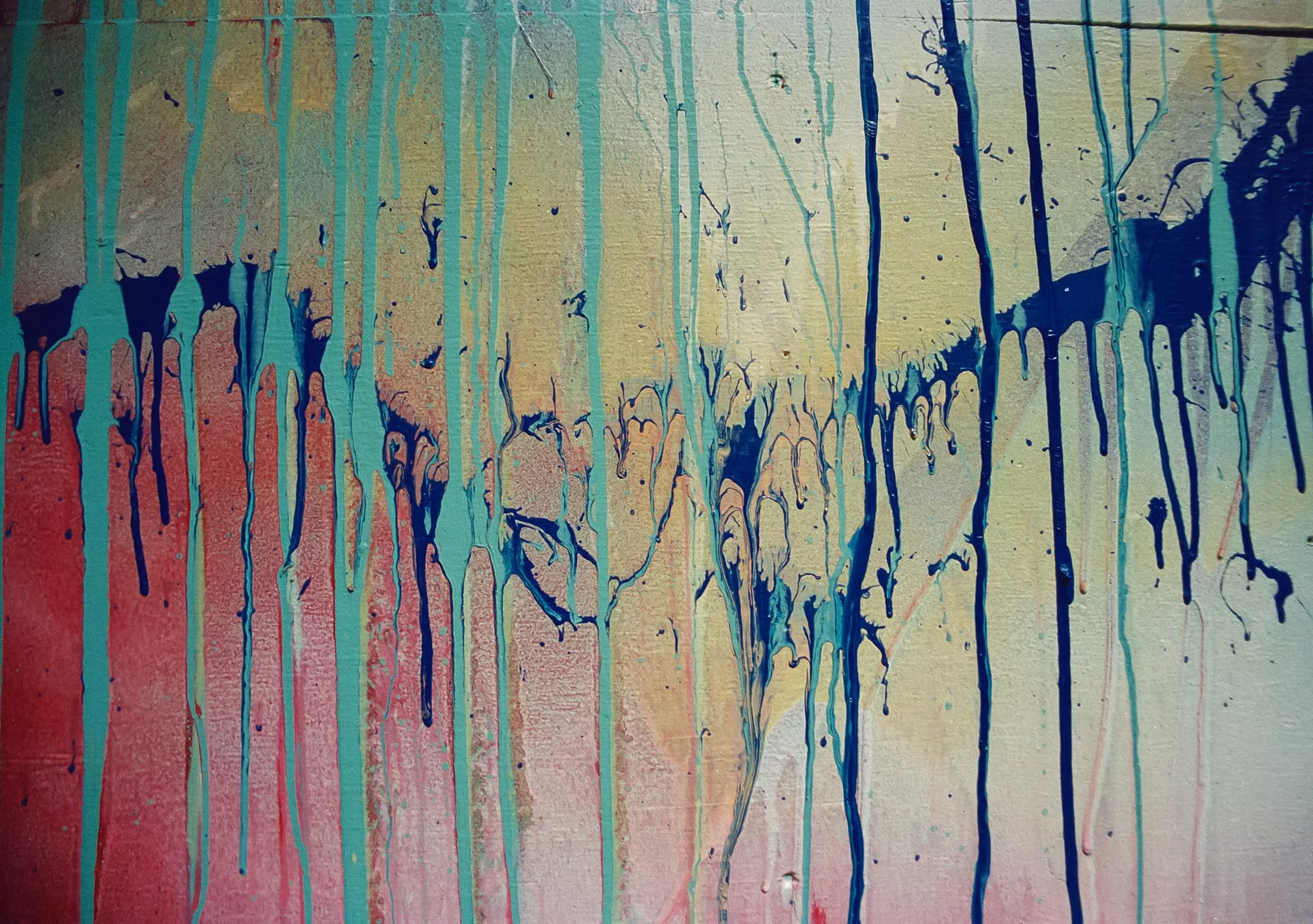
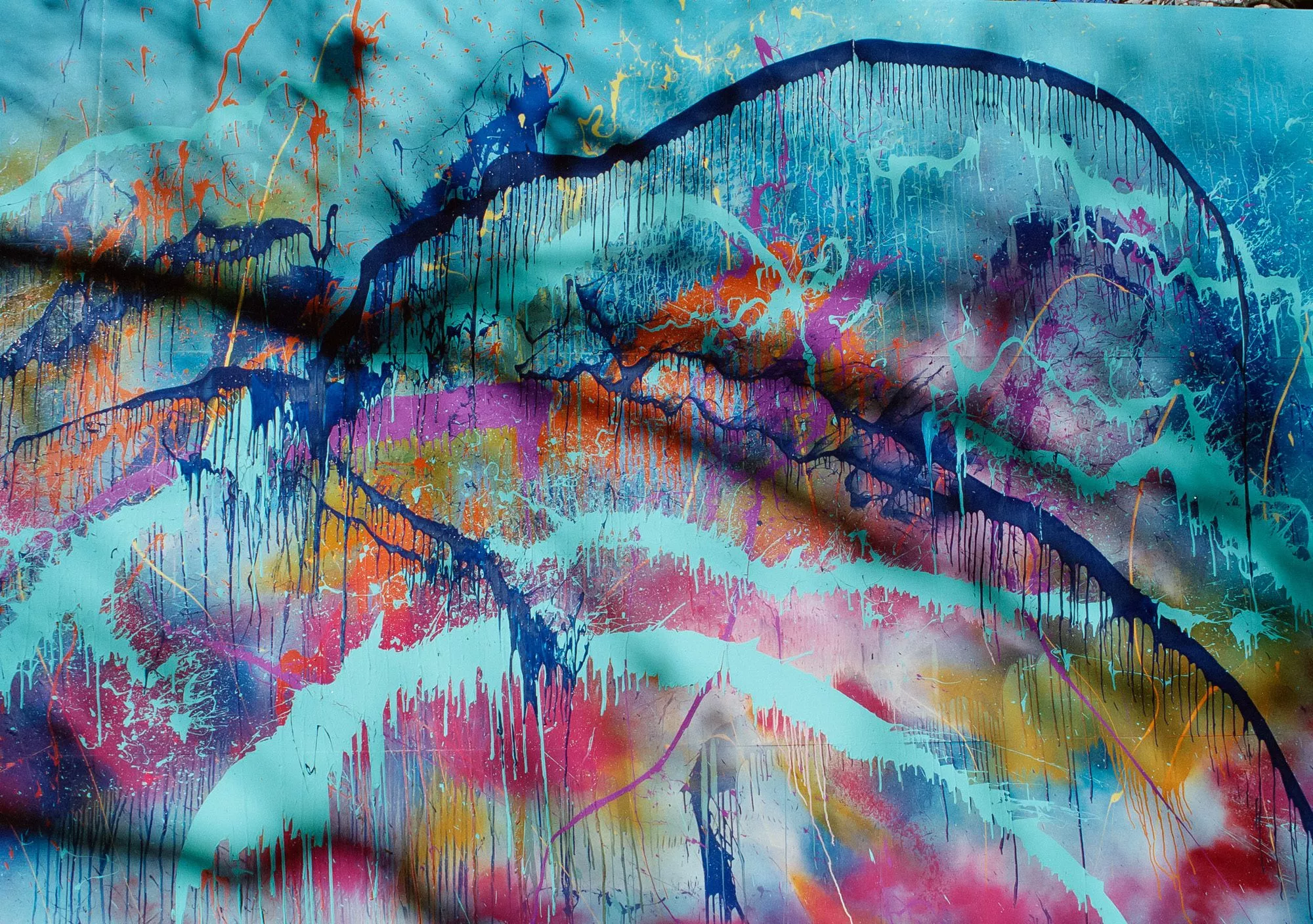
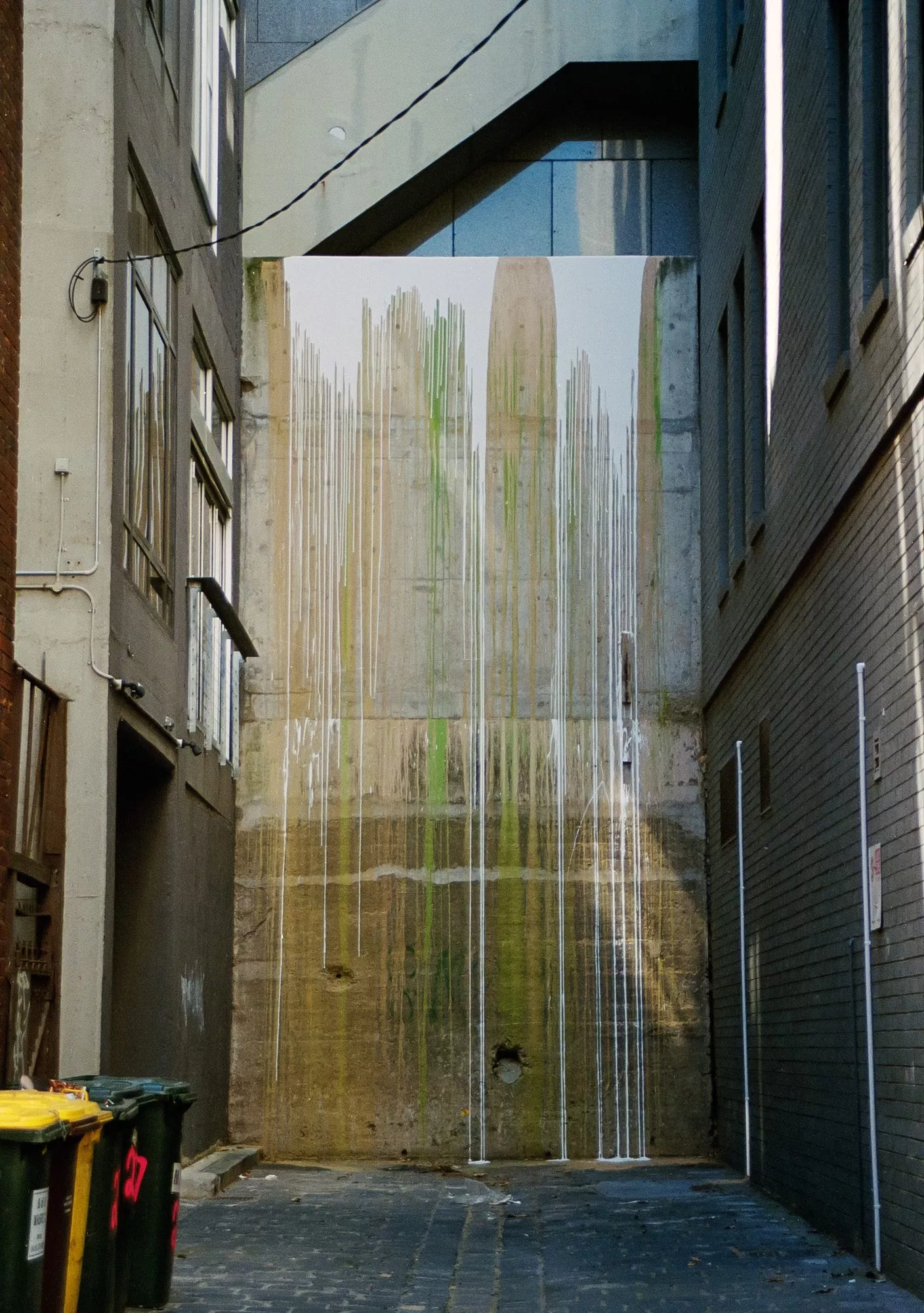
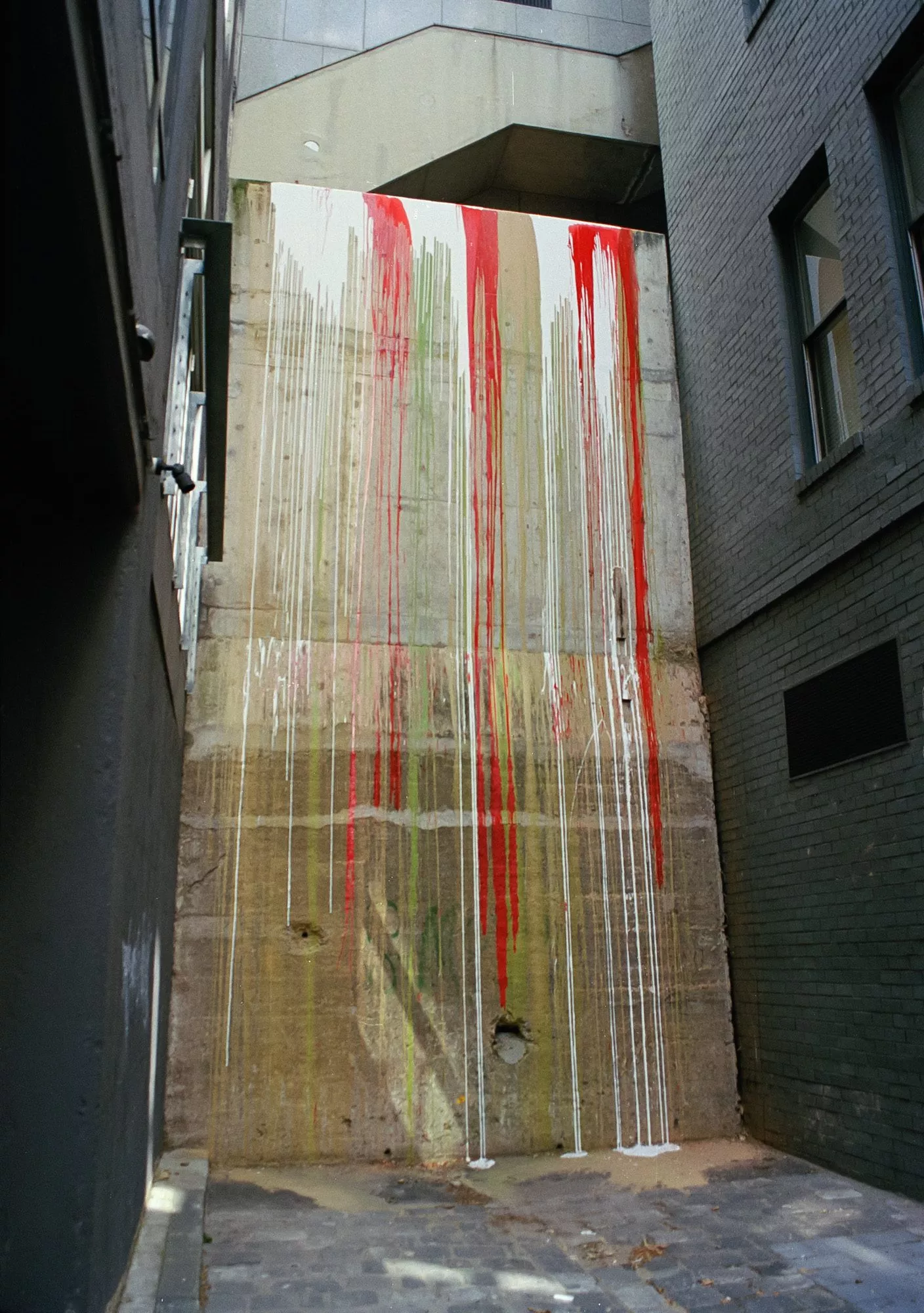
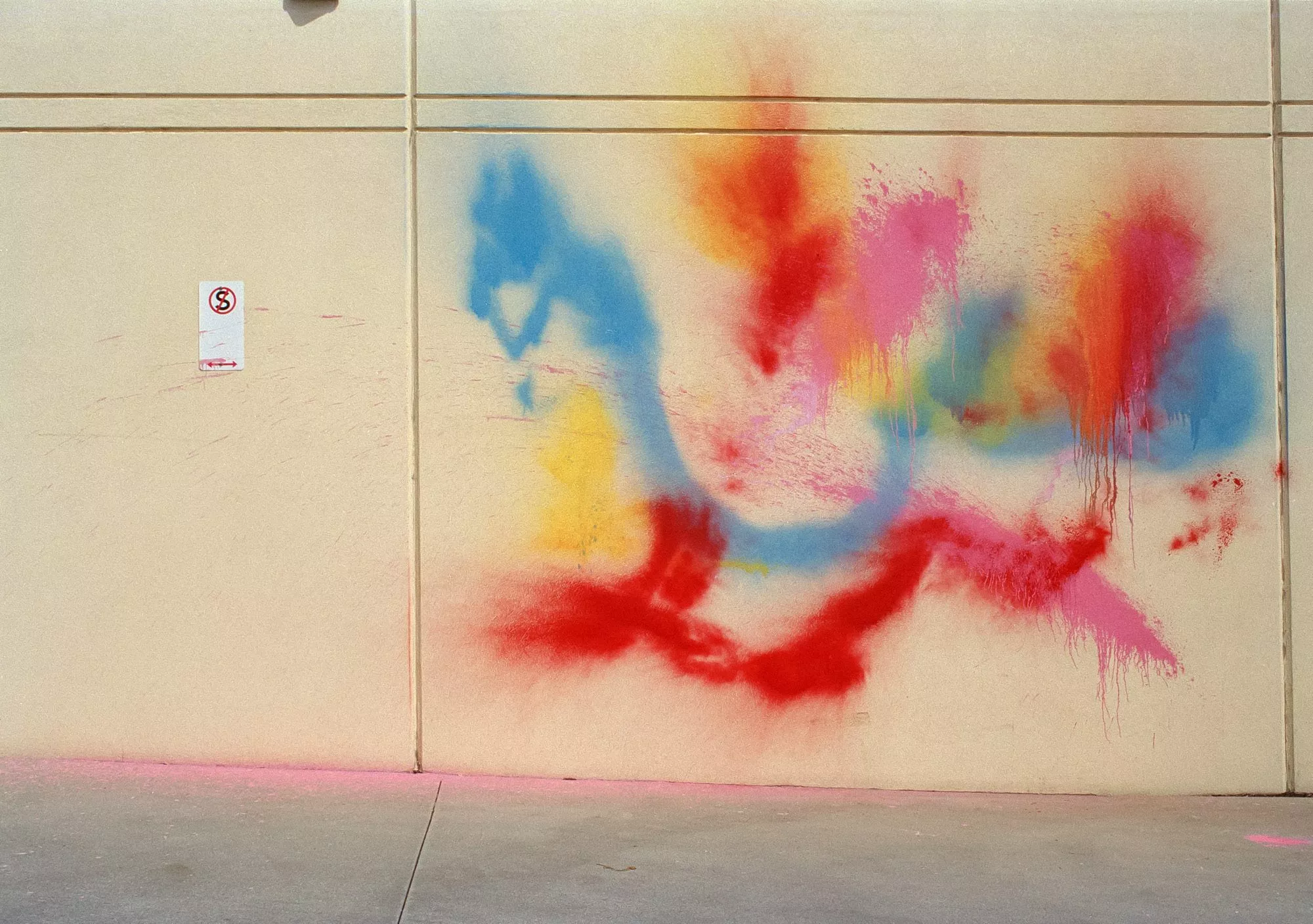
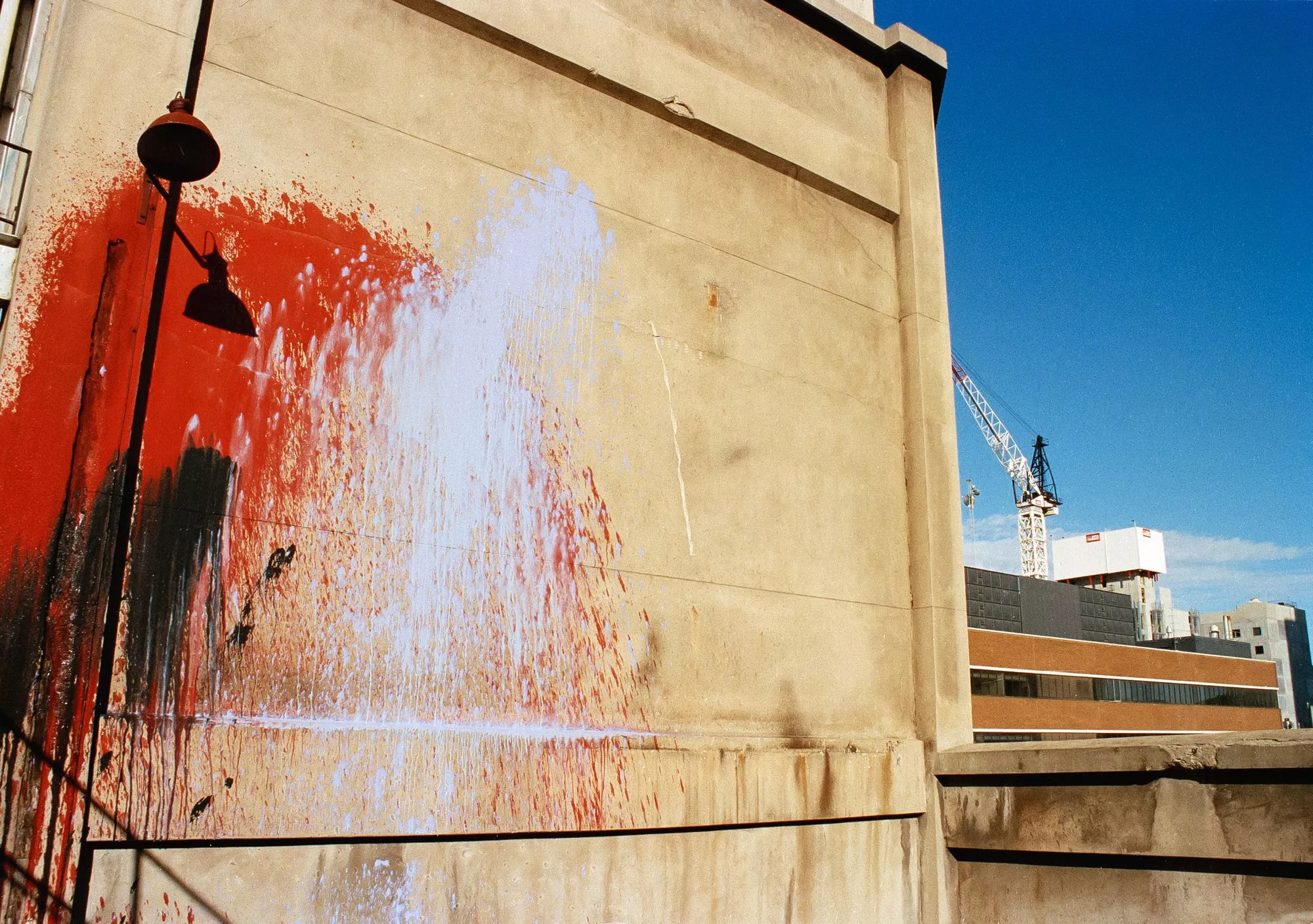
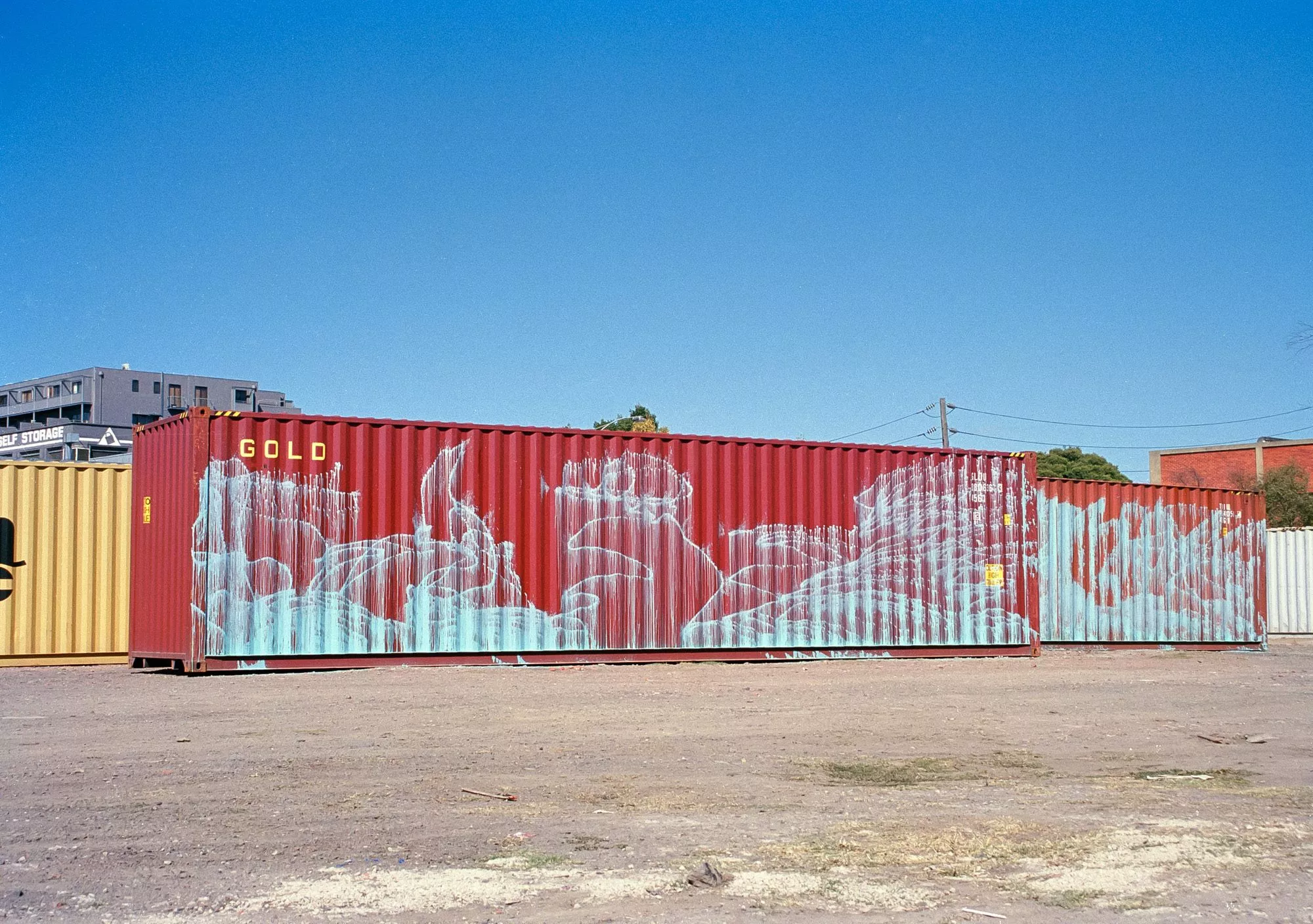
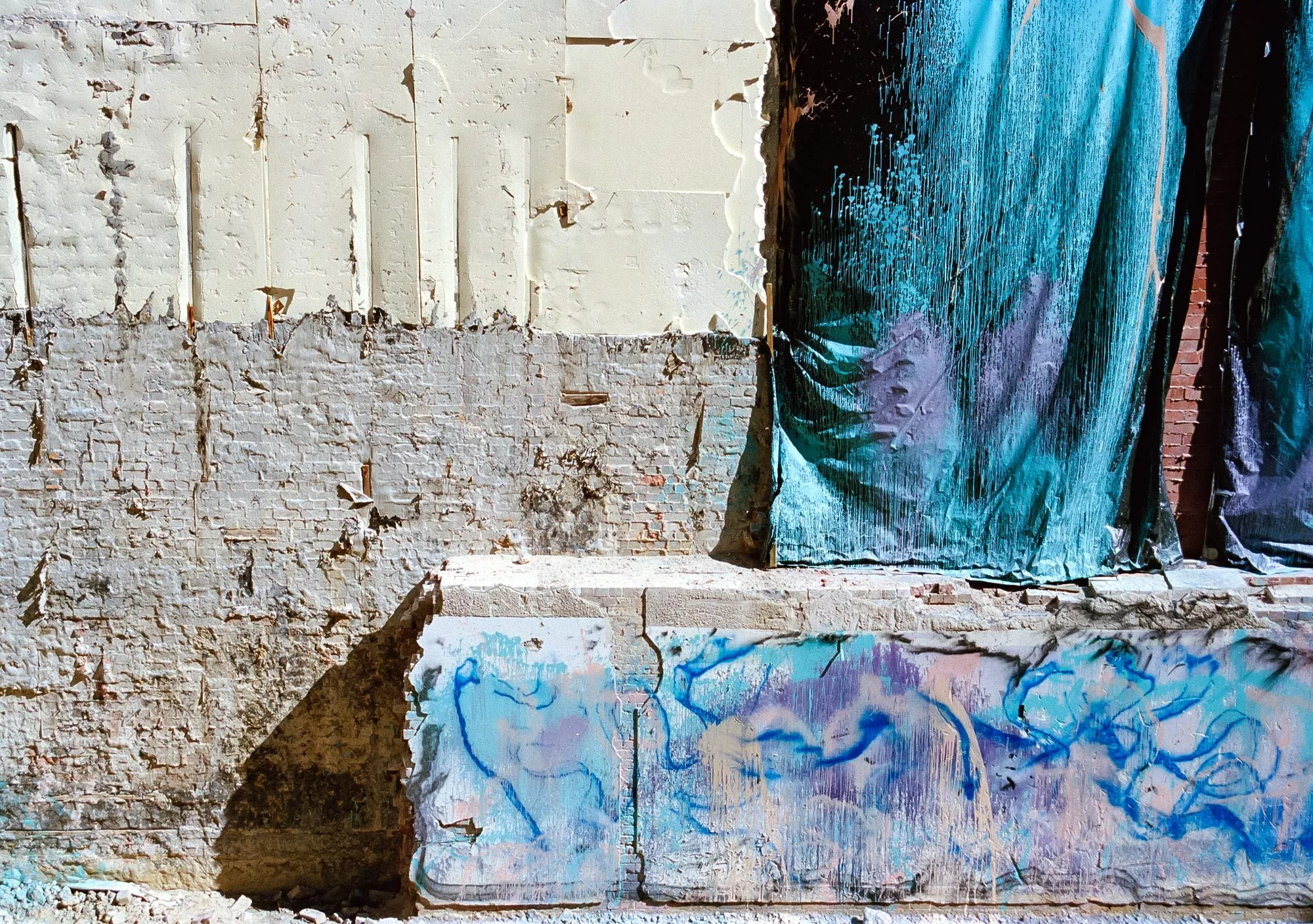
At that time there were no murals or commission works in town and Keating wanted to create his abstract art pieces on big bare walls right in the center of town. He was also into cultural jamming and ad busting and started using advertisement billboards as canvases for interventions in train stations or the streets. One day while changing trains at Richmond station Keating saw a writer he knew of who told him that he heard that some European writers were using fire extinguishers to paint huge tags and that my work would be great for that application. This lead Keating and a friend that lived nearby to search some nearby abandoned warehouses where they struck the jackpot and found about a dozen 9L water-type’s.
His first major work with fire extinguisher, after a few small experiments on shipping containers and city walls was accomplished in 2004 on a huge wall of a car park in the center of Melbourne. He used sky blues, white, black, plum and magenta colors, but the key to this wall and the application was using extinguishers filled with water, which when sprayed over the top of the wet paint caused the colors to merge. Keating realized that this expanded gestural painting practice and technique was allowing interesting color gradients, motion and a unique energy for his abstract paintings. But what excited Keating even more was the way that other people he knew responded to and expressed their buzz for the works he was making.
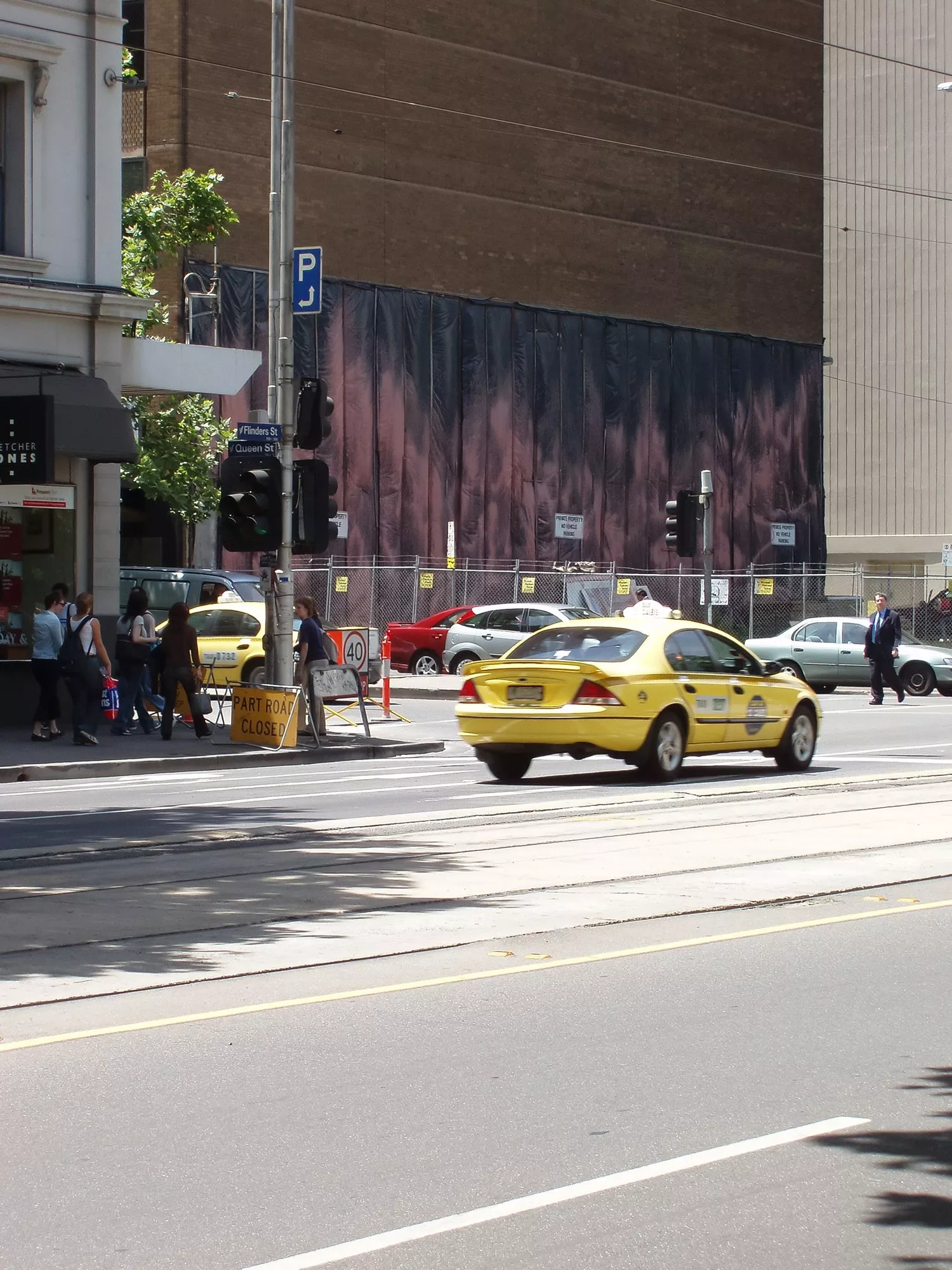
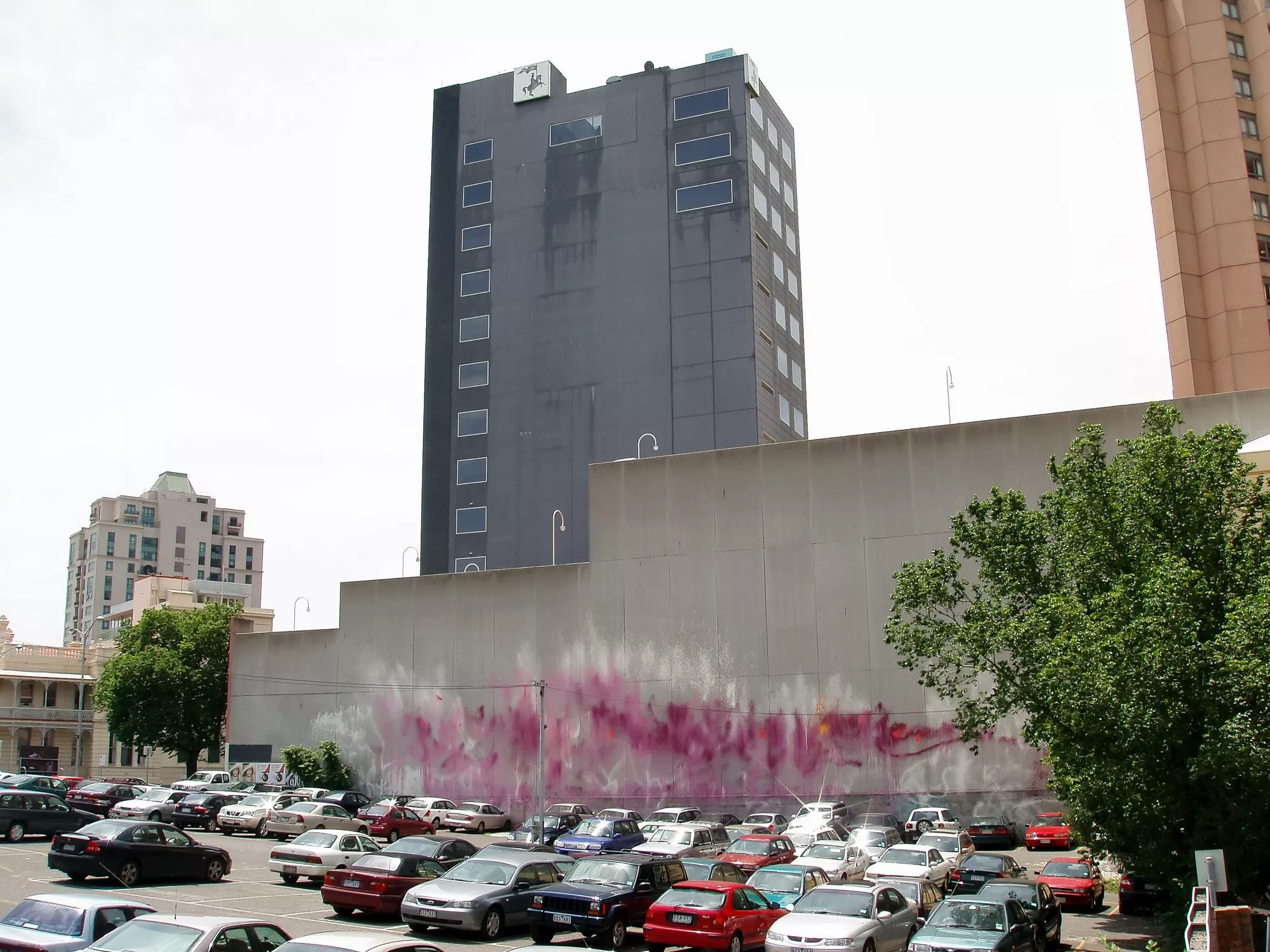
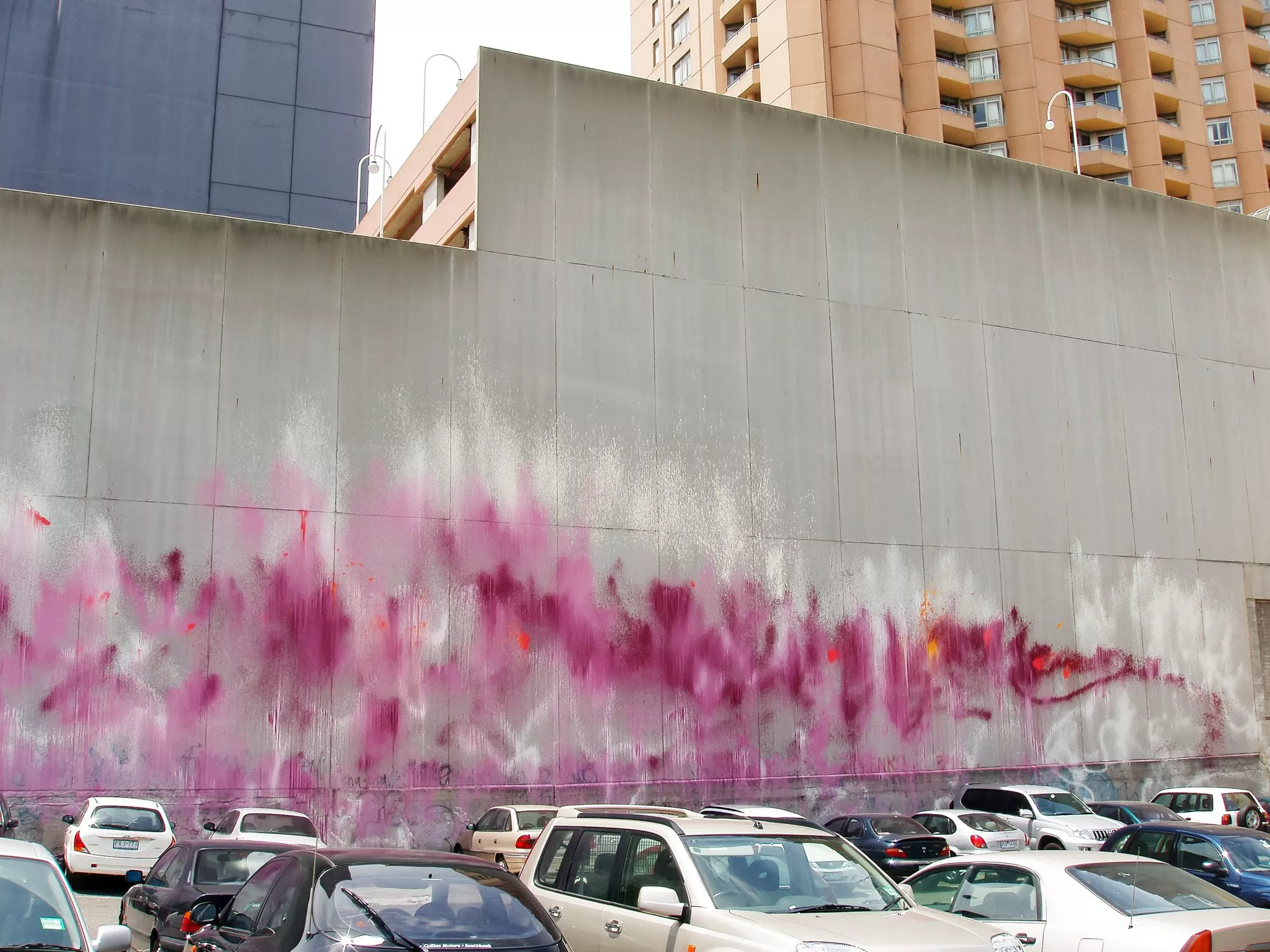
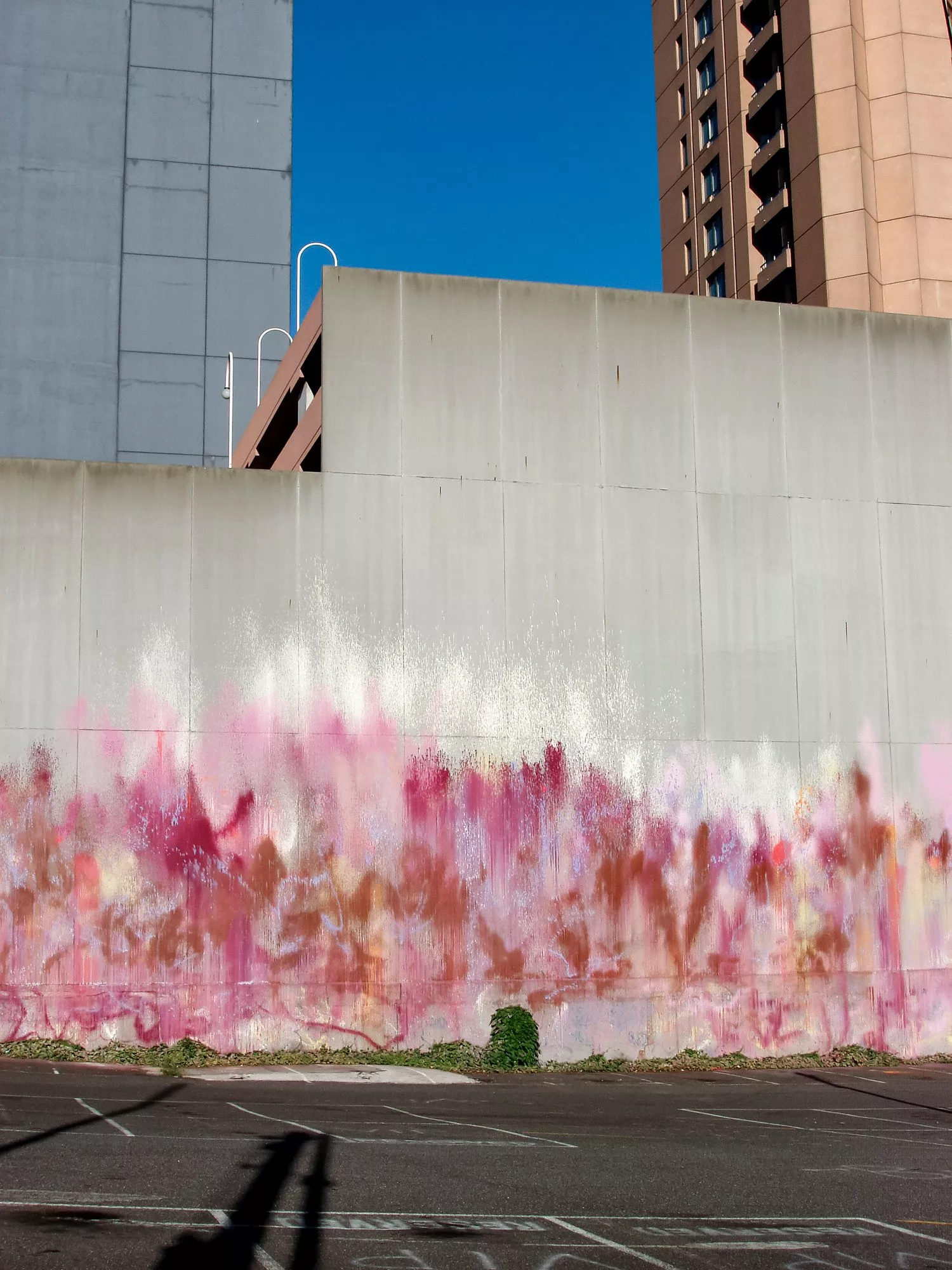
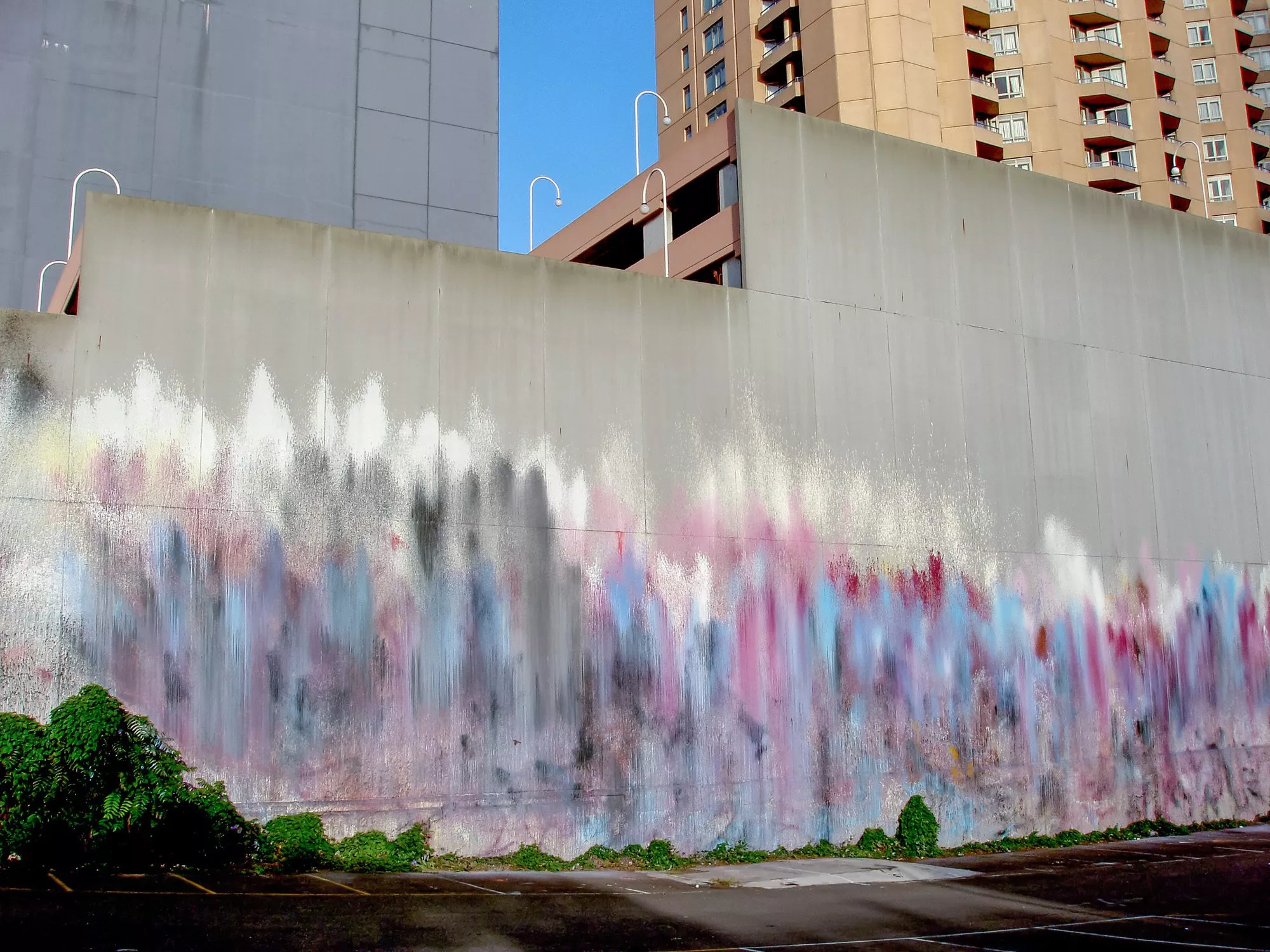
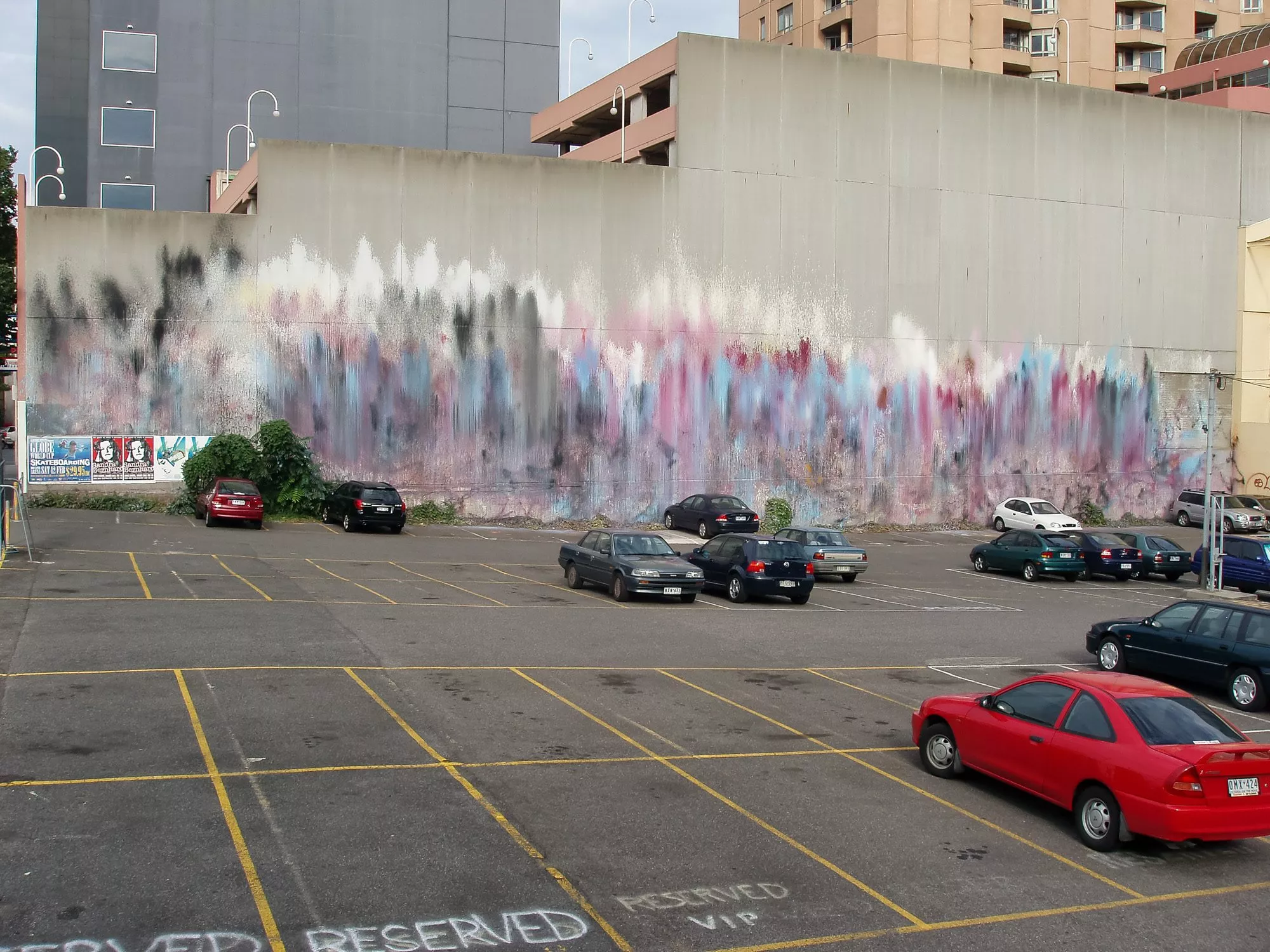
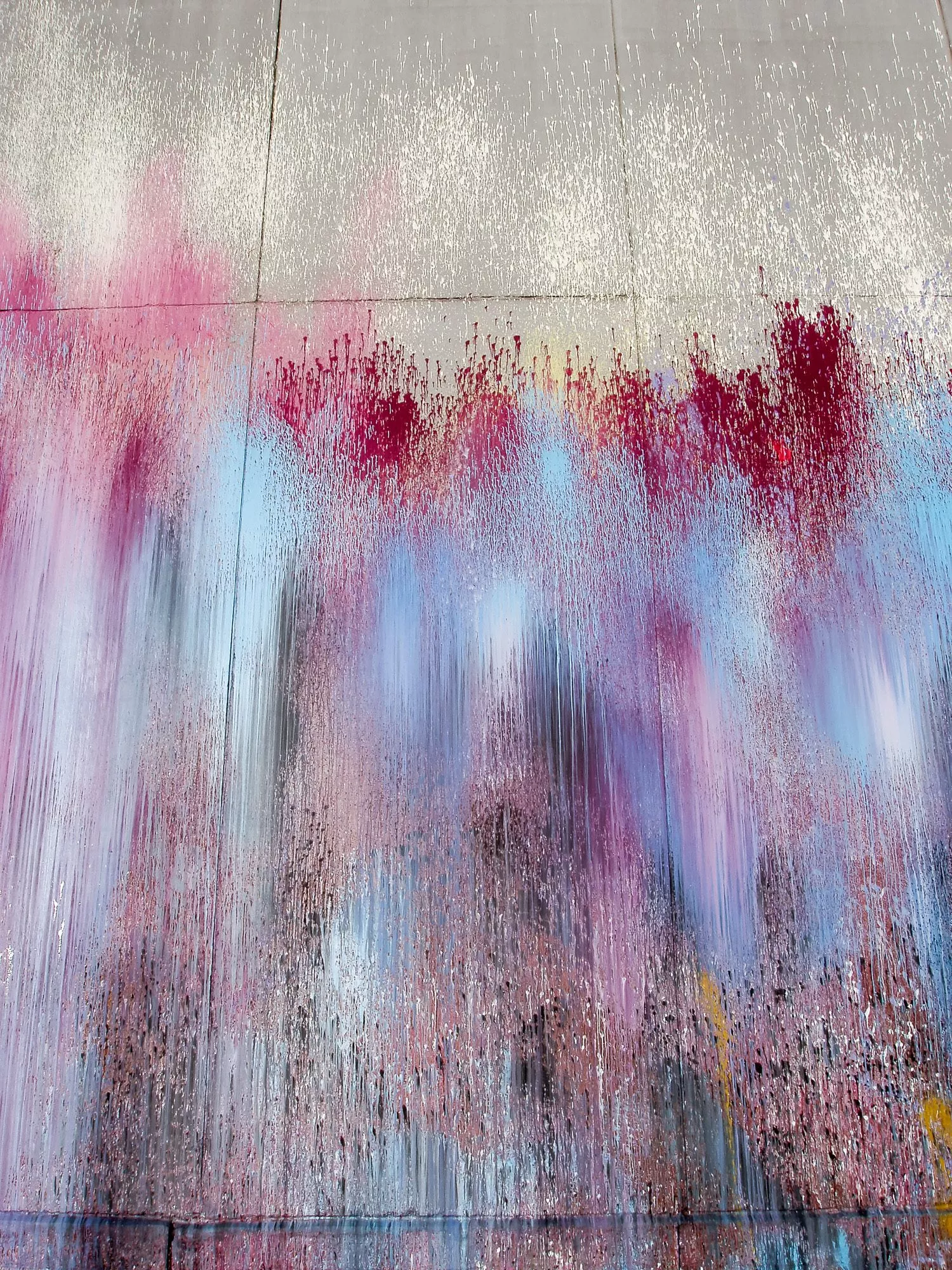
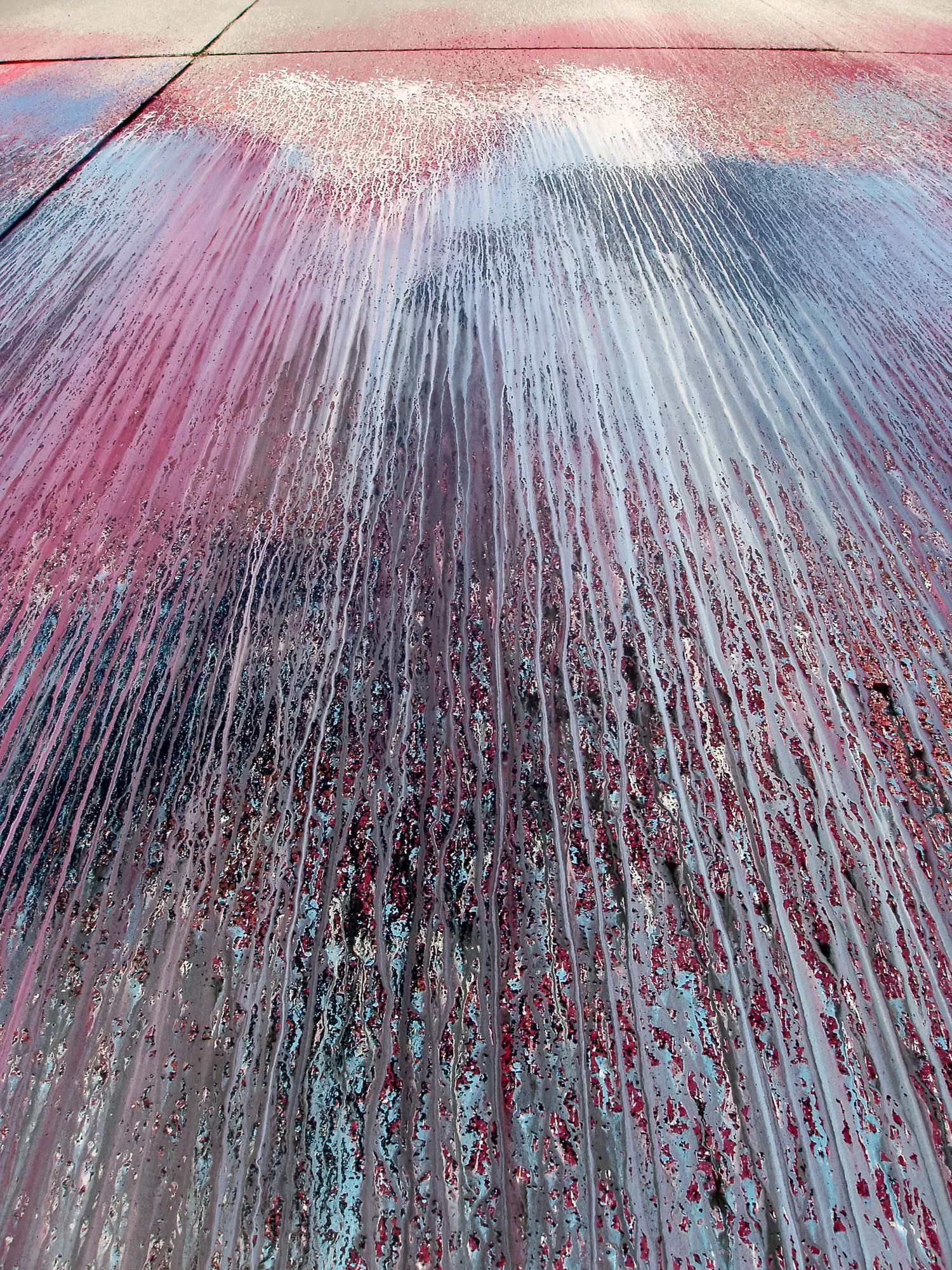
Conceptual art projects before the development of his grandiose painting
Before developing his astonishing painting of the last decade, the Australian artist wanted to explore right after his studies other ways of making artworks involving installations, video and further experimentation of performance without using paint but with industrial waste. His practice from 2006 to 2012 was then marked by ecological activism and focused on public art, seeking to affect change and alternative thinking for systems of production and consumption, thematizing social and environmental issues such as climate change, urban gentrification, waste and sustainability. He created several funded public artworks, three major ones in the southern hemisphere outside of Australia. His first project was in Santiago, in Chile in 2006, followed by a work in Yogyakarta, Indonesia in 2009 and one year later in Christchurch, Aotearoa/New Zealand. All these art projects were geographically positioned within a region known as the “Ring of Fire”, a region surrounding the Pacific Ocean. The area experienced many earthquakes and extensive volcanic activity due to the movements of the tectonic plates. In this region of natural disasters, Keating wanted to create works that had the ability to effect a positive change, both politically and environmentally. In 2009 his ambitious art project „Activate 2750“ in Penrith near Sydney took place over four weeks and was set out to raise speak about our relationship to the production and consumption of waste, by creating an artwork that reused material collected by the artist from the acres of dumped waste. It resulted in a huge installation, a kind of monument in the middle of the city. Acting in public spaces, he wanted to interact with people and raise awareness of consumerism and waste. In Ash Keating’s conceptual artistic practice those years, elements of mourning (for known losses) and melancholia (for unknown deficits) are sensitizing the viewer to commemorate, enshrine and memorialize the present through collective performative elements of myth, ritual and ceremony.
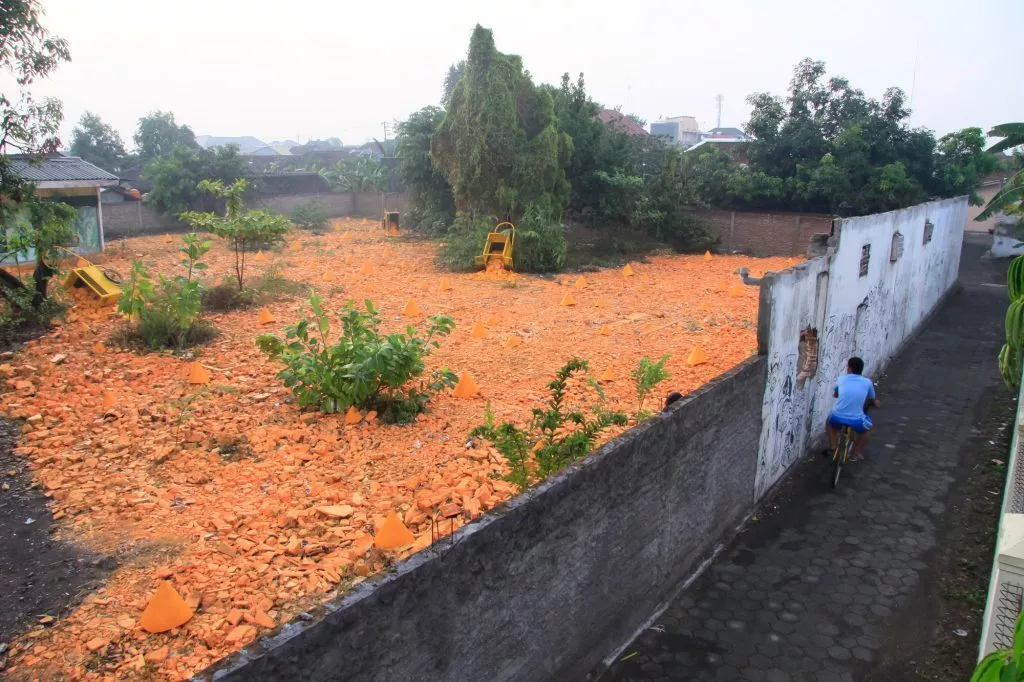
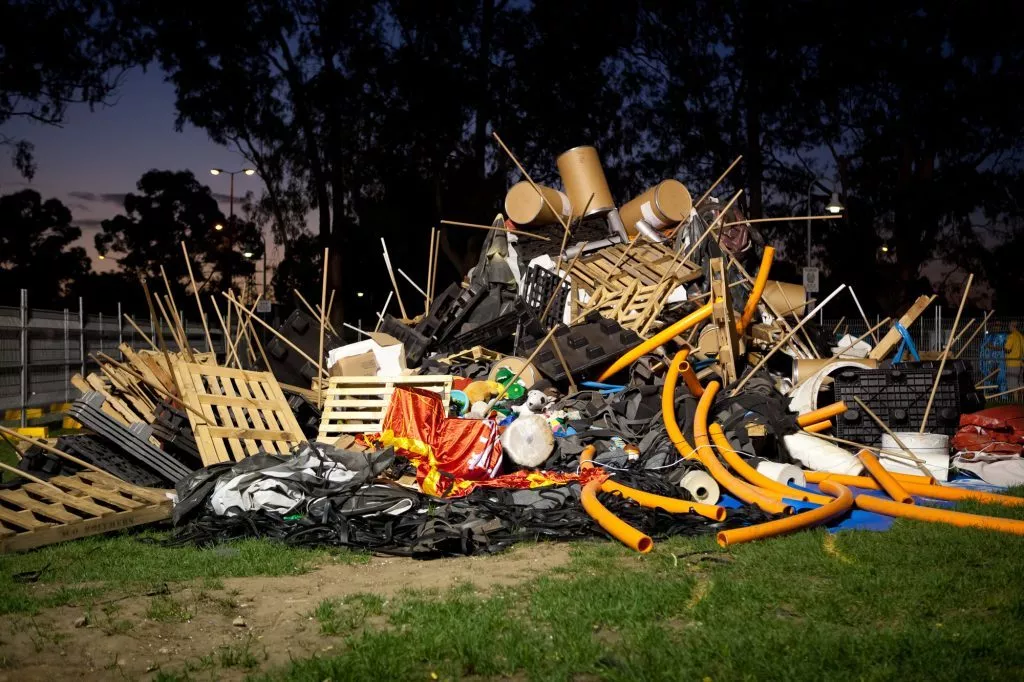
Painting large-scale in public space
His love and respect for nature, as well as acting in public spaces, is the common denominator of his entire artistic practice, as his sprayed paintings, which he has continued to develop since 2012 until today, were born from the inspiration of the surrounding nature in Australia. The experience of nature is what Keating is projecting into his paintings. The depiction of light and atmospheric conditions of nature through layers of sprayed colors became the main painterly task for Keating and make a link to Impressionism. While his spontaneous way to work with sprayed paint for his abstraction allows improvisation and performative working methods like action painting. “Like any artist, I am influenced by the life around me; I am constantly inspired by color in nature and changing light in urban environments,” says Keating. “Subconsciously, I am also influenced by the way that other artists work – I actually think it is a responsibility to be aware of the field you work in so that you can ensure you are creating something entirely unique.”
The use of fire extinguishers for abstract paintings makes his practice unique, and he is one of the rare artist being able to control an untypical painting tool, that is very physical to handle with its explosive energy. Working with it mainly outdoors, from the ground on large-scale facades of buildings like warehouses, he struggles with pressed out liquid paint and water against gravity and the prevailing weather conditions while working. The energy of a fire extinguisher is what needs to be handled for the wanted pictorial result, that is in turn linked to the peculiarity of the tool itself. Depending on the pressure and the liquid grade he mixes in advance for each fire extinguisher he uses for an art work, the obtained jet and speckles are different, creating different effects on a wall. The addition of water, the varying humidity and gravity create different traces of the projected liquid paint, creating drops, mist-like applications of paint, gradients with movement and beautiful blends of color. The effect is not only that of running and dripping paint, but the replication of natural systems found in the environment, reminding movement of waterfalls, rainfalls, traces of erosion on rocks, colors of Australian nature and its incredible changing light.
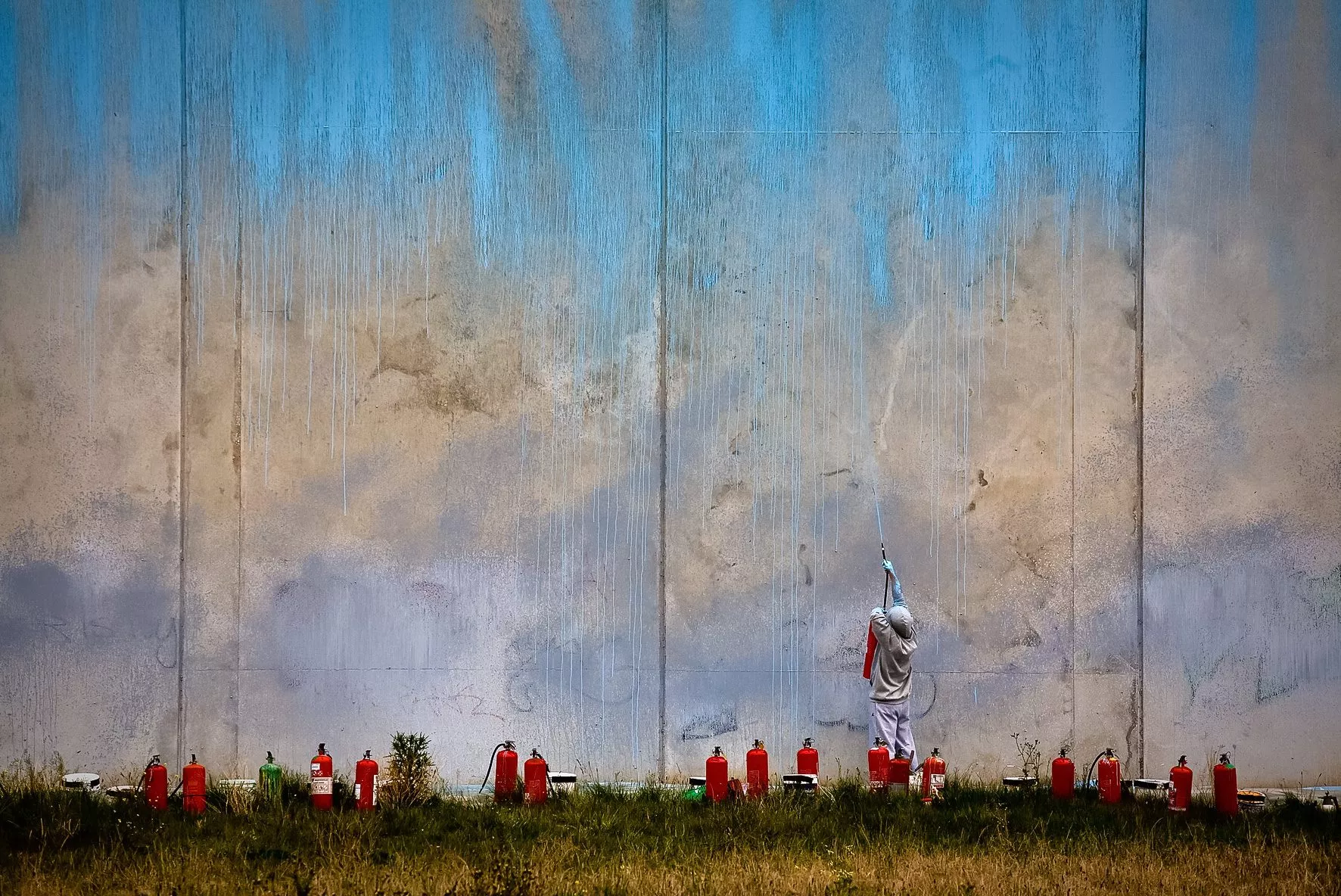
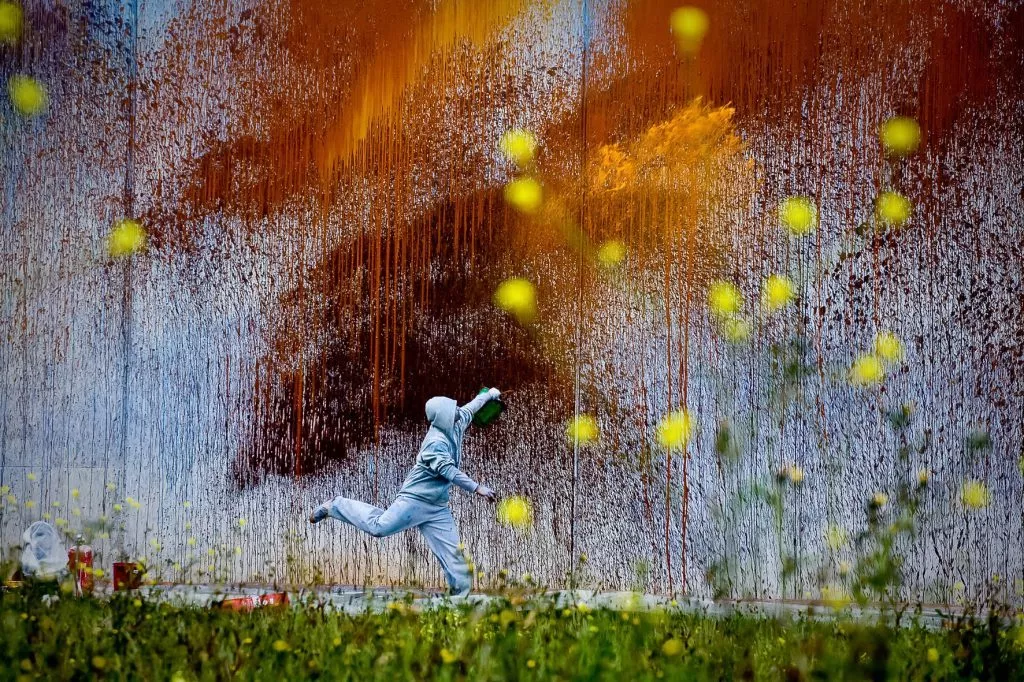
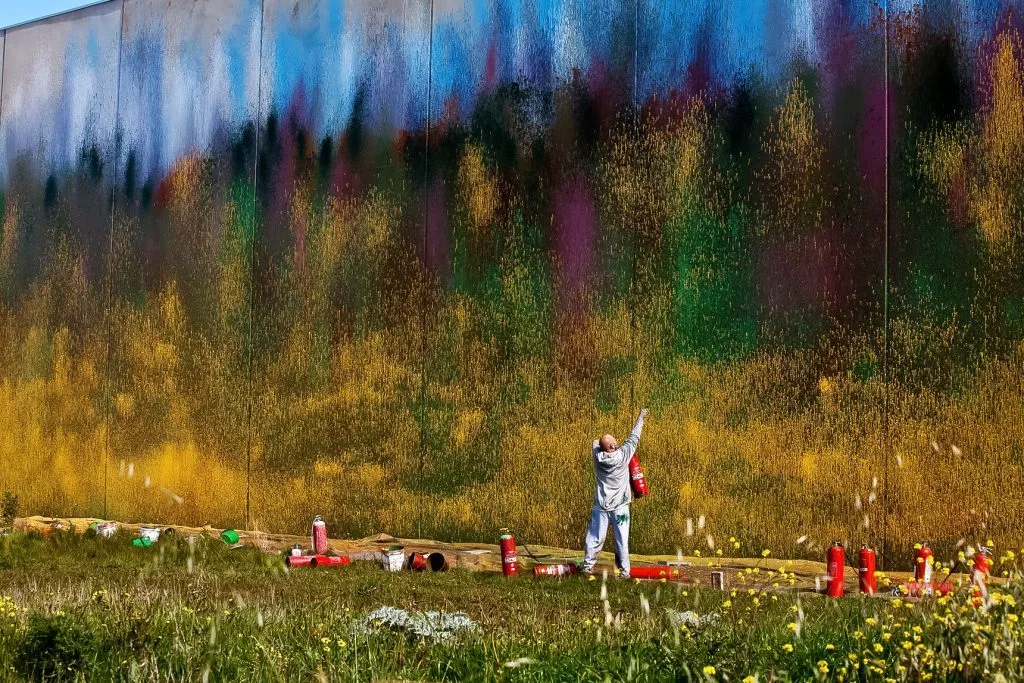
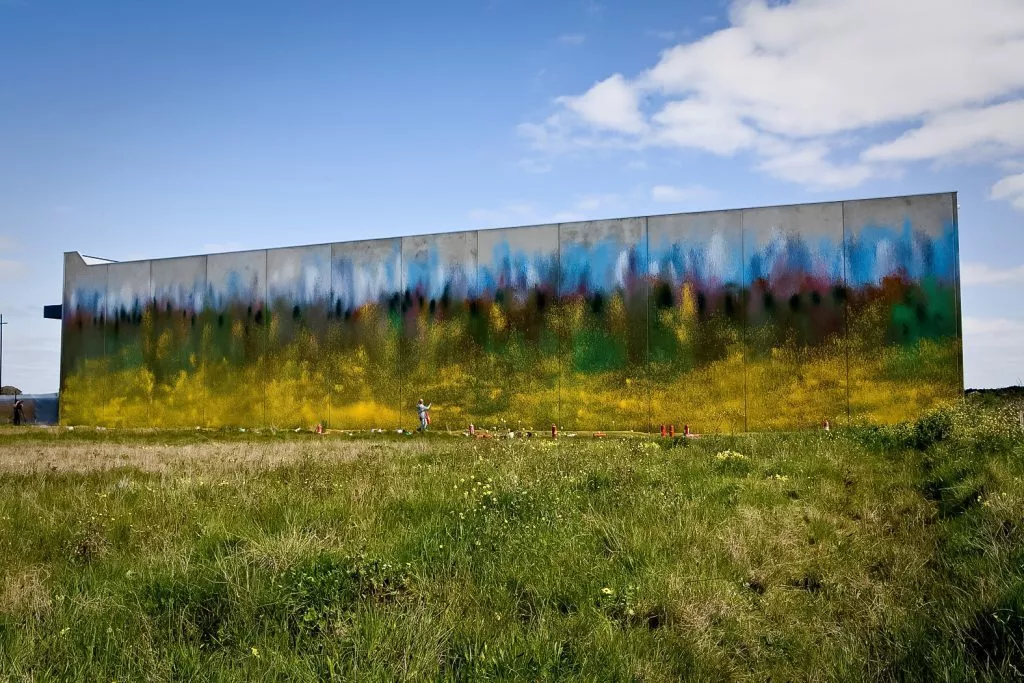
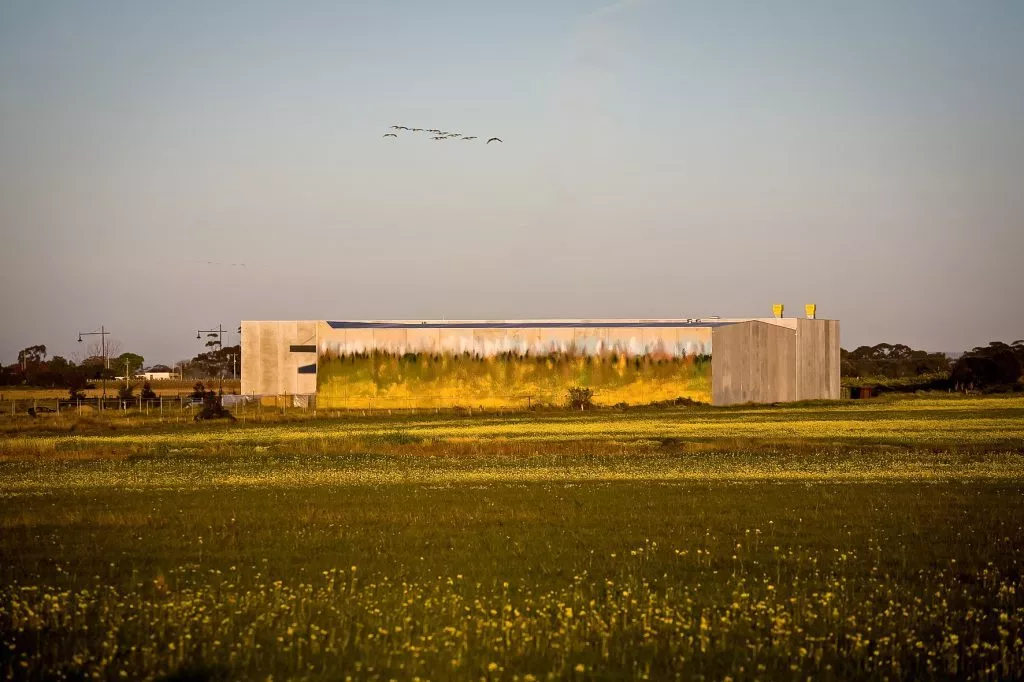
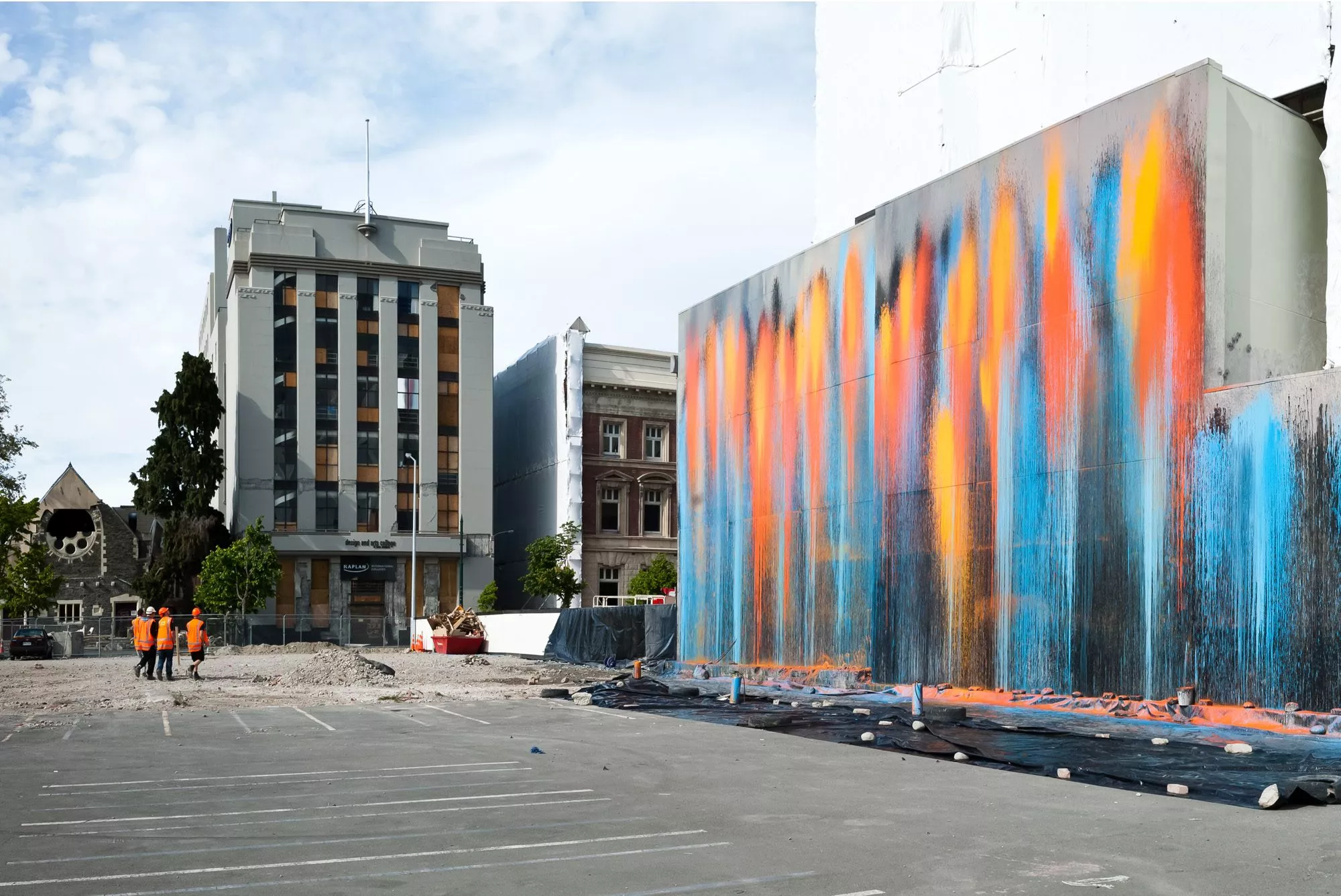
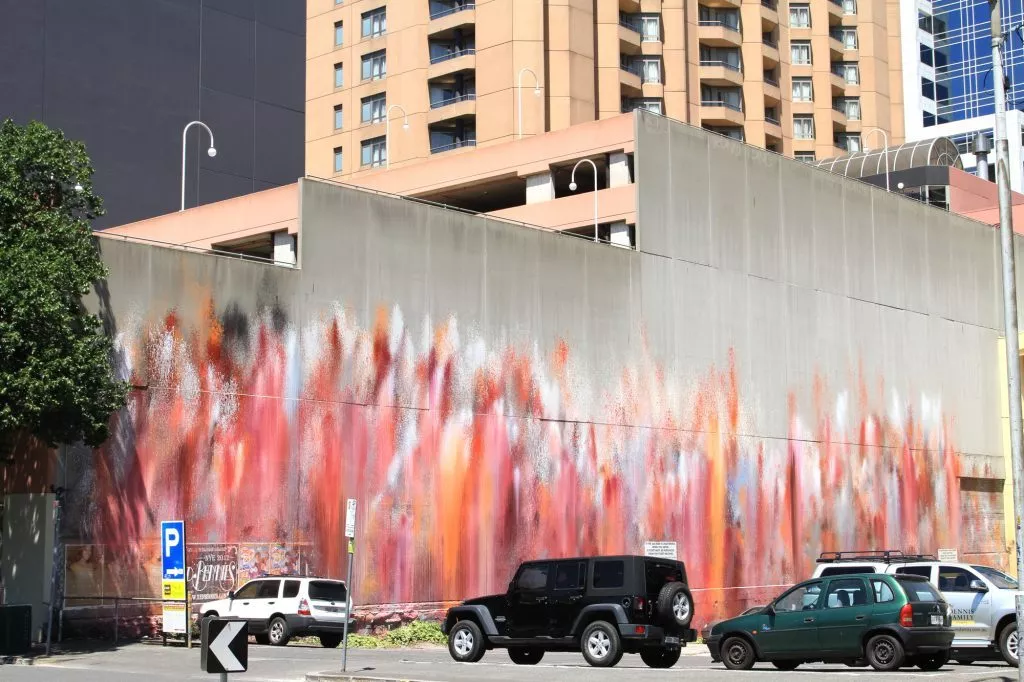
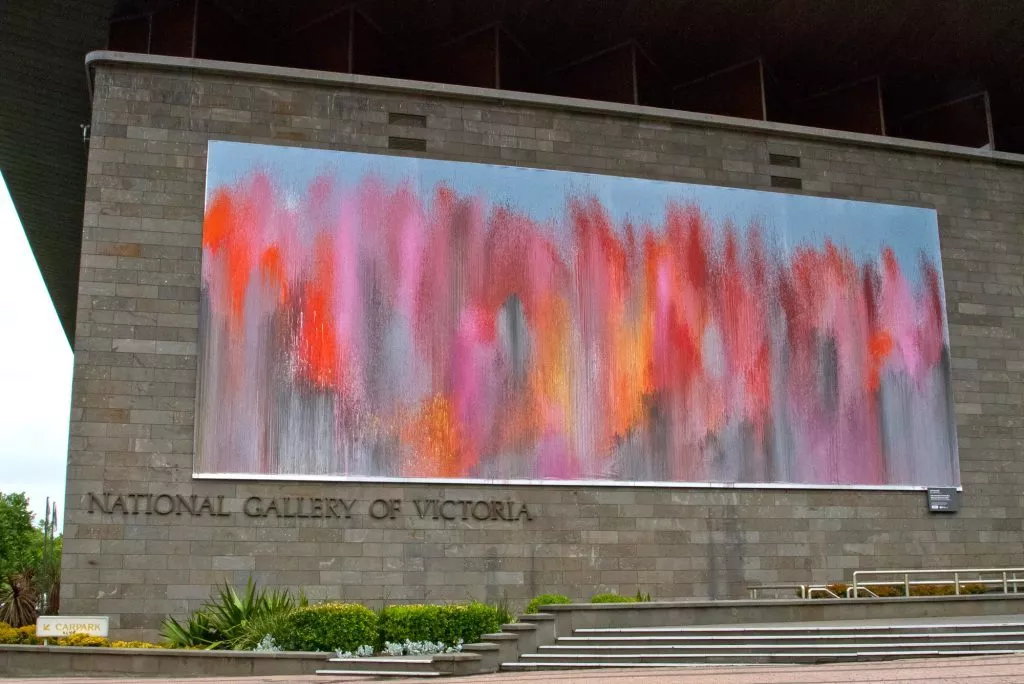
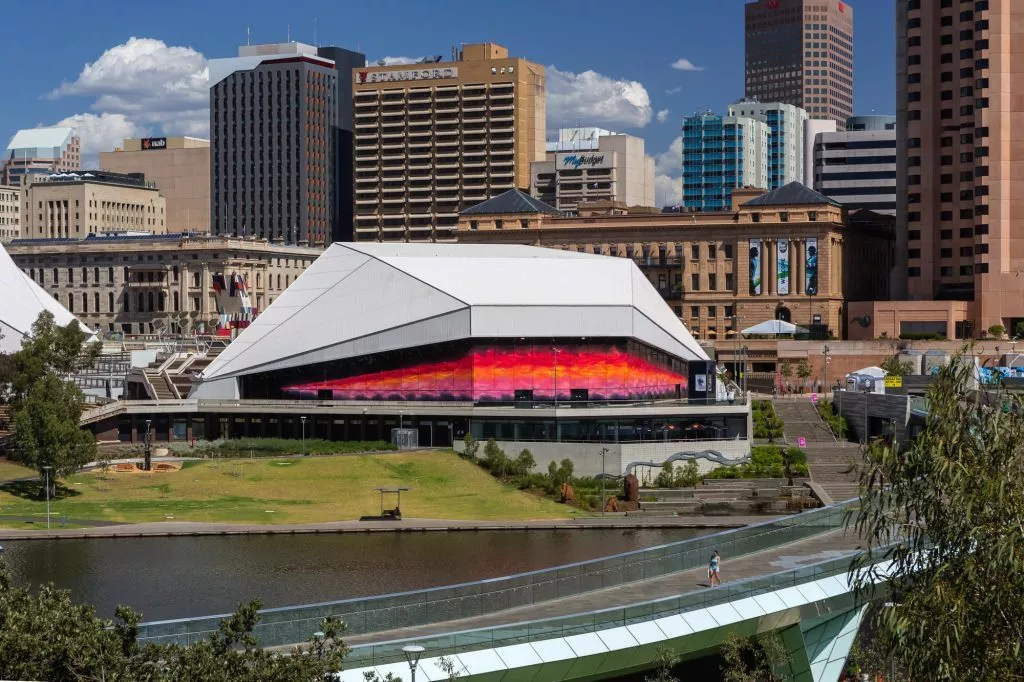
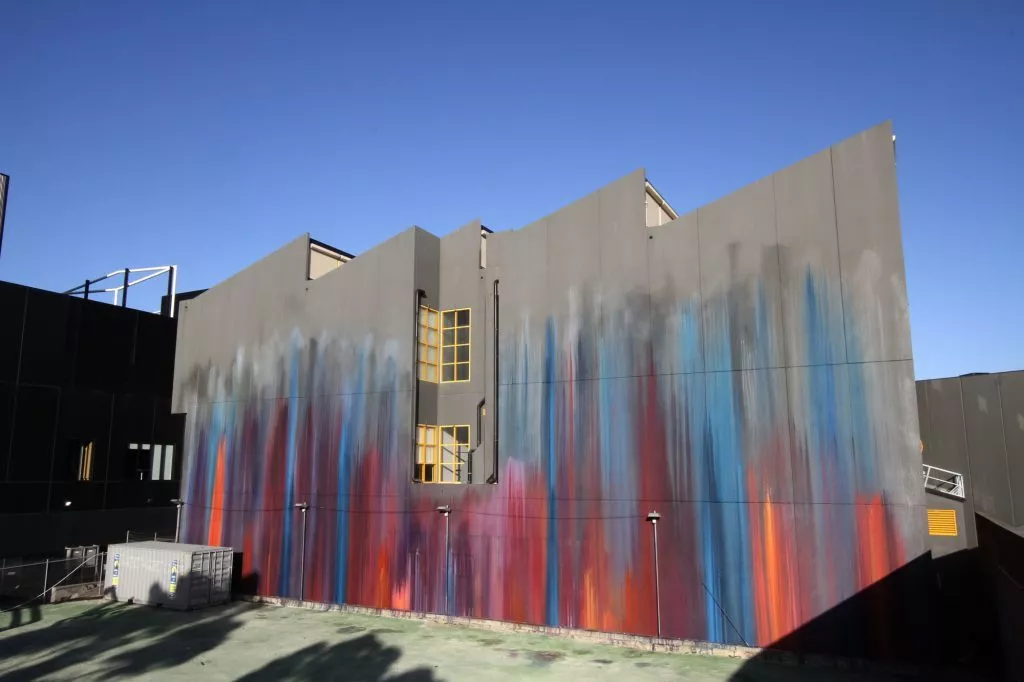
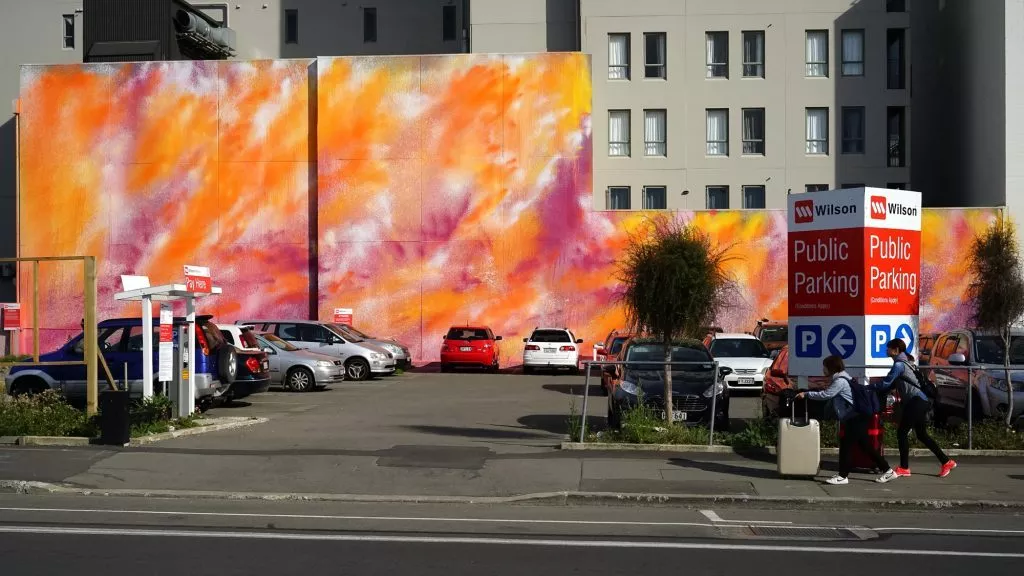
Depending on the projects, the artist works more with the verticality of the natural process due to the technique and gravity or avoids it when he created sort of „landscape camouflage paintings“ on warehouses in the countryside. Those freestanding architectures, perfect to be seen by far away, with their industrial walls are especially attractive to the Australian painter. His first big project on this kind of architecture was the „West Park Proposition“ in 2012, in Truganina, on the industrial fringes of Melbourne. This work was conceived as a multi-screen video installation, documenting an endurance guerilla-style action painting intervention and merging his actions in urban space of his beginnings, his ecological conceptual projects and his actual painting. Using fire extinguishers and throwing paint at the walls like he used to do in his beginnings in public space, the video installation presents a ritualized painting performance in which a symbolic violence is enacted against a storehouse symbolizing consumption. By transforming a building on ten by fifty meters through a camouflage painting, incorporating it into the surrounding landscape with the same colors and its atmosphere, it makes it disappear in a way and can be seen as an extension of the ambient scenery. As a symbolic form of environmental activism, the work puts the attention on the landscape, on the beauty of the colors, the romantic feel and invites for contemplation. The building is transformed into a huge canvas for an impressionist painting, a poetic reclaiming of the natural farm landscape and therefore also a statement. „From 2012 to 2016 I undertook a series of trompe-l’oeil paintings titled ‘Urban Boundary Propositions’ on similar buildings across Melbourne’s greater urban growth boundary. These works were conceptual, painted for film, and literal in their message about the loss and development of natural landscape“, he writes in the introduction of his exhibition catalogue „Hume Response Paintings“ in 2019, an exhibition with studio works that followed a large mural on a warehouse with the same title created in 2019.
Since 2012 Keating accomplishes numerous remarkable large-scale painting commissions in public spaces, not only in rural areas, but also in urban space for institutions and festivals such as the National Gallery of Victoria (2013), the RMIT University (2014), the Adelaide Festival Centre (2015), The Sugar Mountain (2015/16) and Splendour in the Grass Festivals (2016/18), TarraWarra Museum of Art (2019) and most recently painting directly on the façade of the Warrnambool Art Gallery (2021).
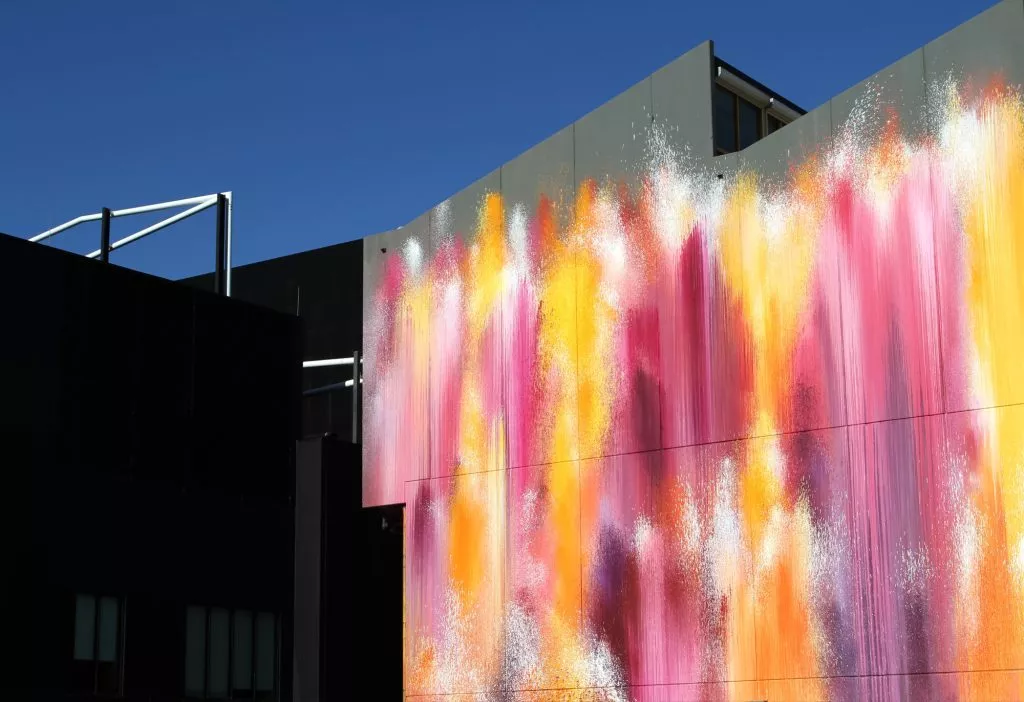
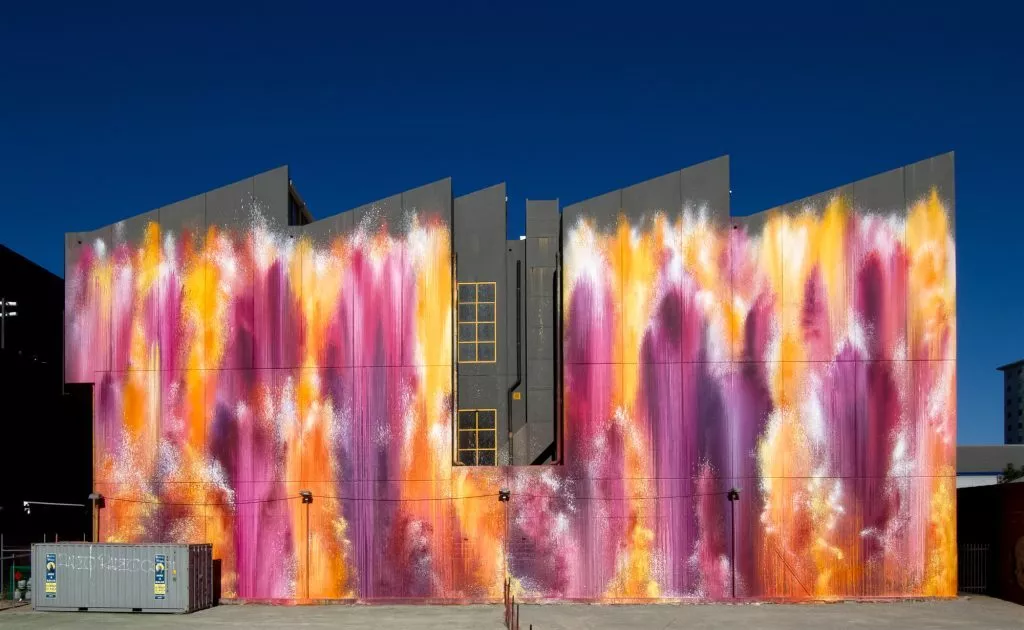
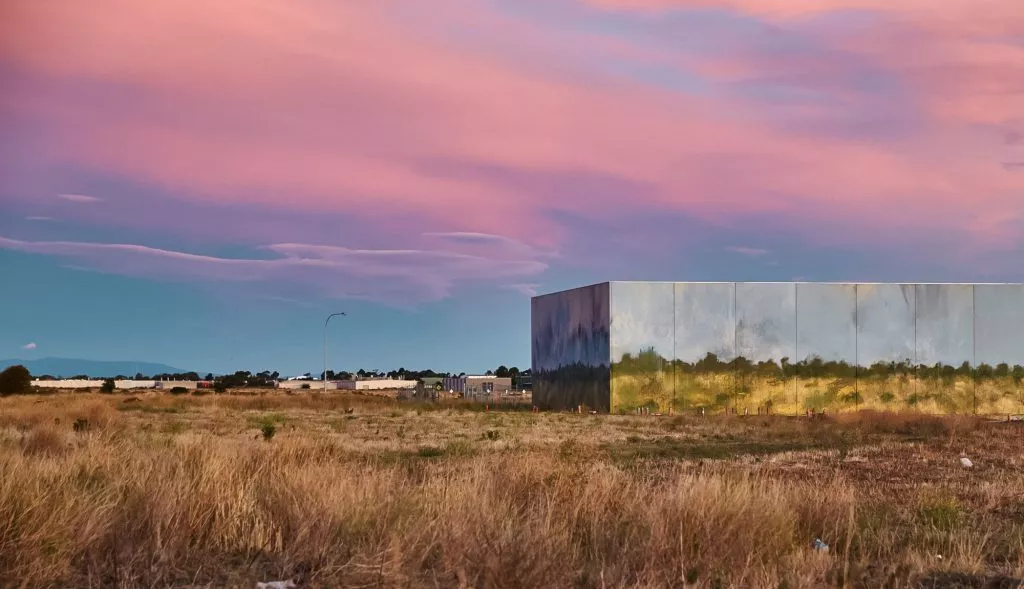
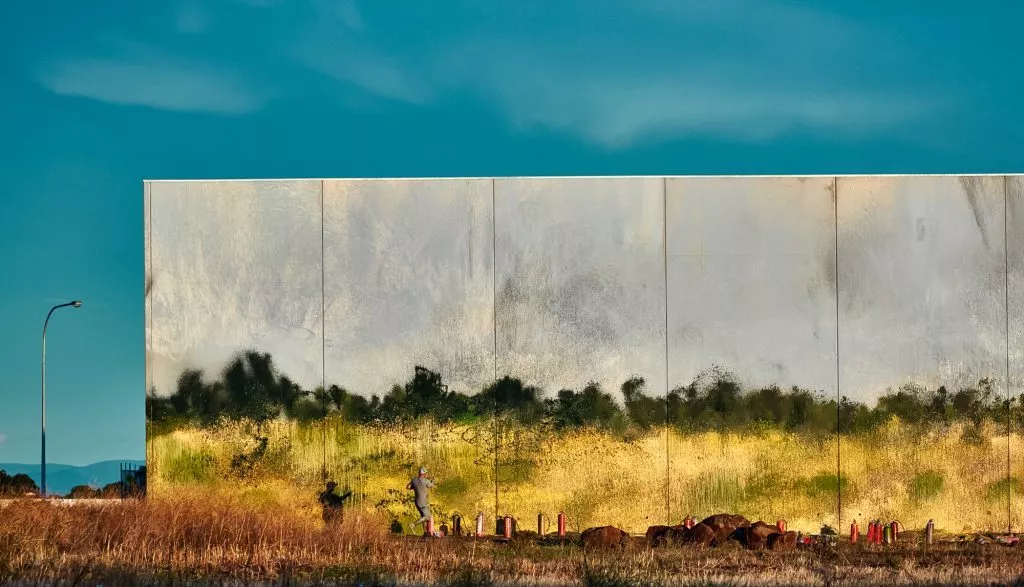
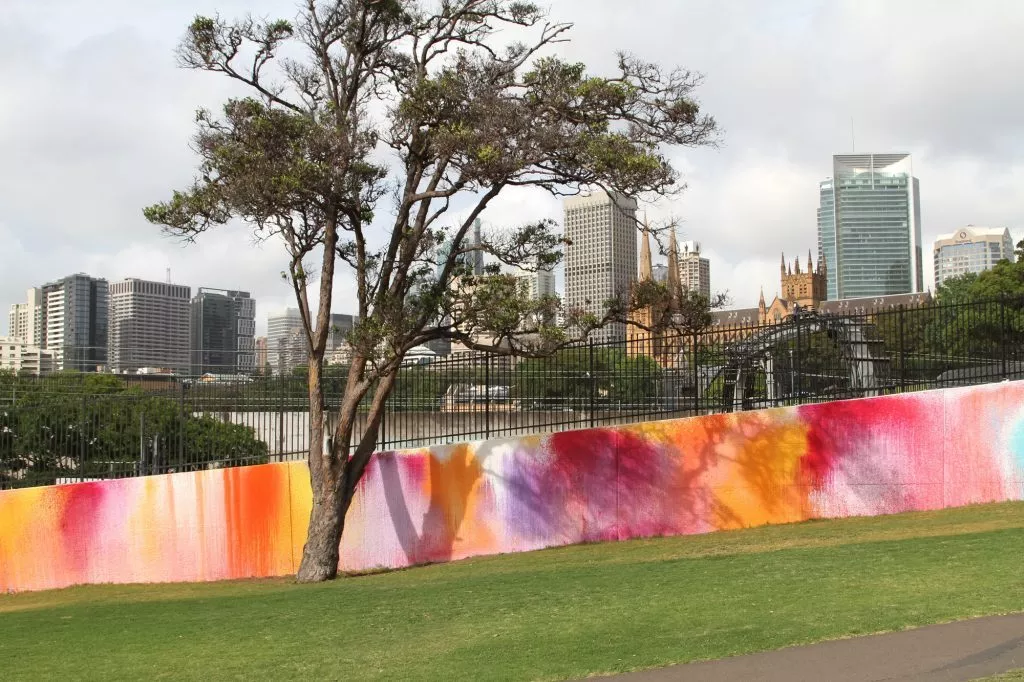
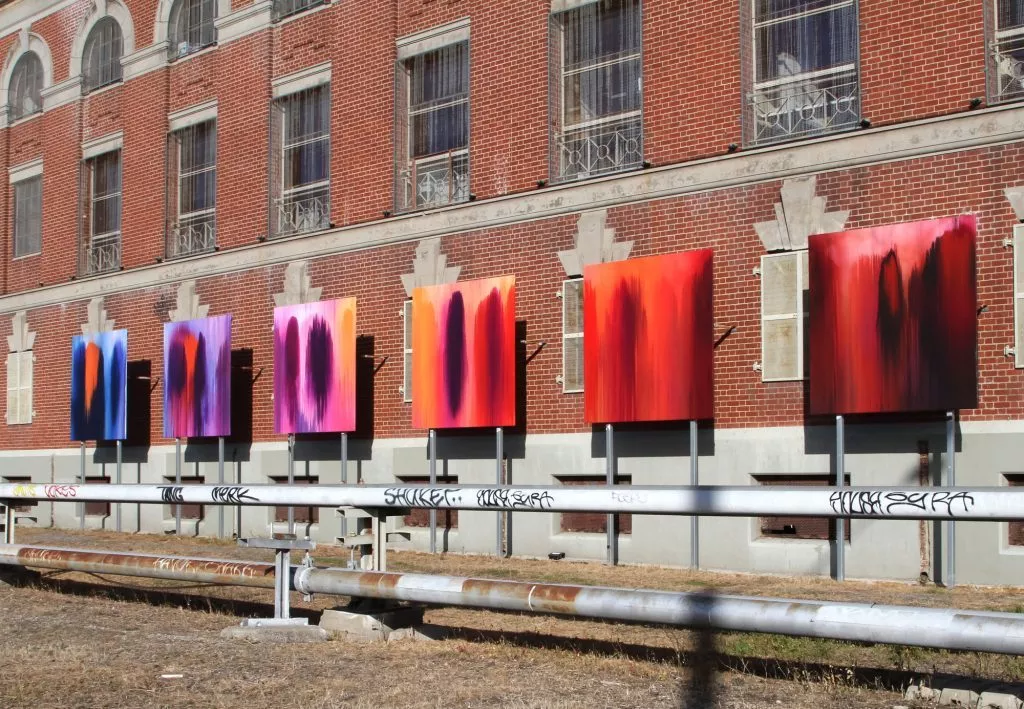
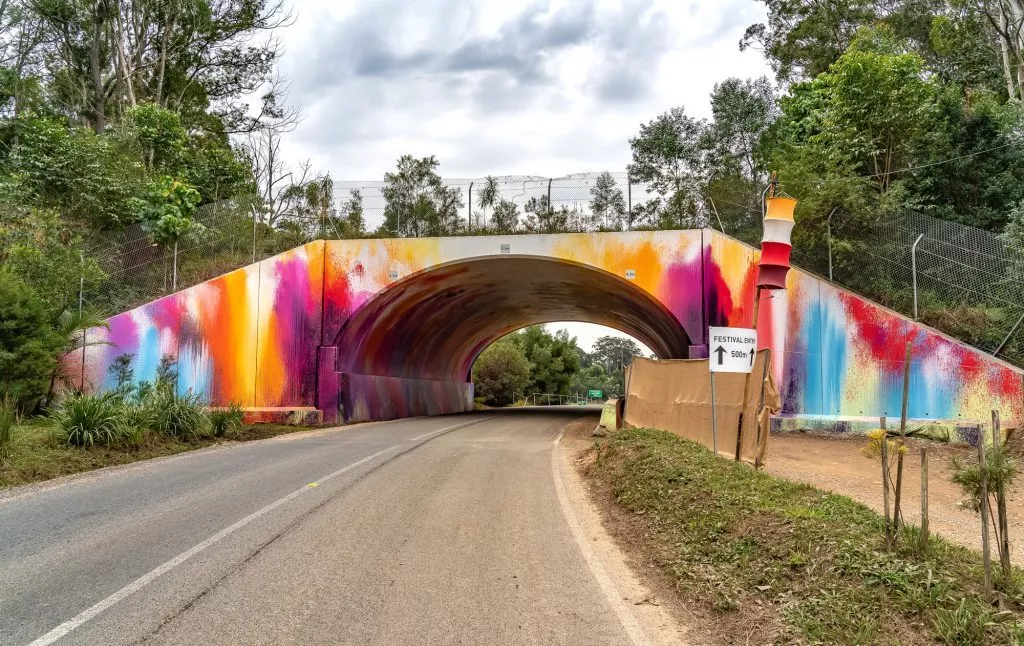
Working methods
Painting on different architectures, like bridges, various modern buildings, facades, playgrounds or indoor commissions, the preparation for those works is considerable and takes at least two weeks time. Visiting the location for deciding the color palette is the first step, depending on the surroundings, even in urban space the artist makes a link to the cultural environment like for his work in Chinatown in 2020, celebrating the colors red and yellow, or using bright positive colors for the facade design in the context of a music festival. Examining the architecture to decide how to compose and where to apply the color, where exactly to stand for applying the pressurized beam is the second step. Sometime he needs a ladder, for taller walls a lift. Then Keating needs to prepare his tools in advance, for all of his fire extinguishers he will need for an art work, he needs to mix the colors, specify and add the pressure and prepare the location around the walls. Cleaning the water-based paint and water on the floor and surroundings after the painting act is a big part of the whole act as well. The act of painting itself in situ takes approx. four to eight hours depending on the weather conditions that special day of execution. The concentration during the painting process is very intense, the physical and weather conditions must be taken into account and accordingly leave room for improvisation. The key moment is the use of the added water on the layers of color to enhance the gravity movement and guide and thus partly control overlaps, blends, gradients and blurred outcomes. Sometimes applied on mainly all the surface, sometimes in rows of vertical shapes, reminding flames, the process itself is as spectacular as the outcome. Powerful and impressive, his works draw the eye, inviting one to contemplate the beauty of abstraction and color uniquely composed by the Australian artist.
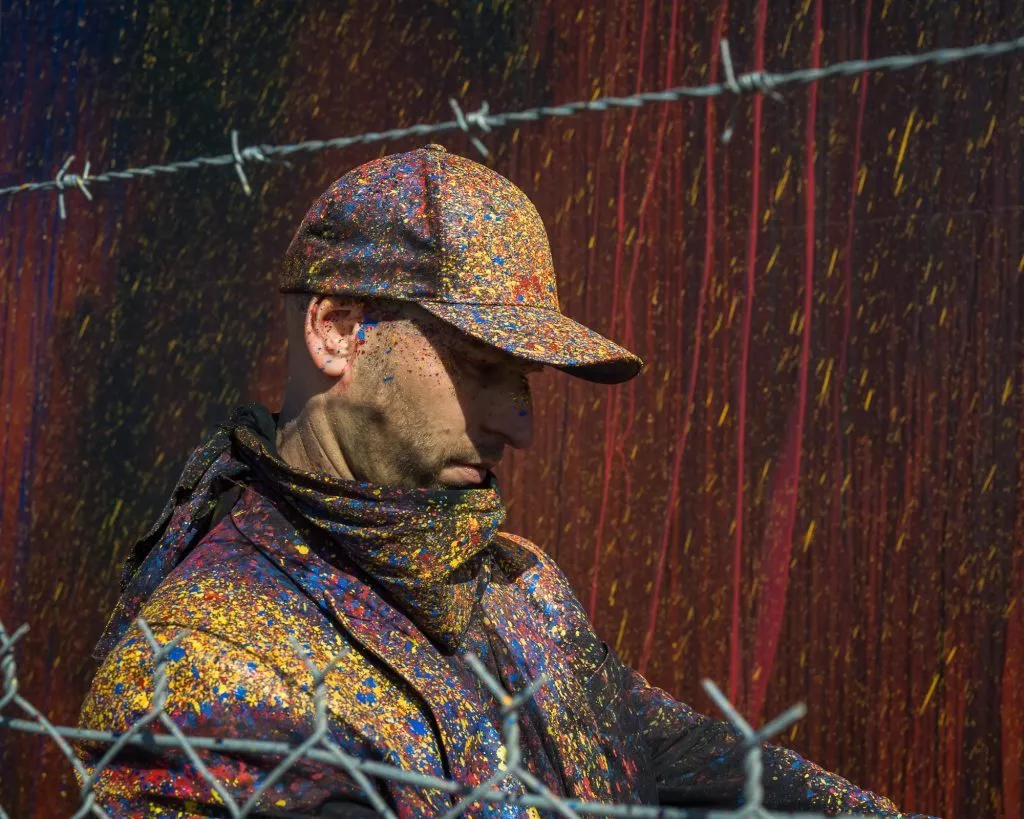
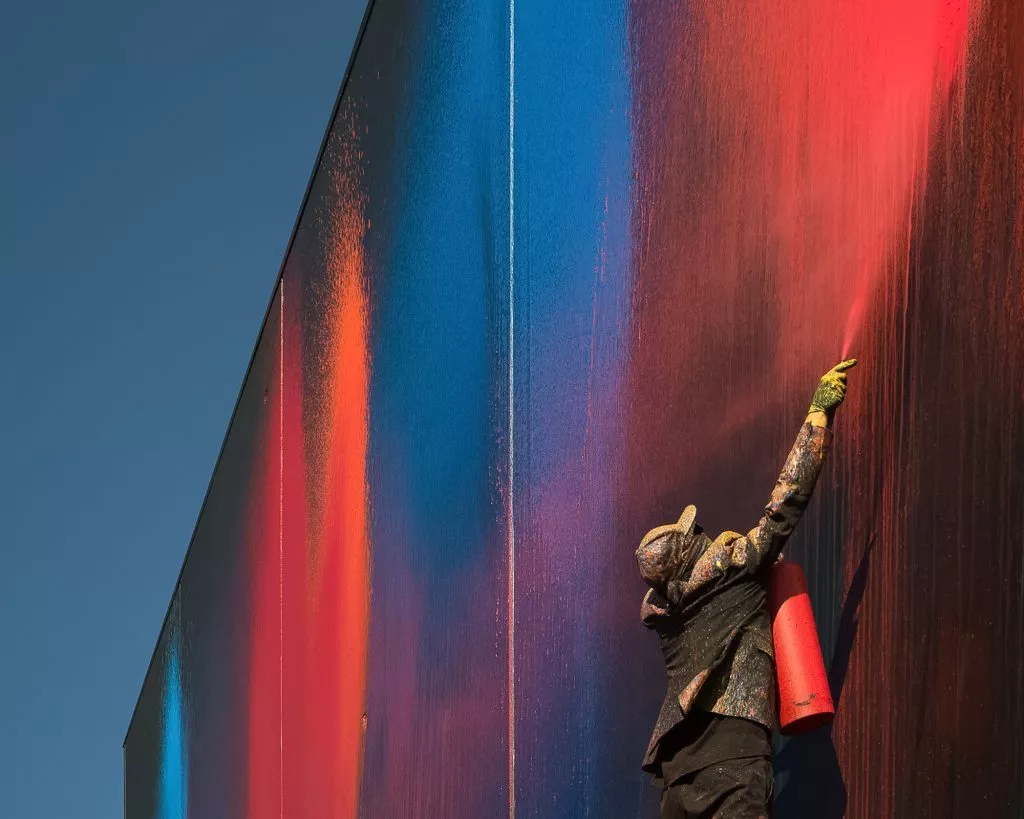
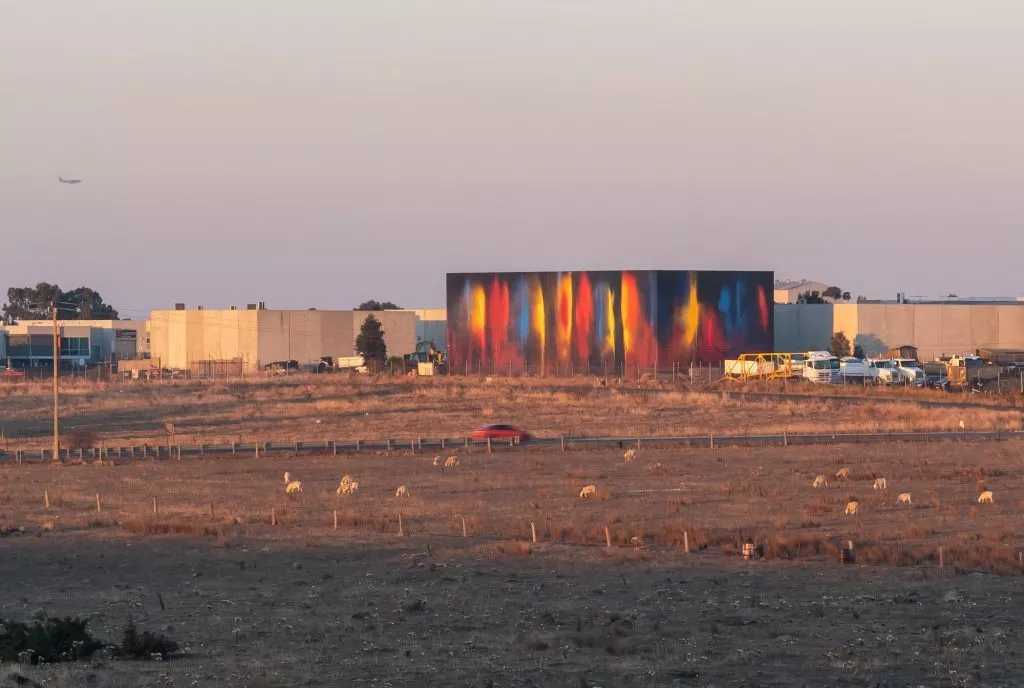
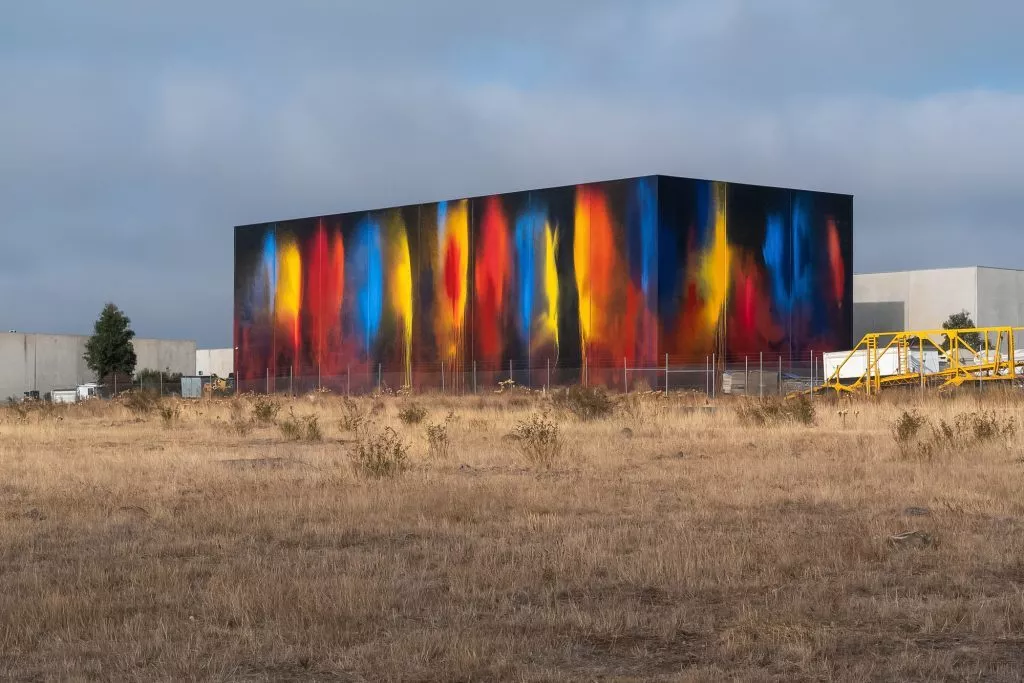
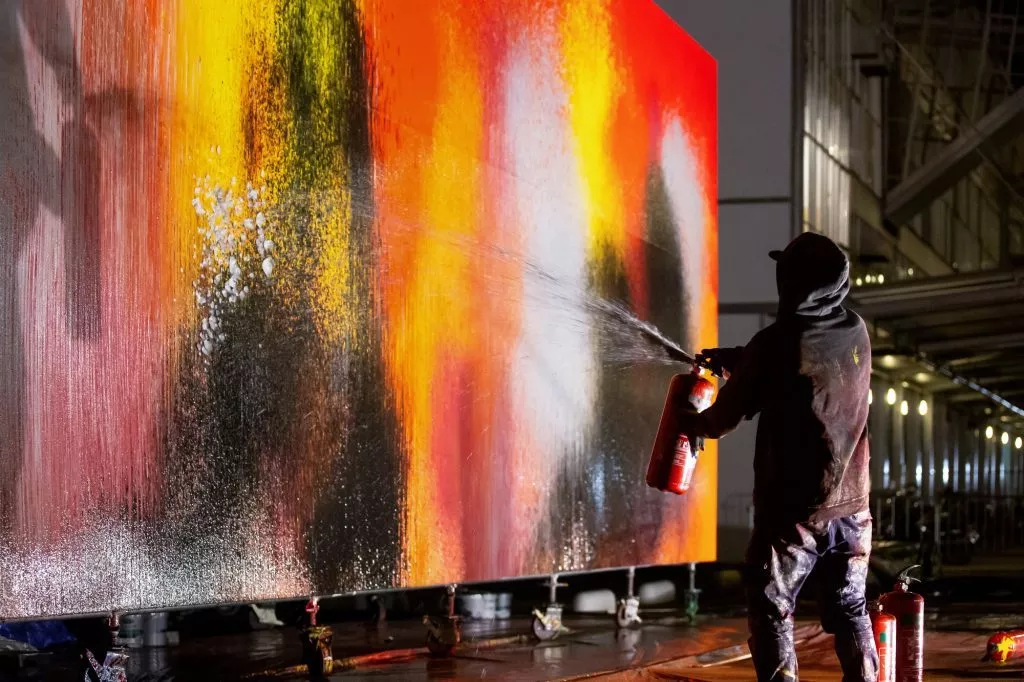
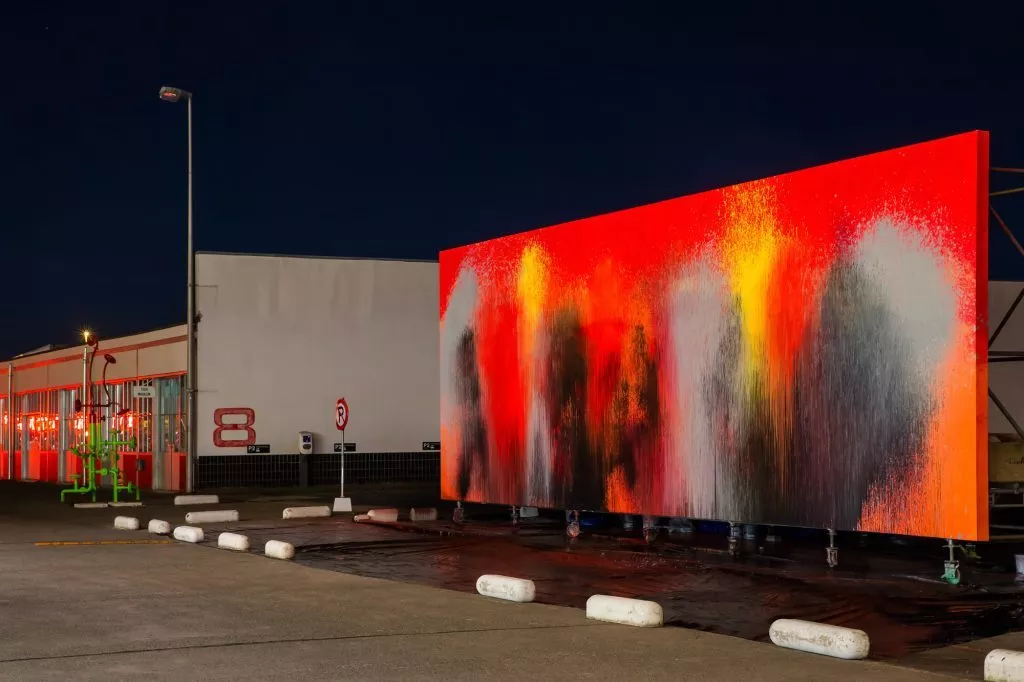
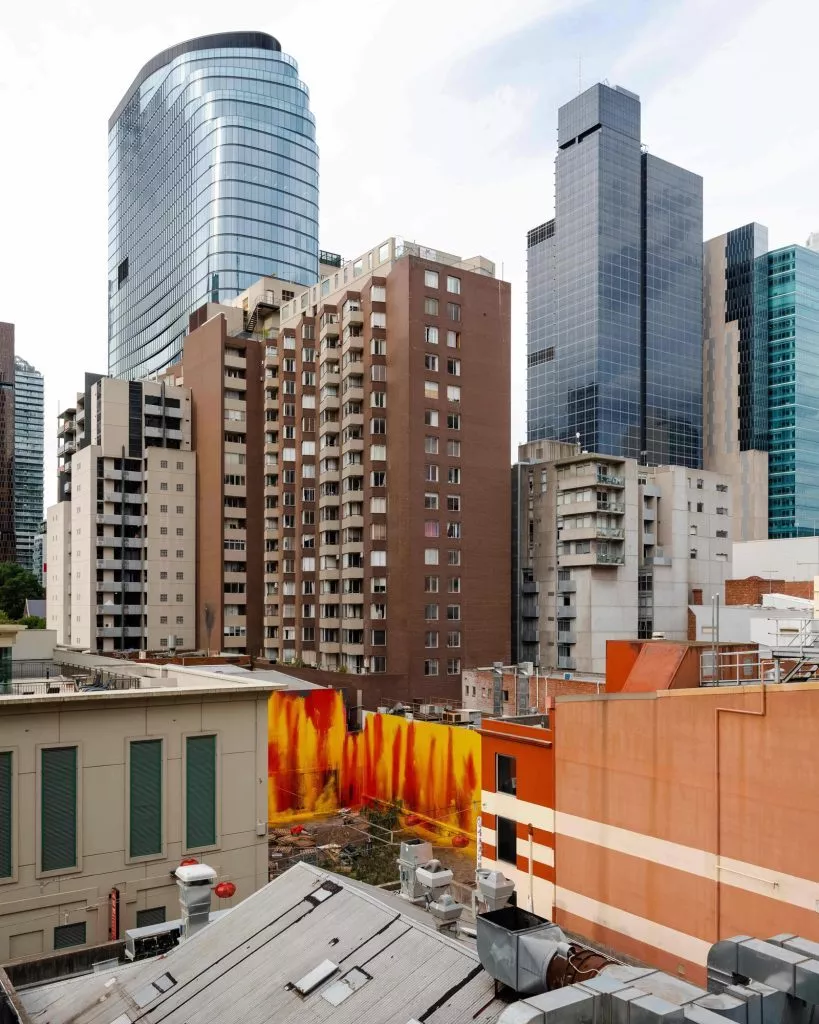
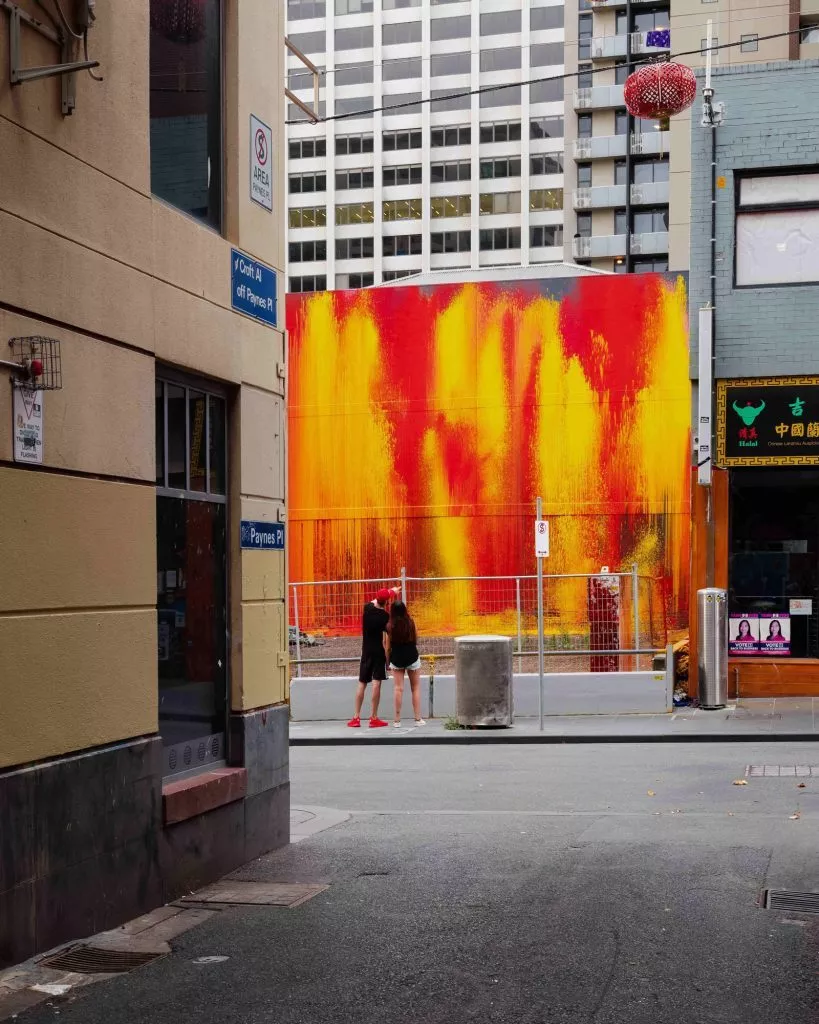
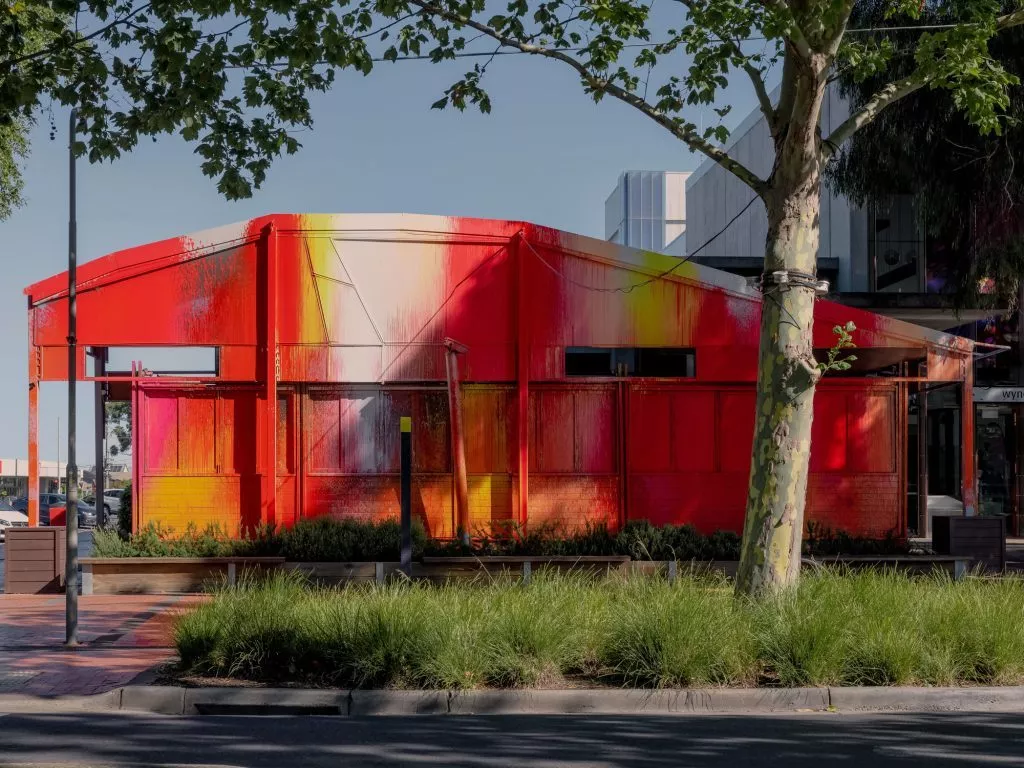
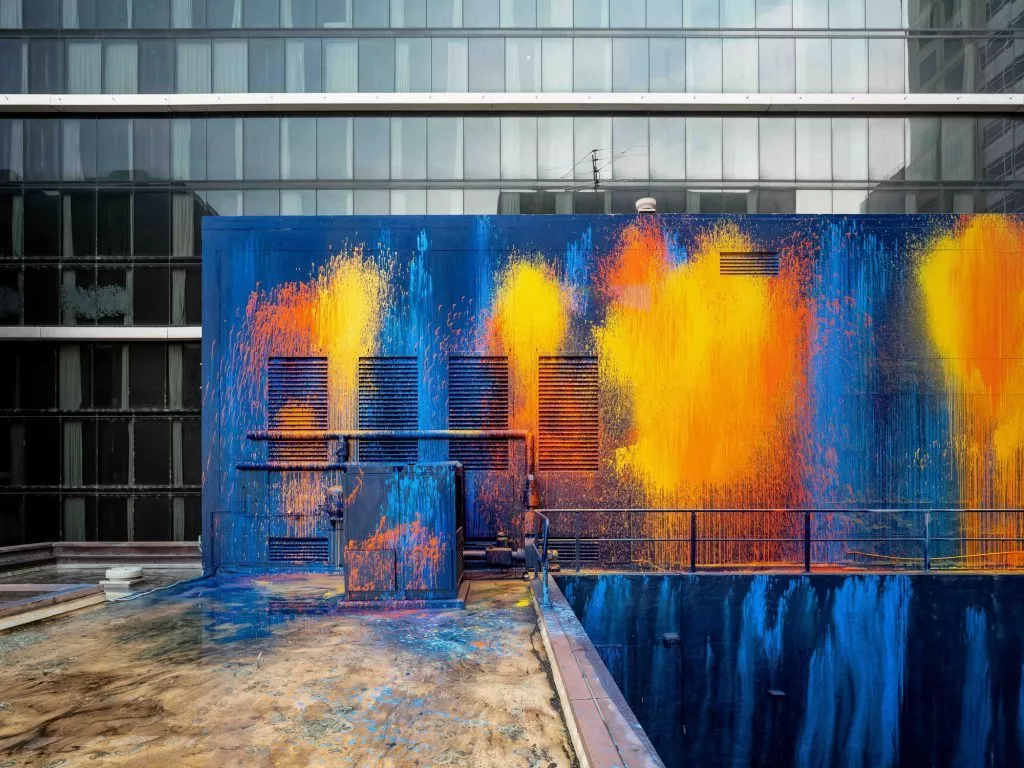
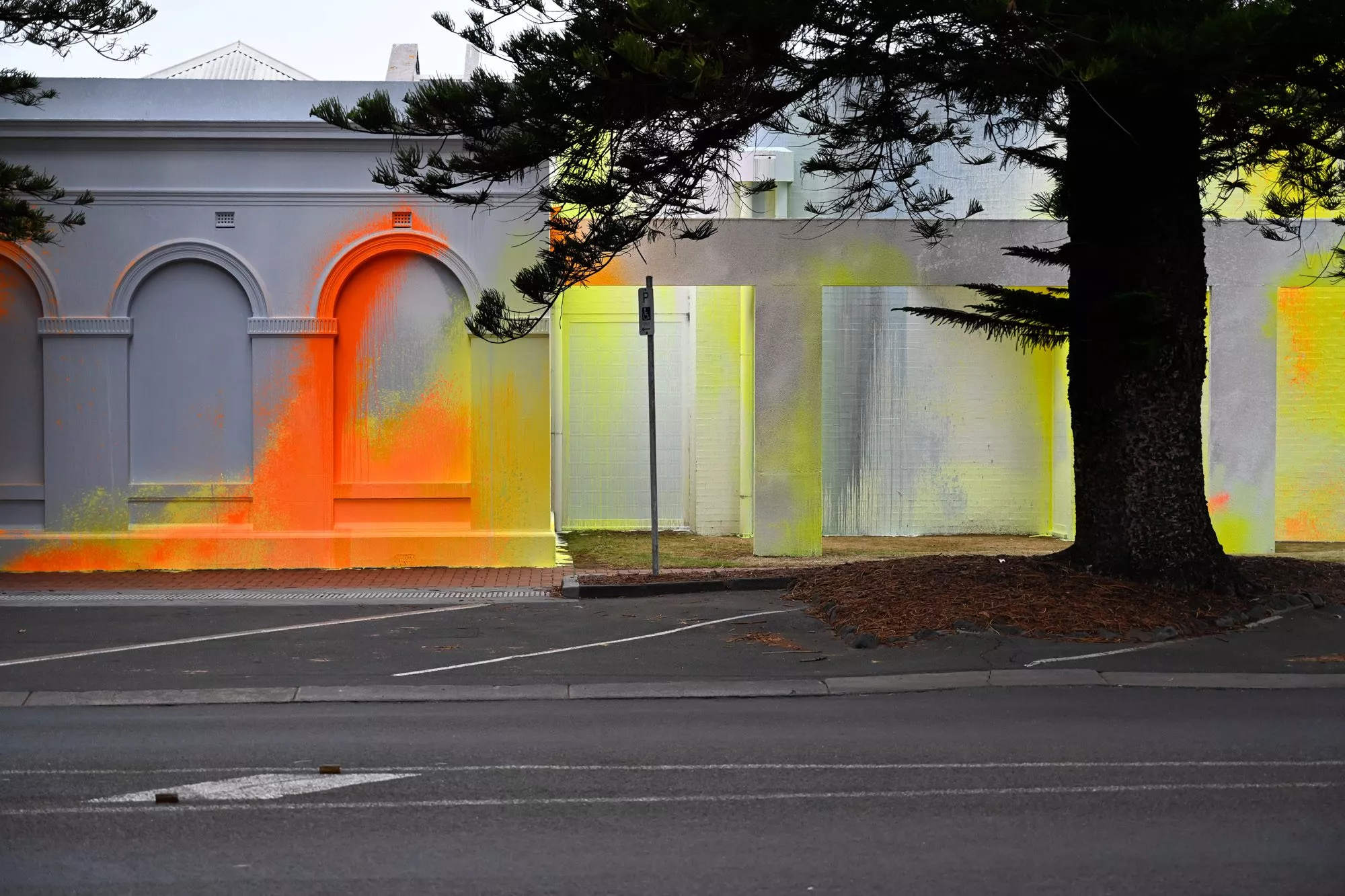
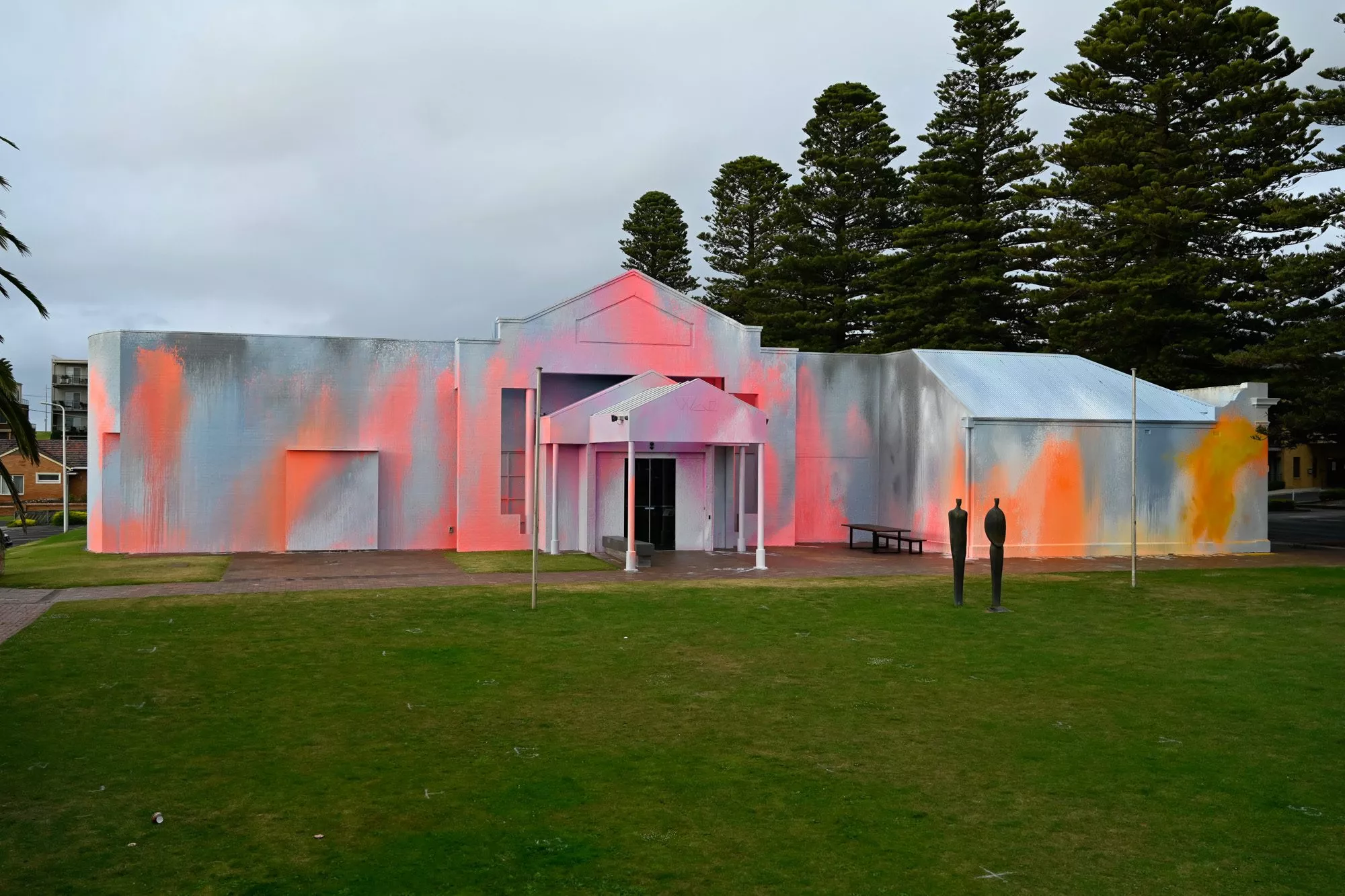
Studio practice
Over the past ten years Ash Keating has developed a special way for creating abstract atmospheric compositions outdoor and indoor. In his studio he applies paint to the canvas surface through an airless sprayer and then erases or breaks down areas of this paint through the application of water. “On large exterior walls I use acrylic house-paints and water applied with fire extinguishers, and within the studio working on linen, I use a spray gun, atomizing premium artist paints and water.“, he explains. In his studio, which is specifically designed to work with a lot of water and has a drainage system in the floor, he can work with a lot more water and experiment with different watercolors. He has more time to work on one single art piece, allowing layering with drying phases, working with less pressure with an airless sprayer or with fire extinguisher for bigger sizes, and experimenting new ways of spraying and so forth coloring. His smallest format is 90 cm by 60 cm, but Keating prefers bigger sizes indeed.
Over the years, his practice has evolved, but his process remains creative and open to new ideas, yet he has remained committed to his sources of inspiration: the nature with its colors and light games, natural phenomenons linked to science and the discipline of painting. Concerning his solo exhibition „Hume Response Paintings“ in 2019, following the public work with the same title on a warehouse in 2019, he writes in the introduction of the catalogue: „In one sense this project can be read as the point at which my public art and studio practices converge through the macro-micro trope, which until now have been largely kept separate through scale, equipment and approach. In another sense these framed sections of the exterior work act as windows to the outer wall itself, as if the pigment has leached through the concrete; broken down, reconfigured and reinterpreted. Most importantly though is how this work is read under artificial light and without its surrounding landscape. There is neither a horizon in view nor a landmark to imply scale. What in fact happens when the monumental becomes intimate?“
Since 2020, during the pandemic, Ash develops new texturing for his canvas, he exhibited at Linden New Art Gallery in 2021 with a new series expanding the physical and psychological complexity of his work.„However, in 2020 I decided to use the strange year and lockdowns as an opportunity to experiment with textures and mark-making, which I had long been hoping to find time to explore.”, he says.
Ash Keating is always looking for new ways to develop his art and to be surprised again and again by the out coming results. „If anyone out there wants to fund something that they have no idea what the outcome will be, please come to me. That is the dream, and the results are far more exciting than pointing me back to somewhere I have already been.”
The text was co-authored with Ash Keating.

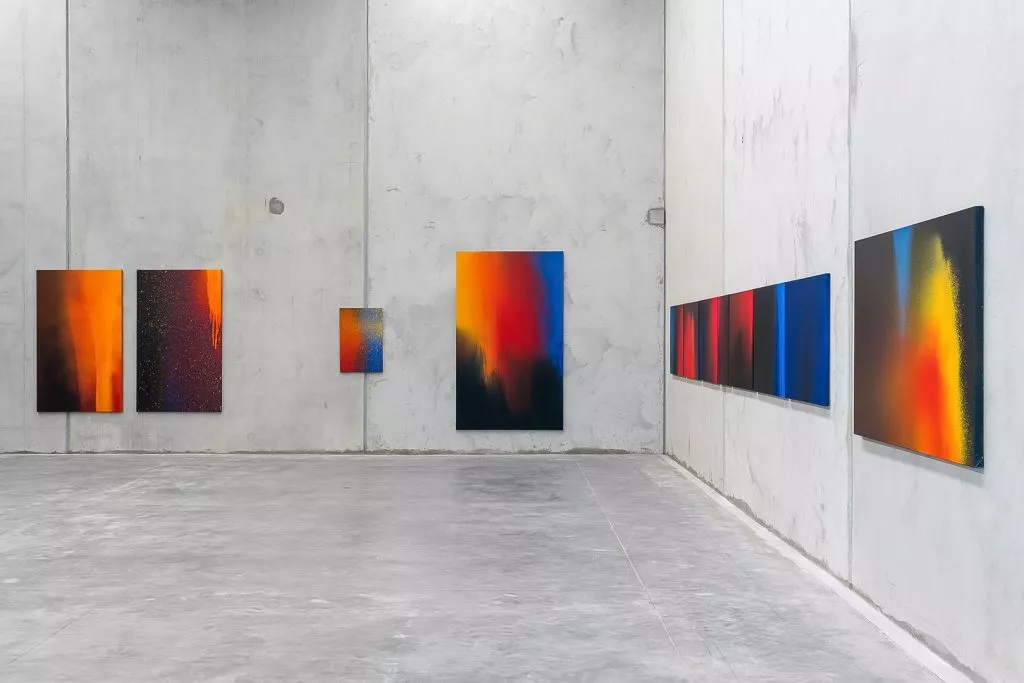
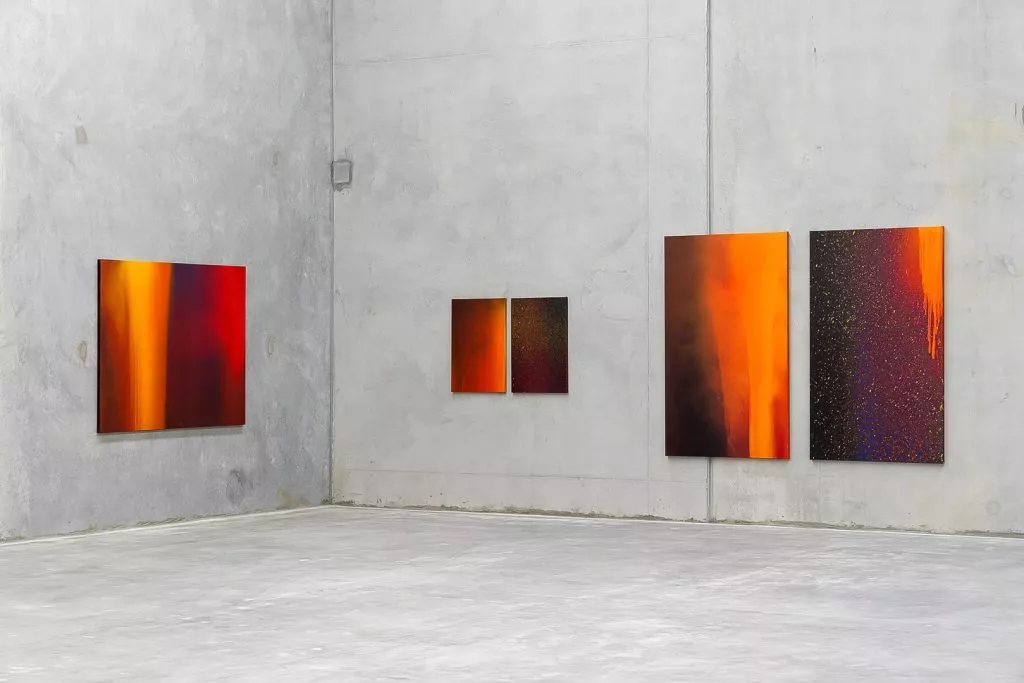
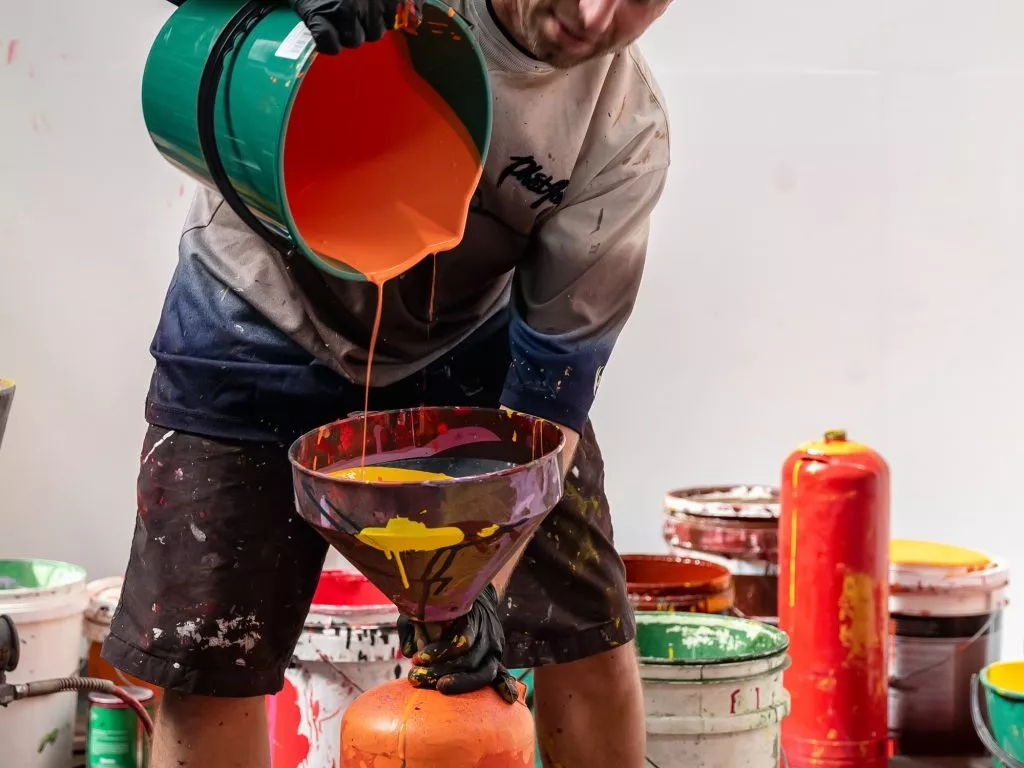
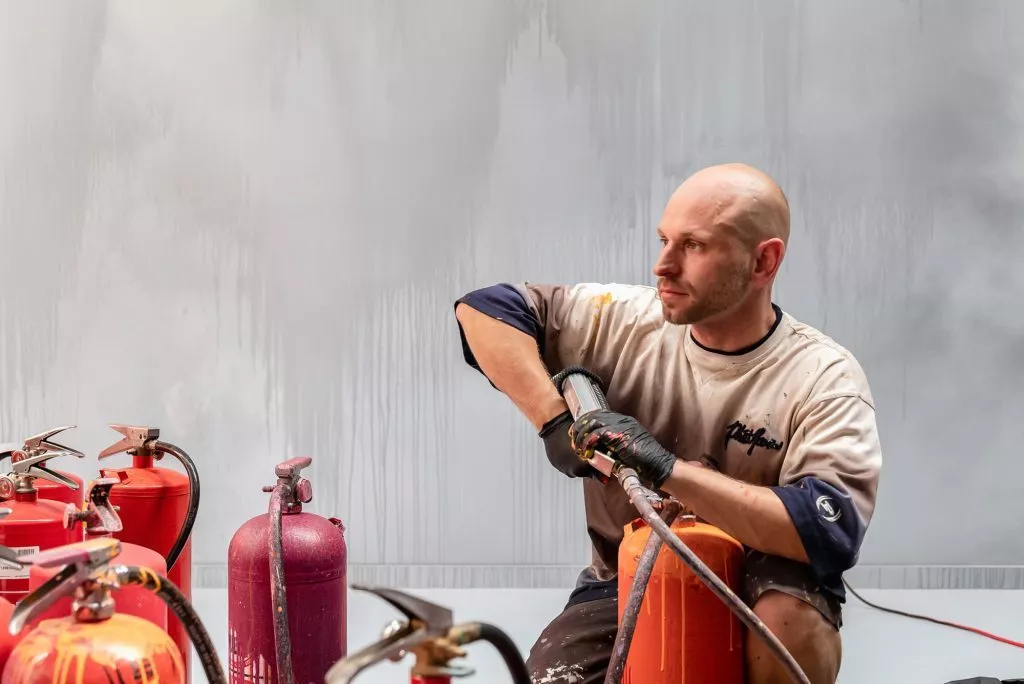
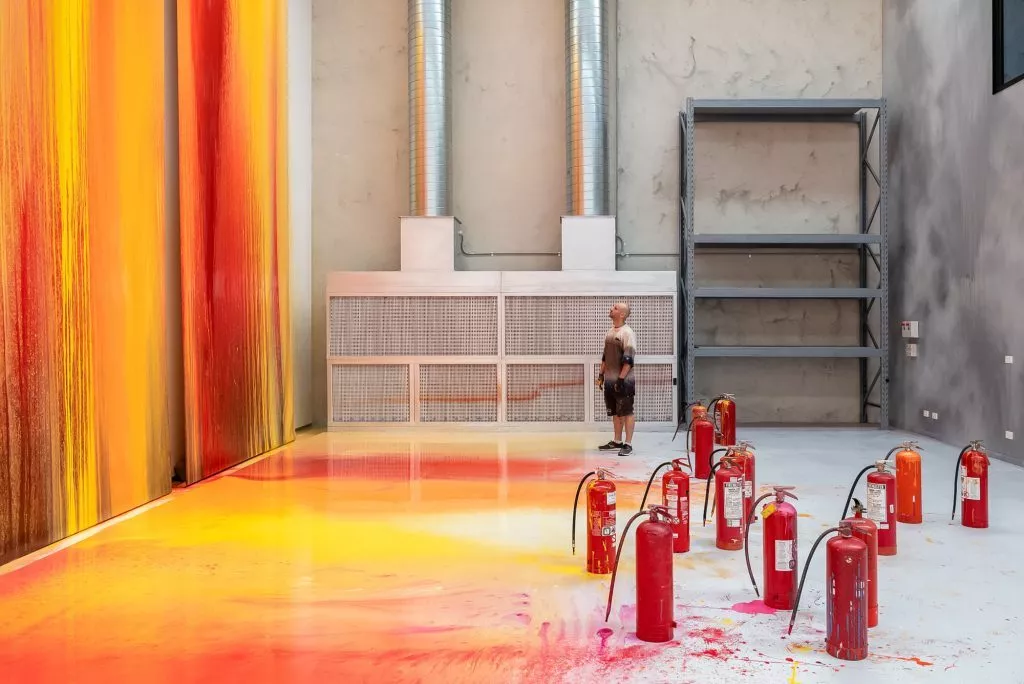
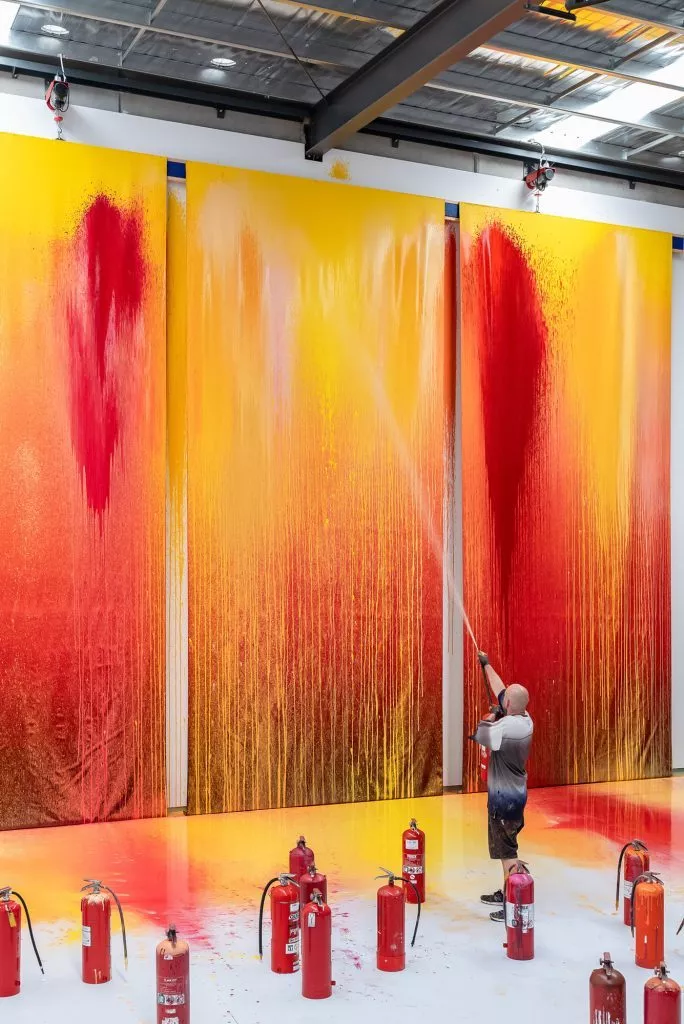
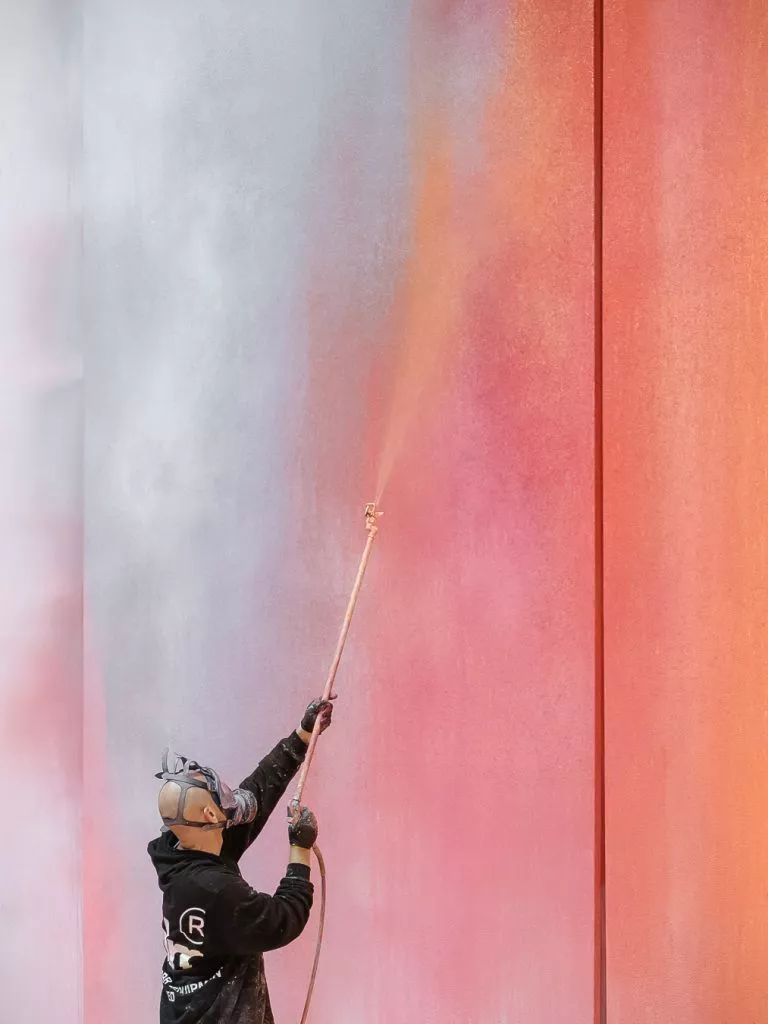
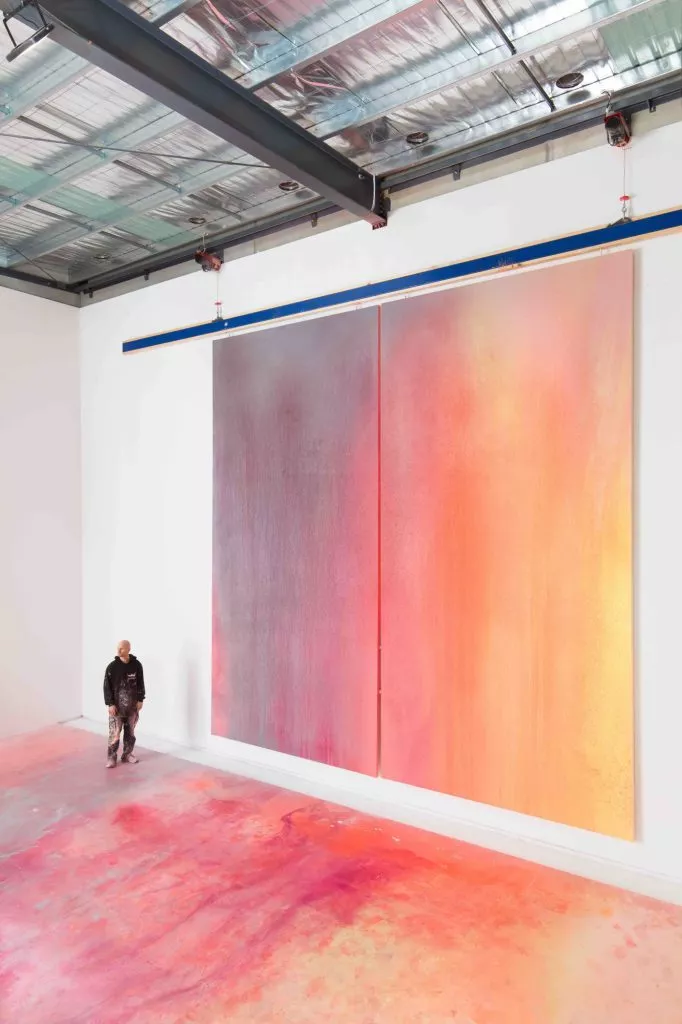
1,098 views
Categories
Tags:

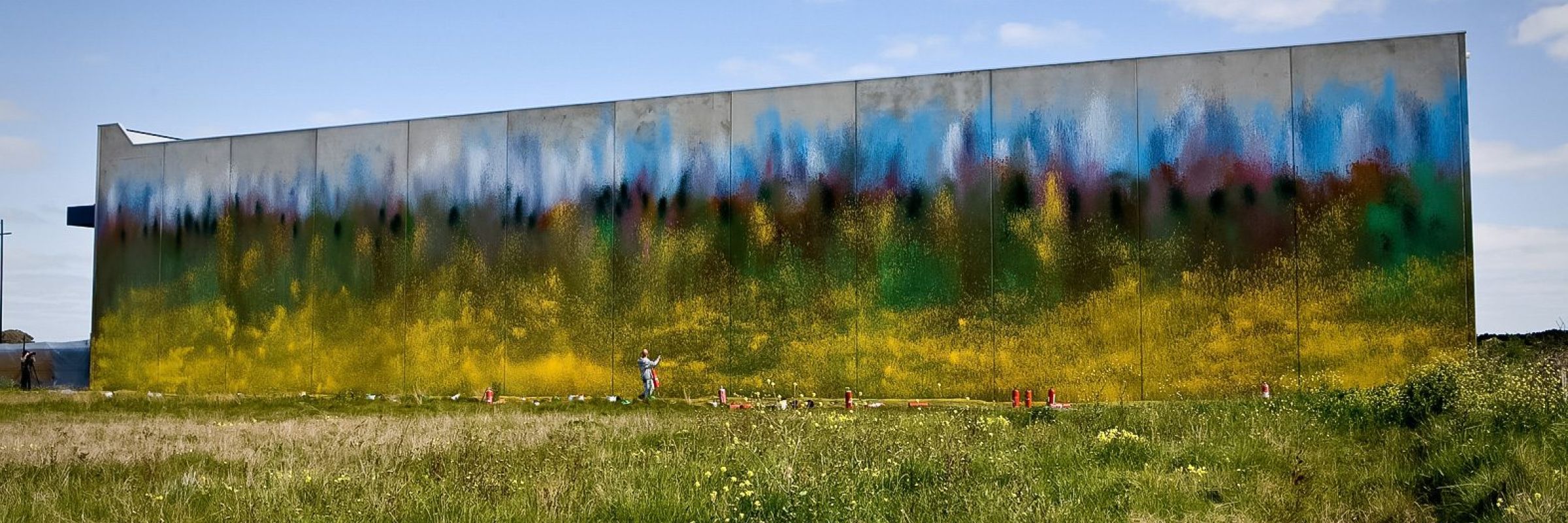

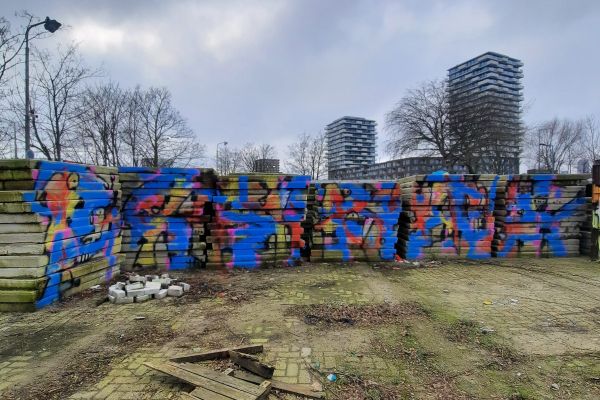
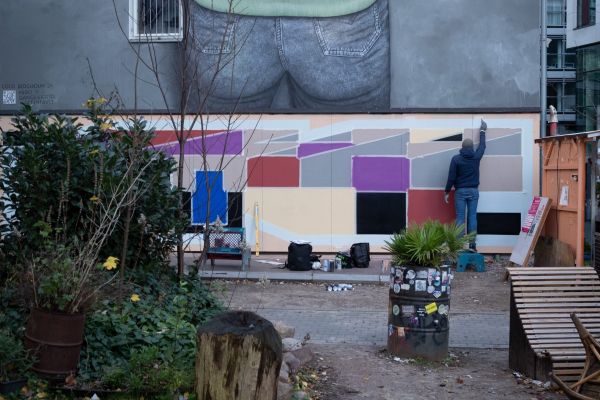
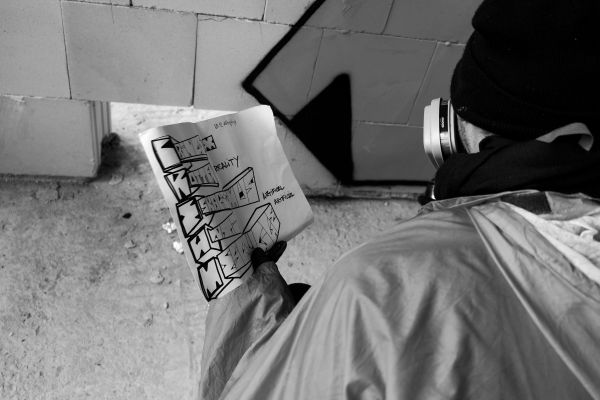
Leave a Reply